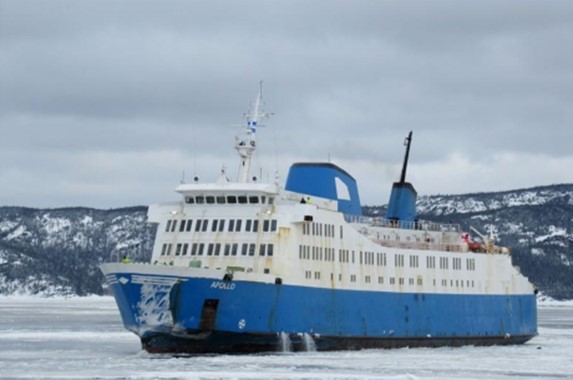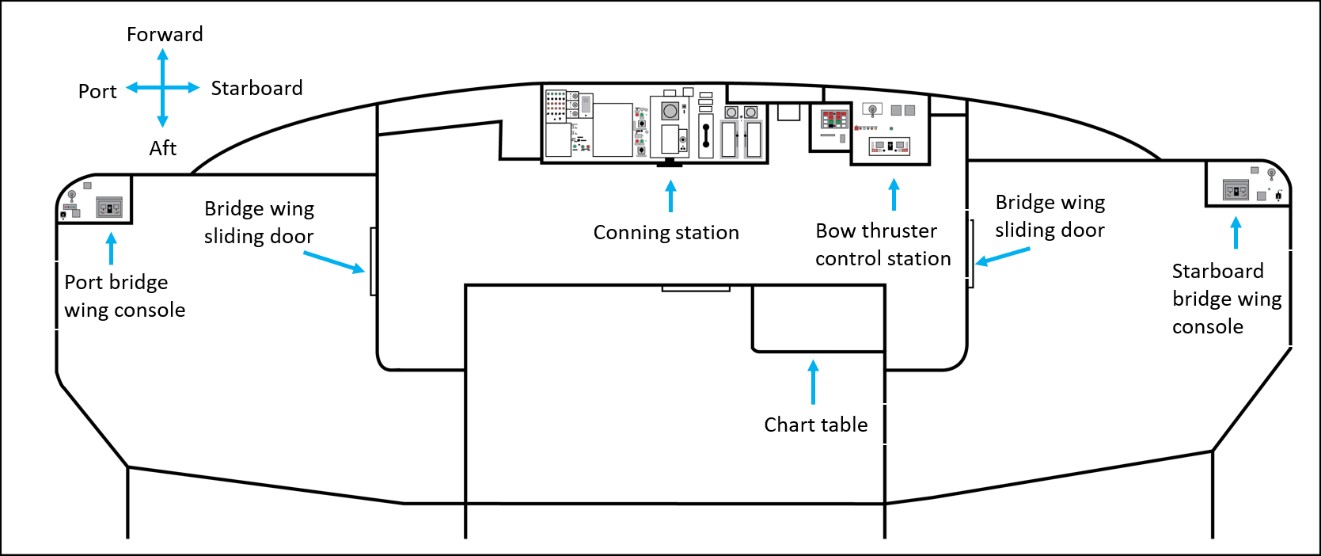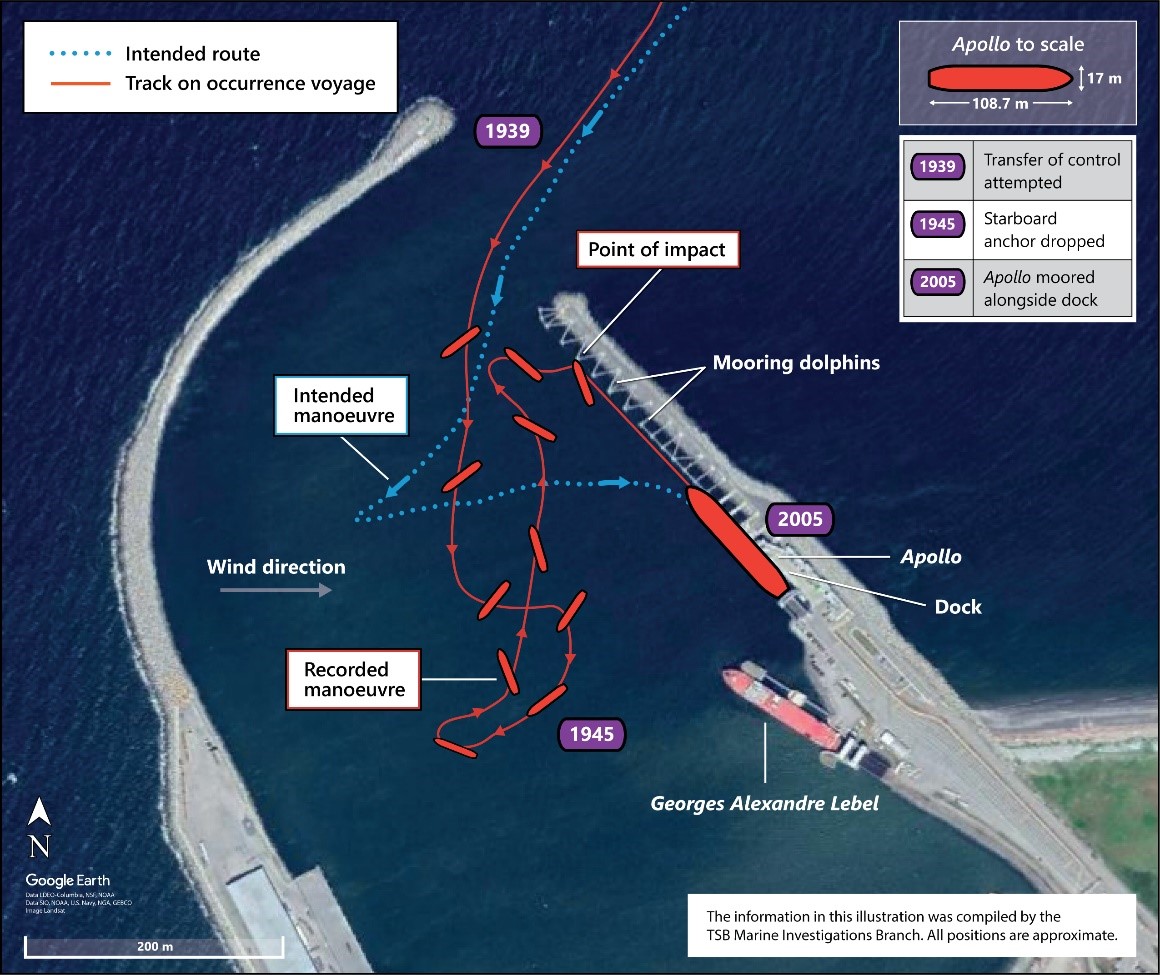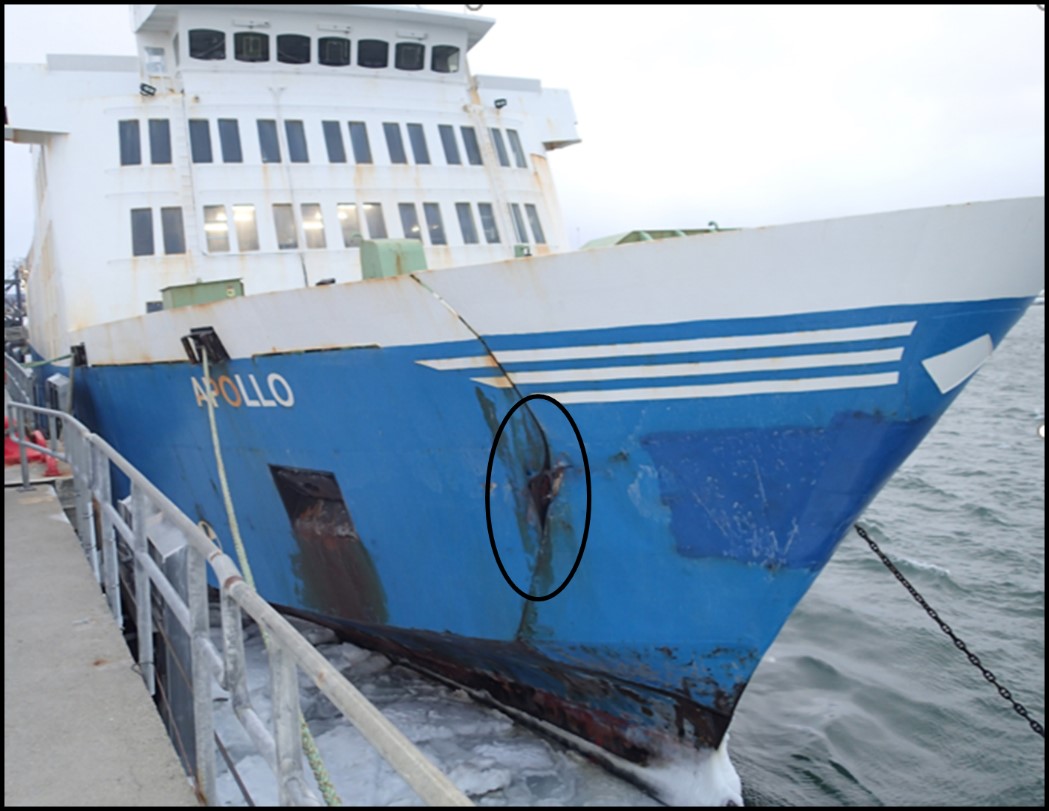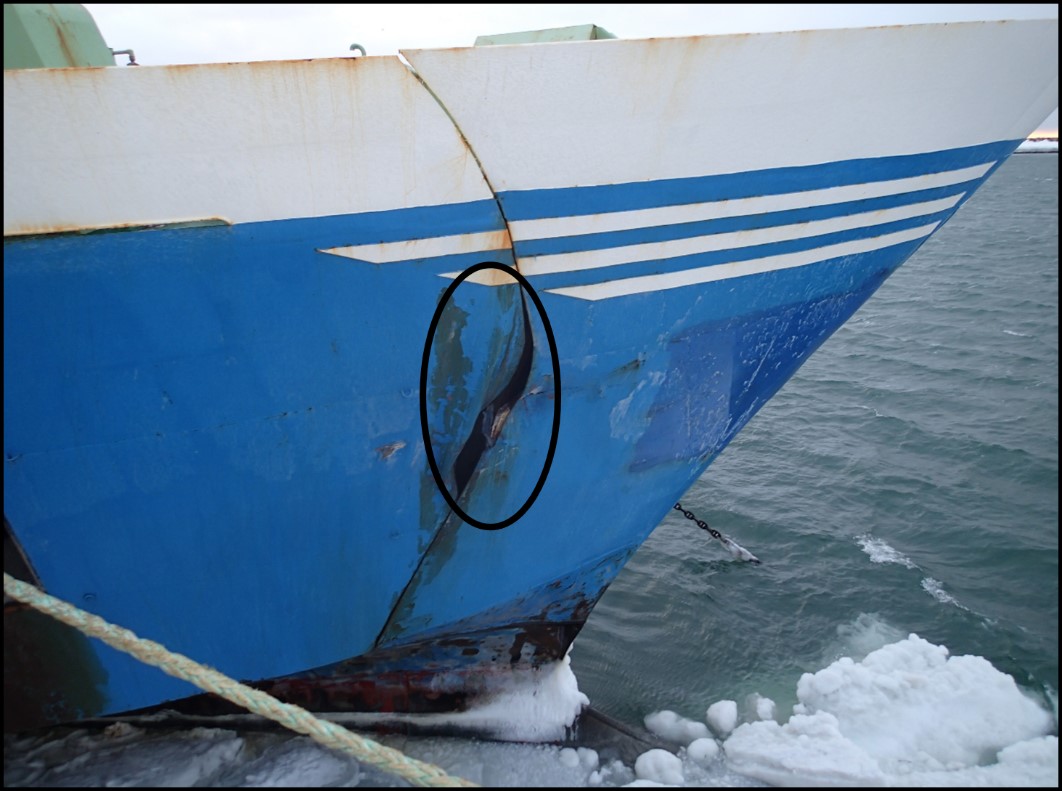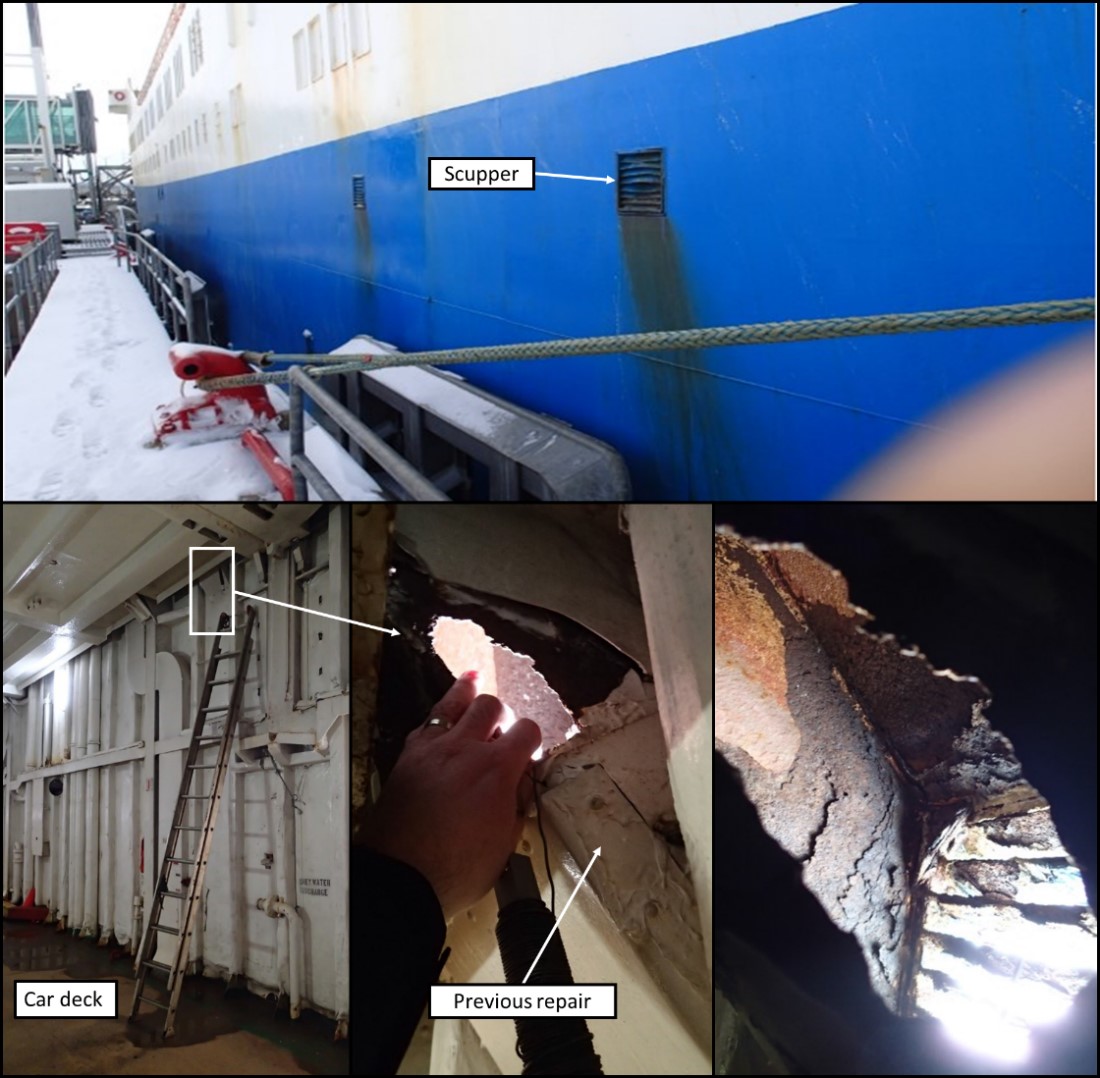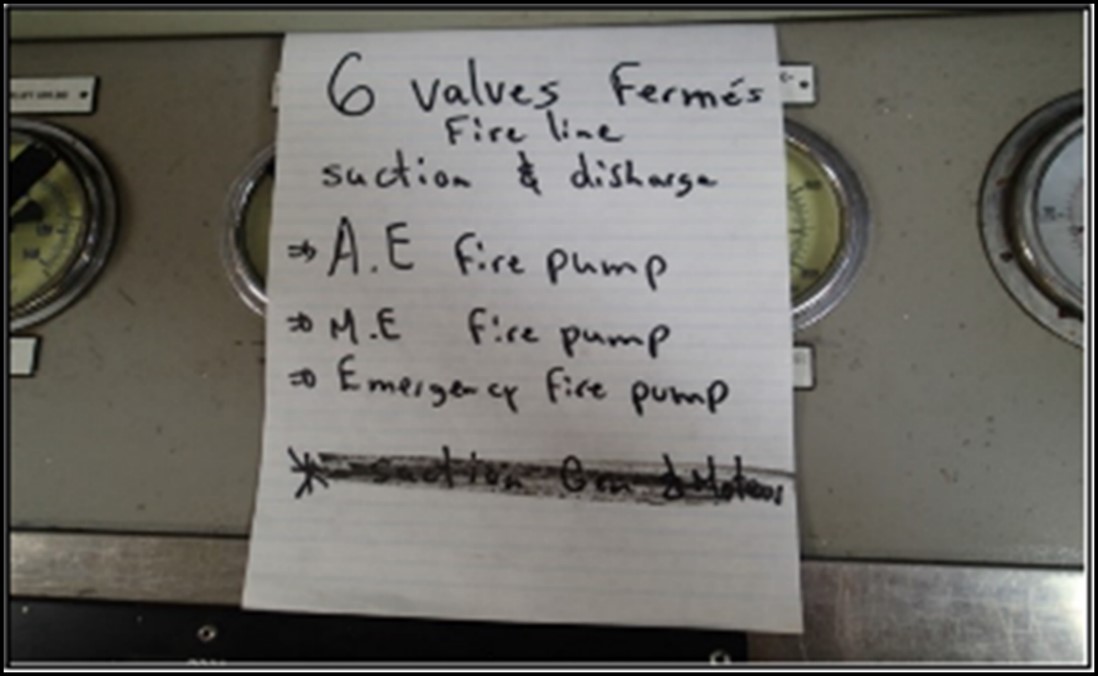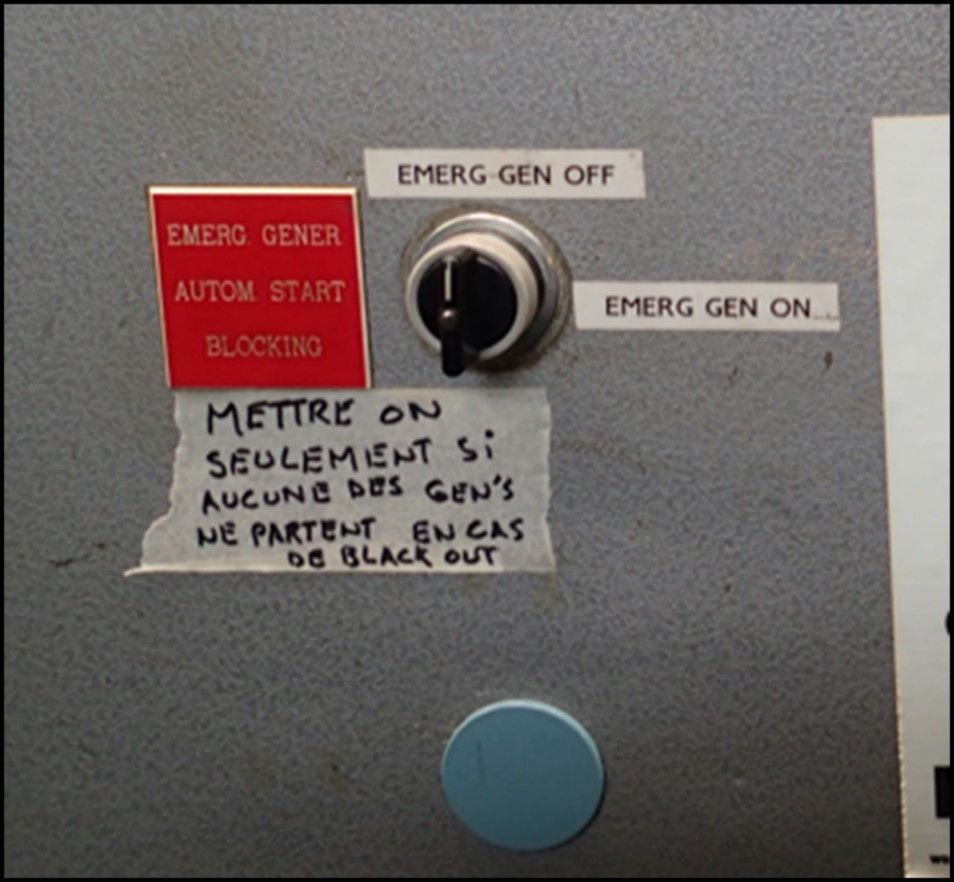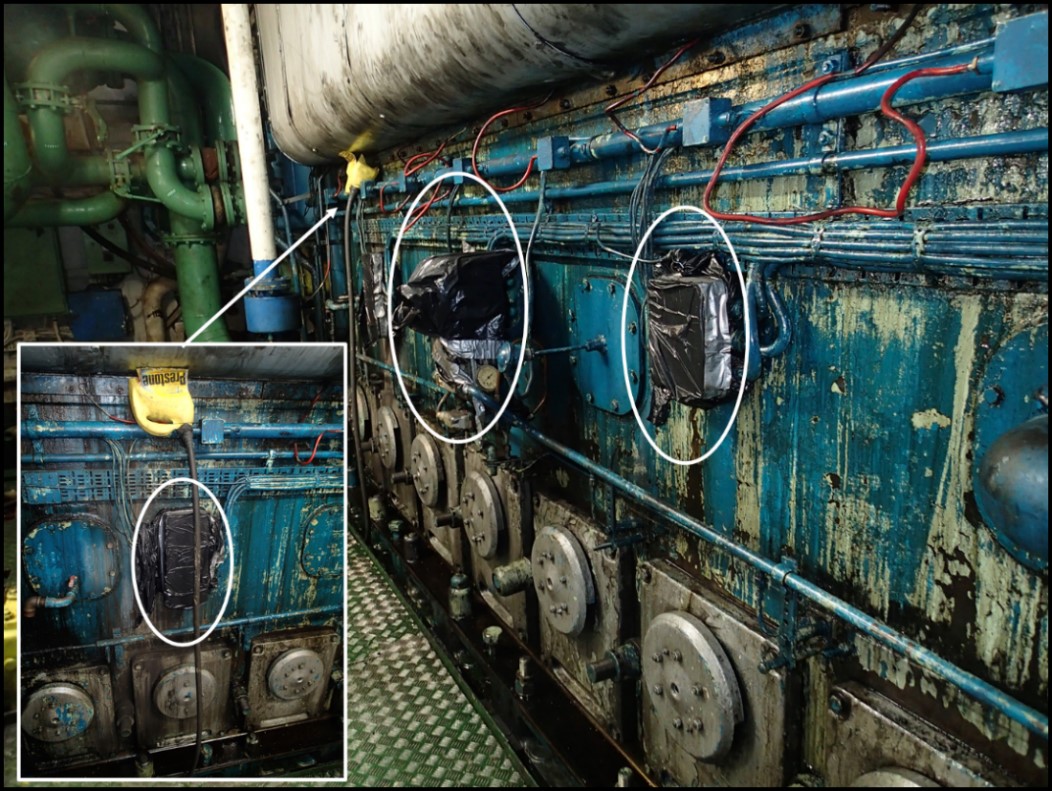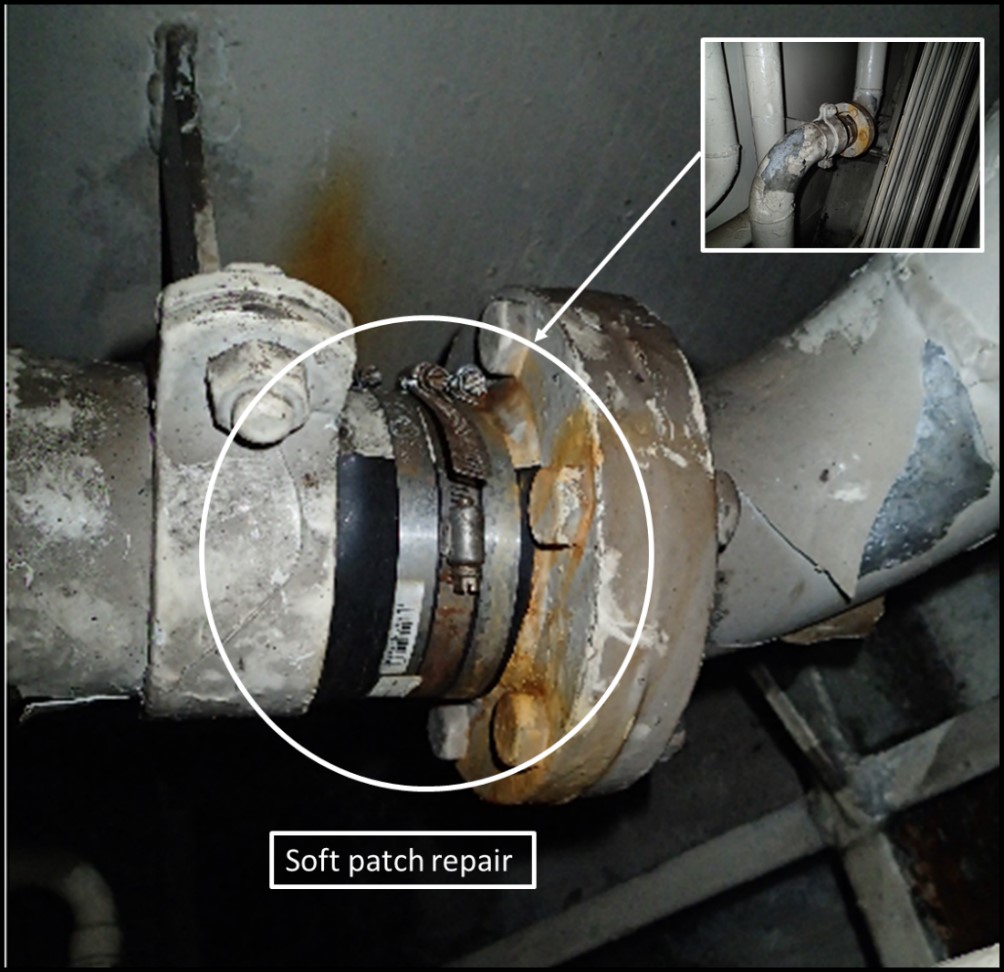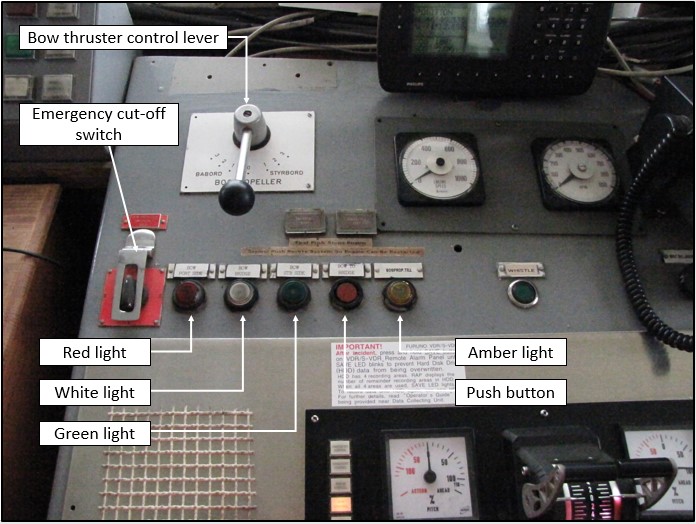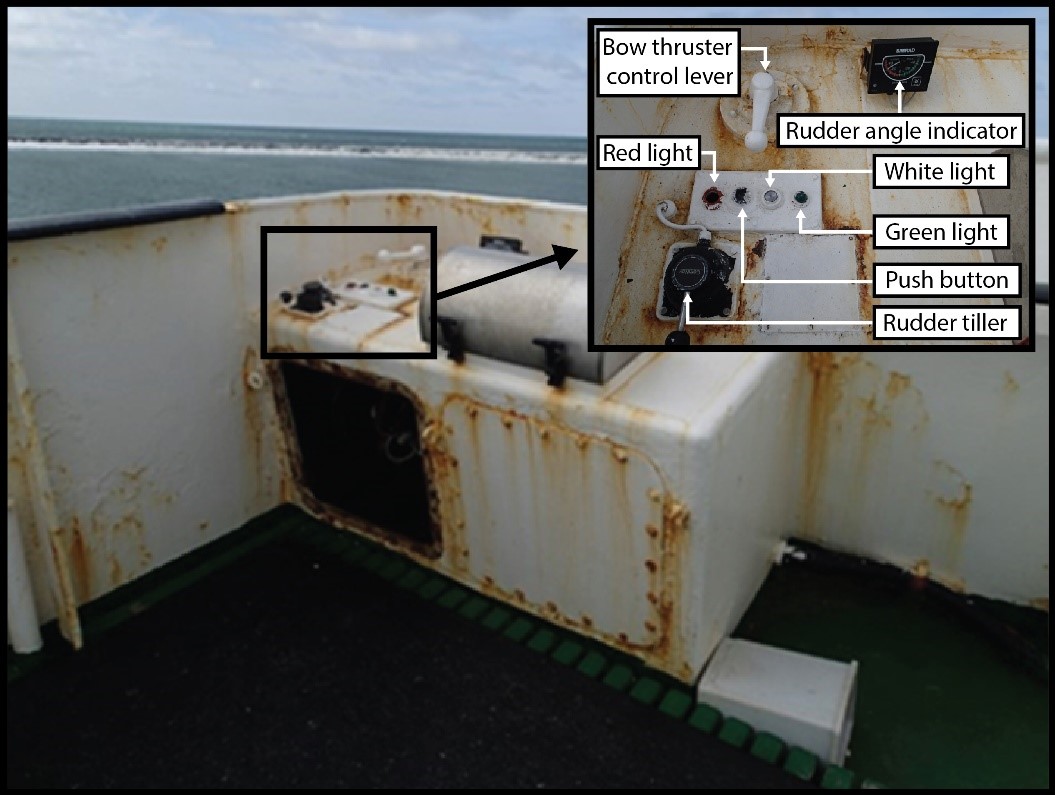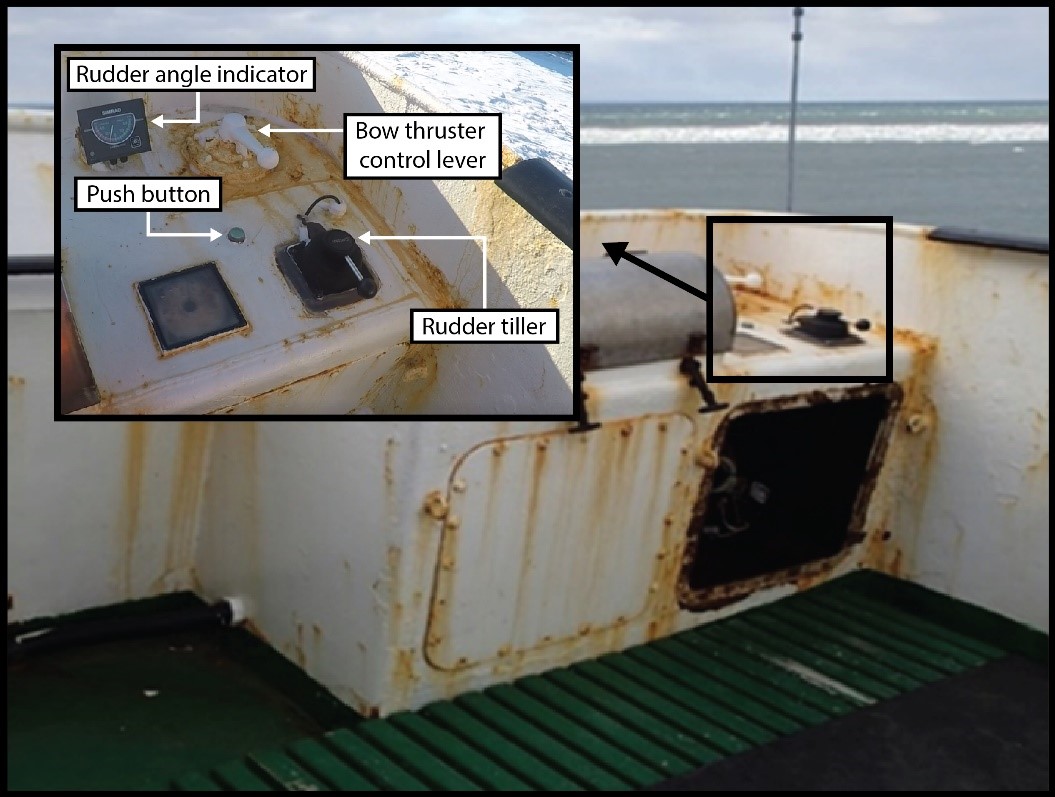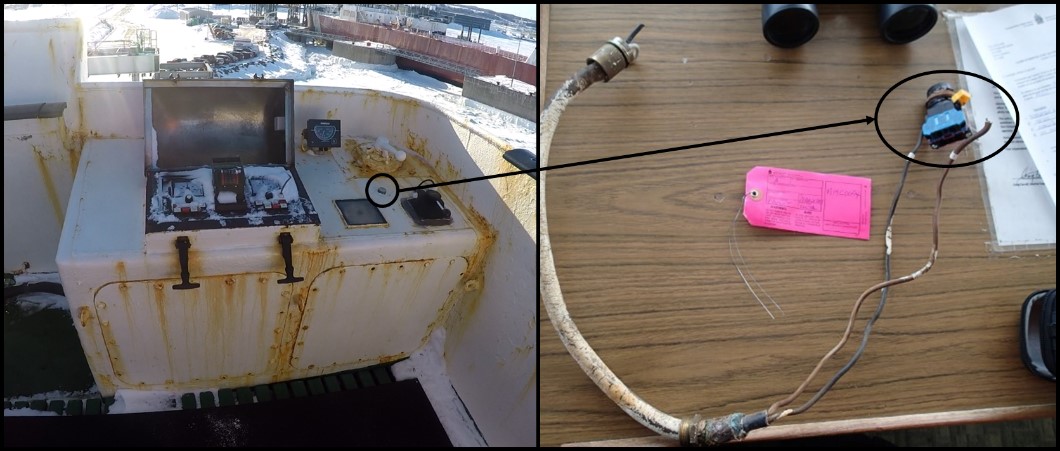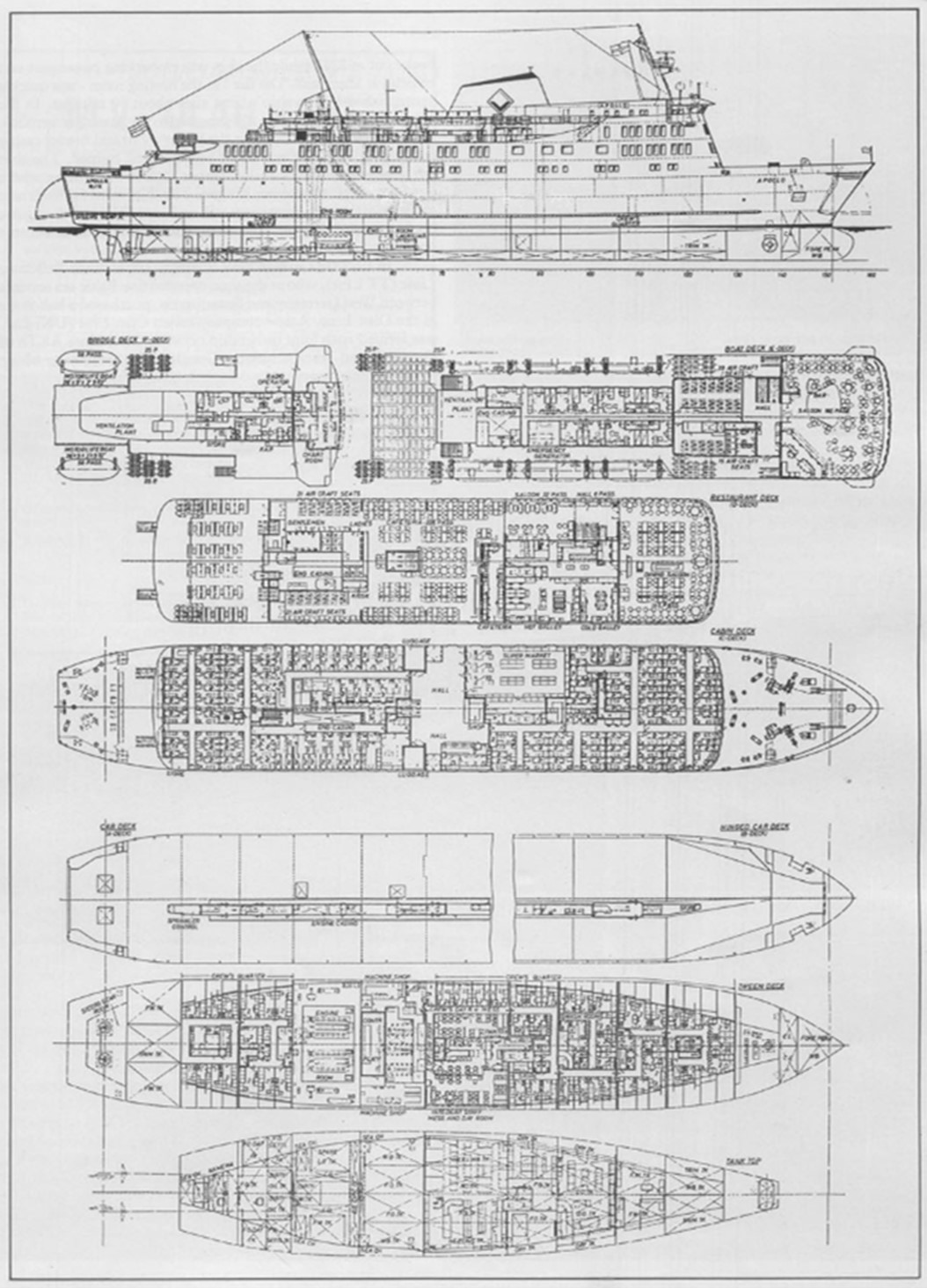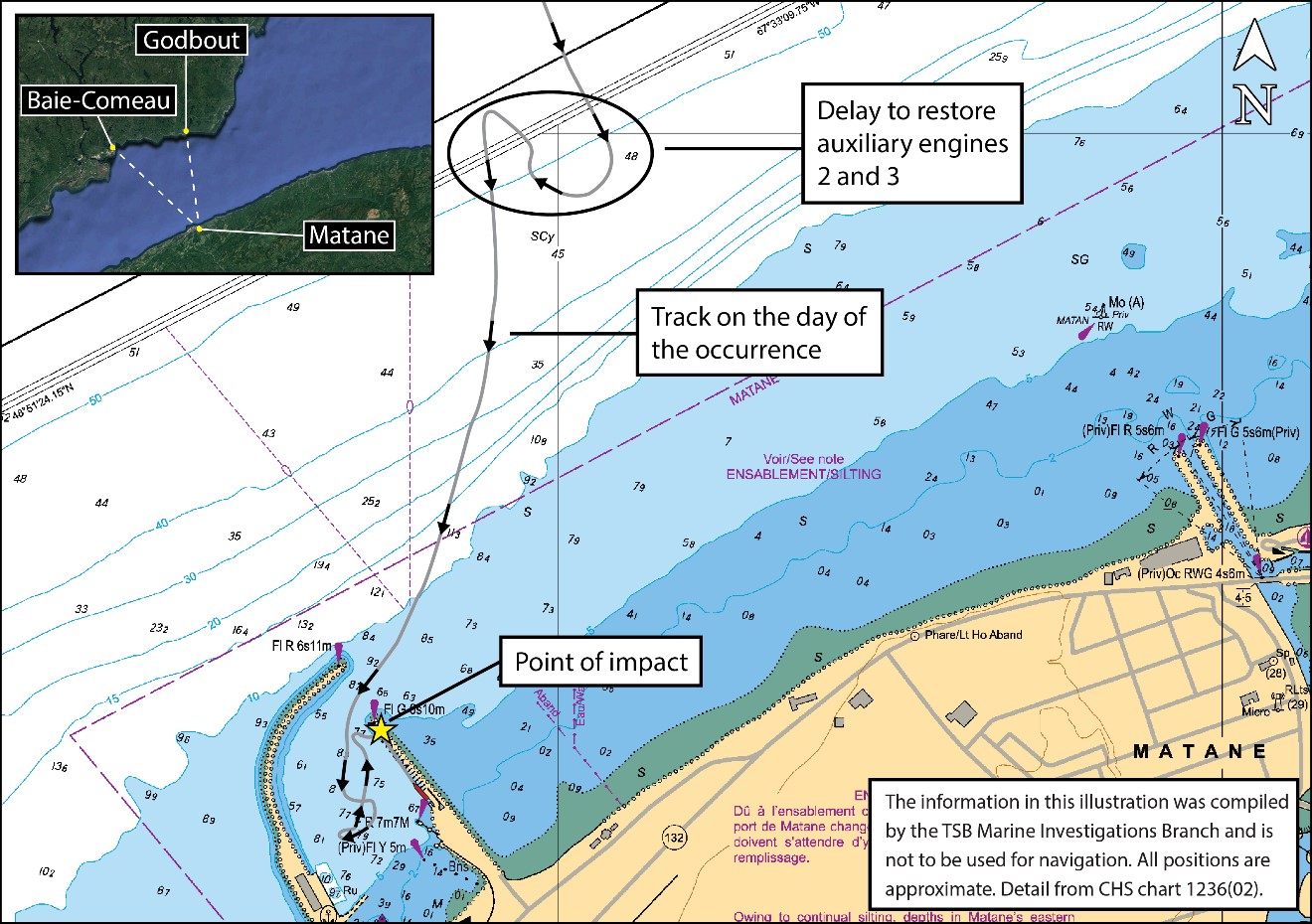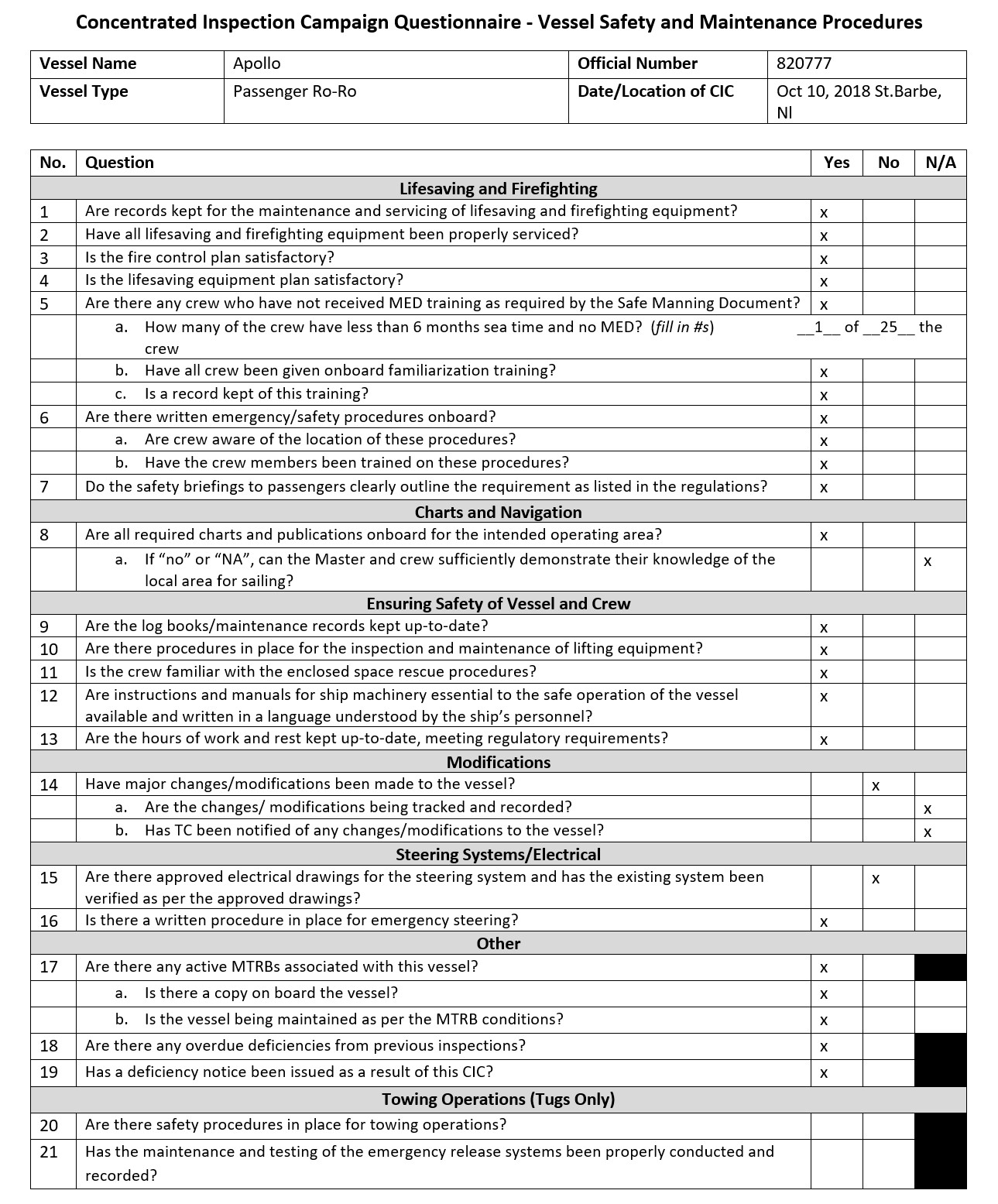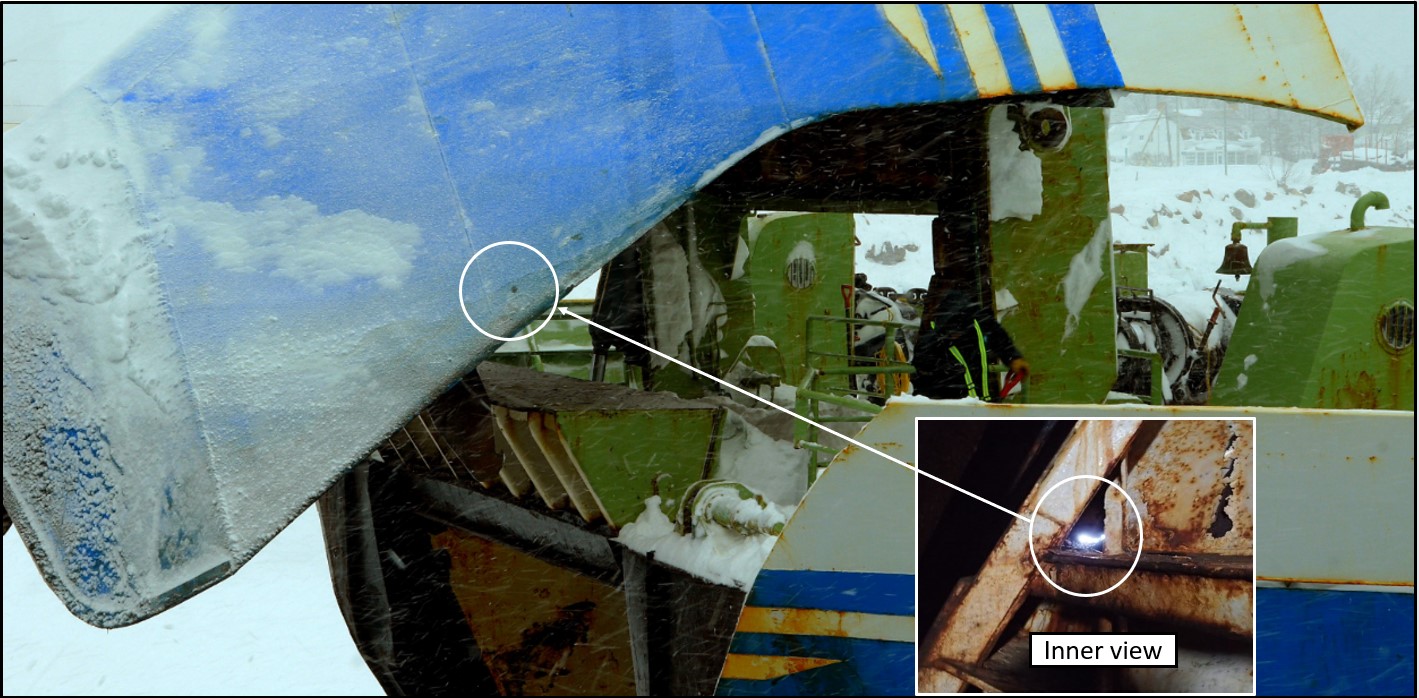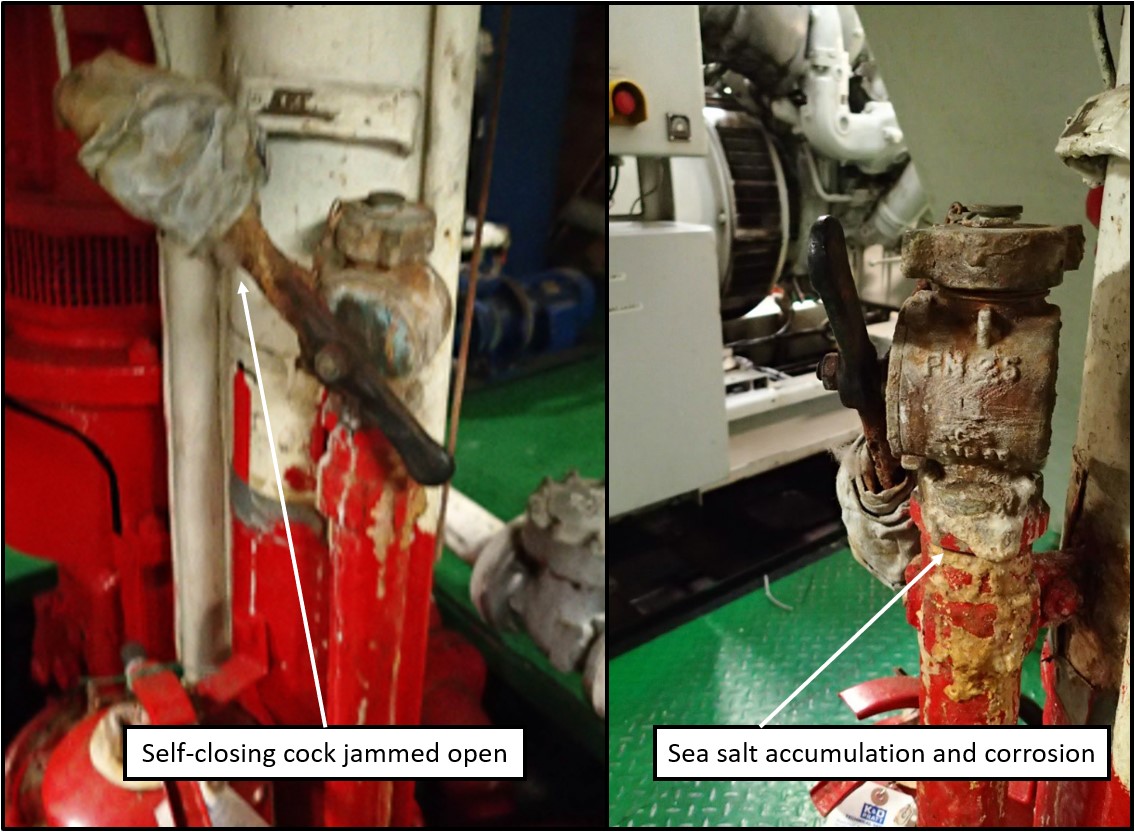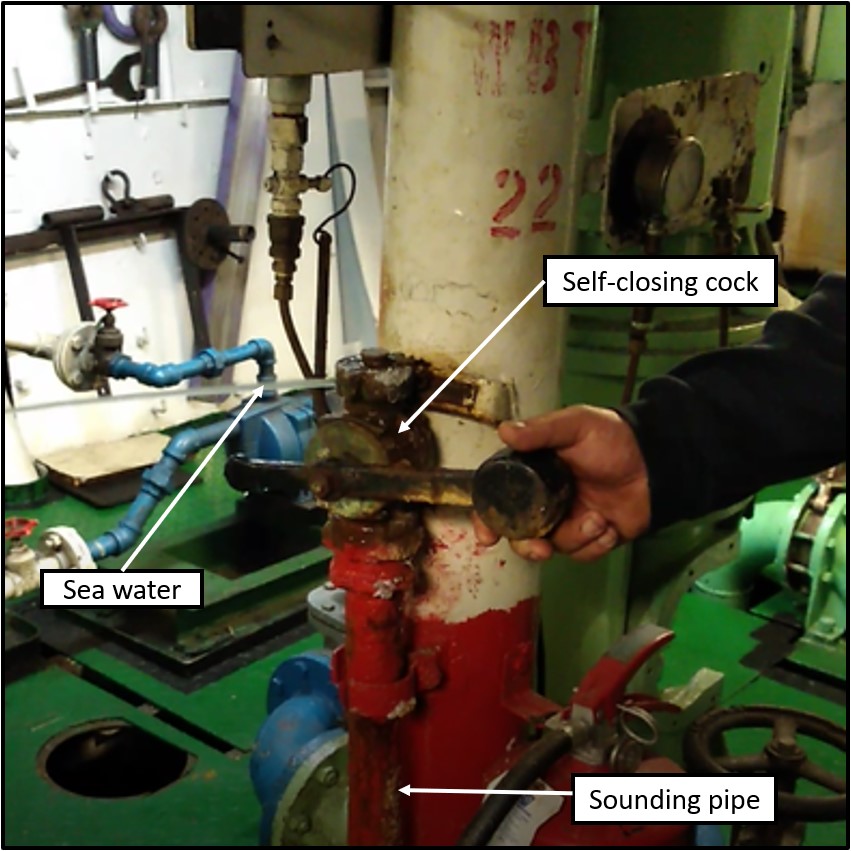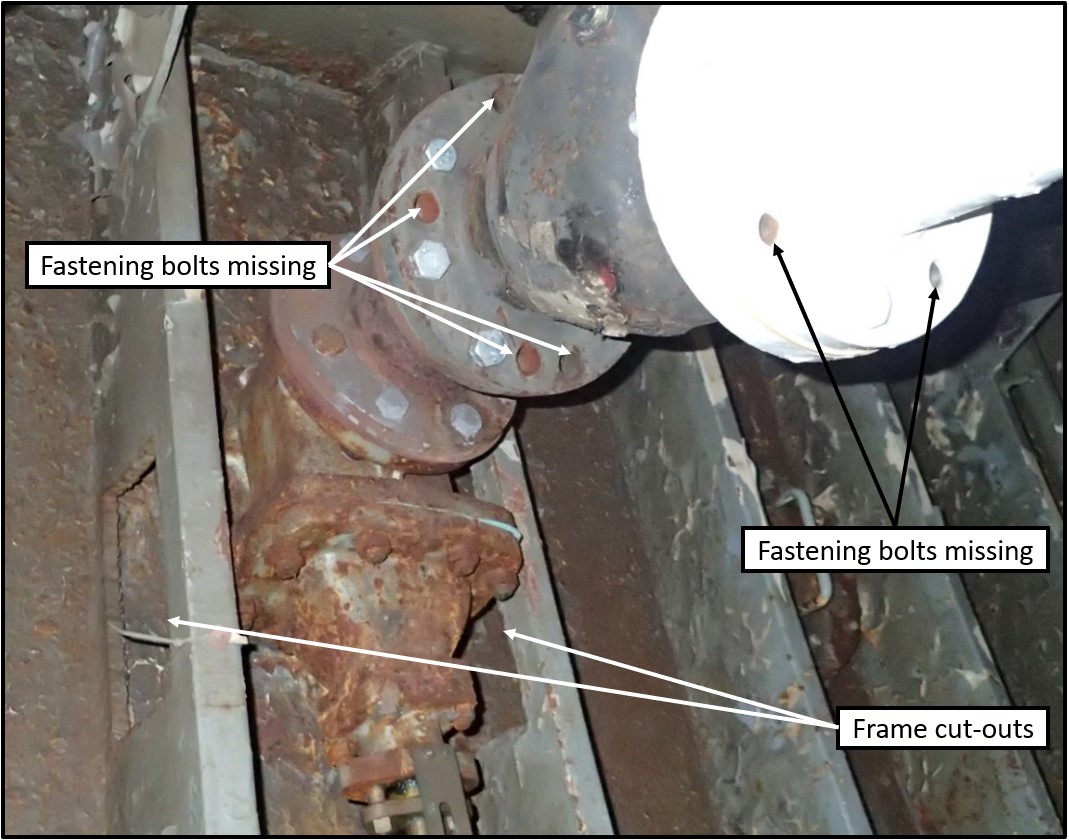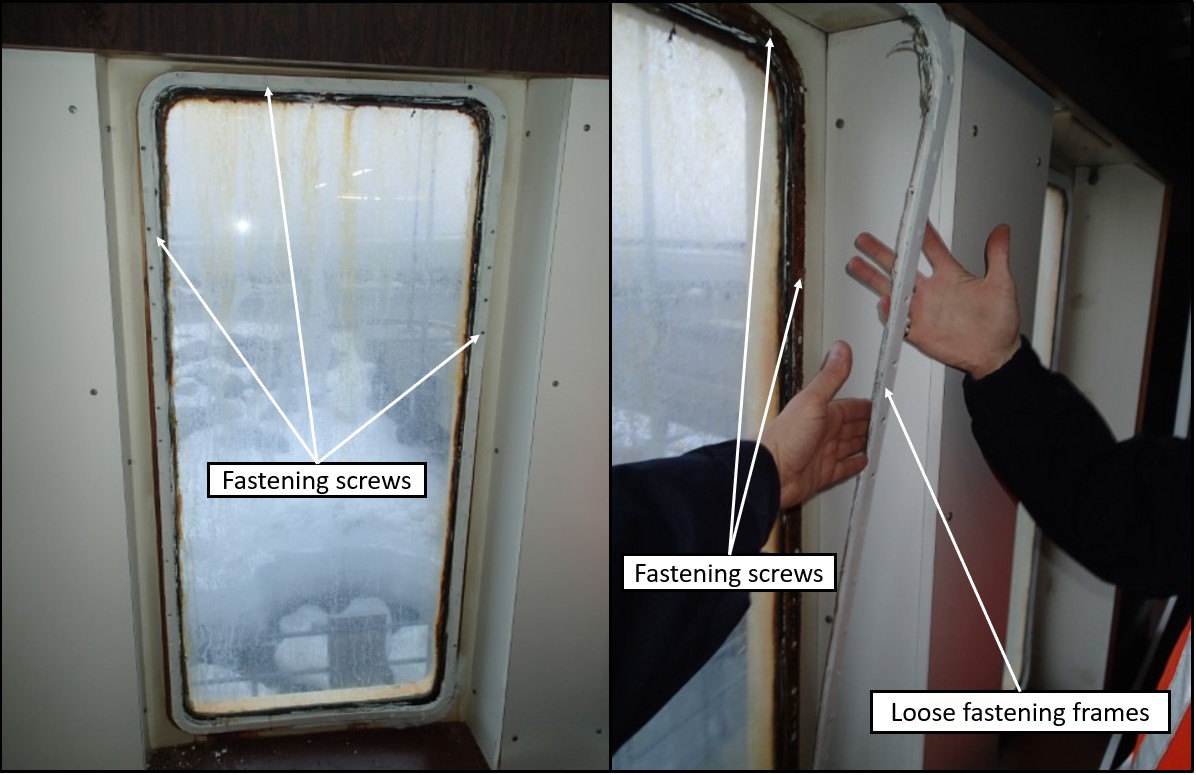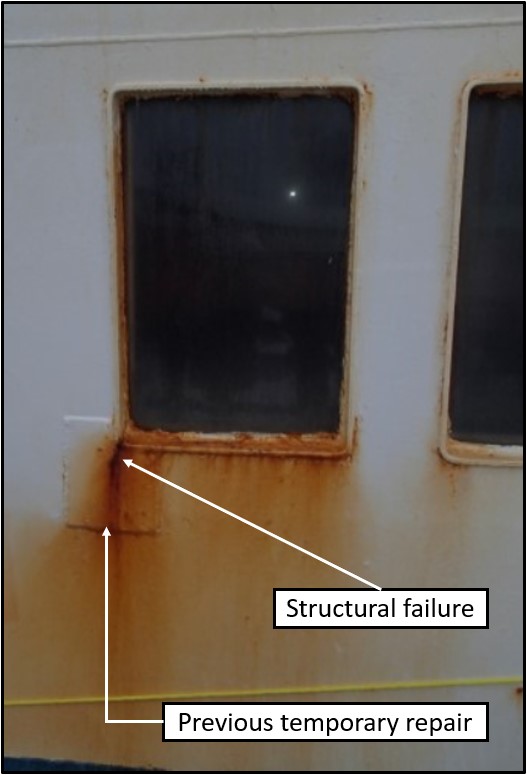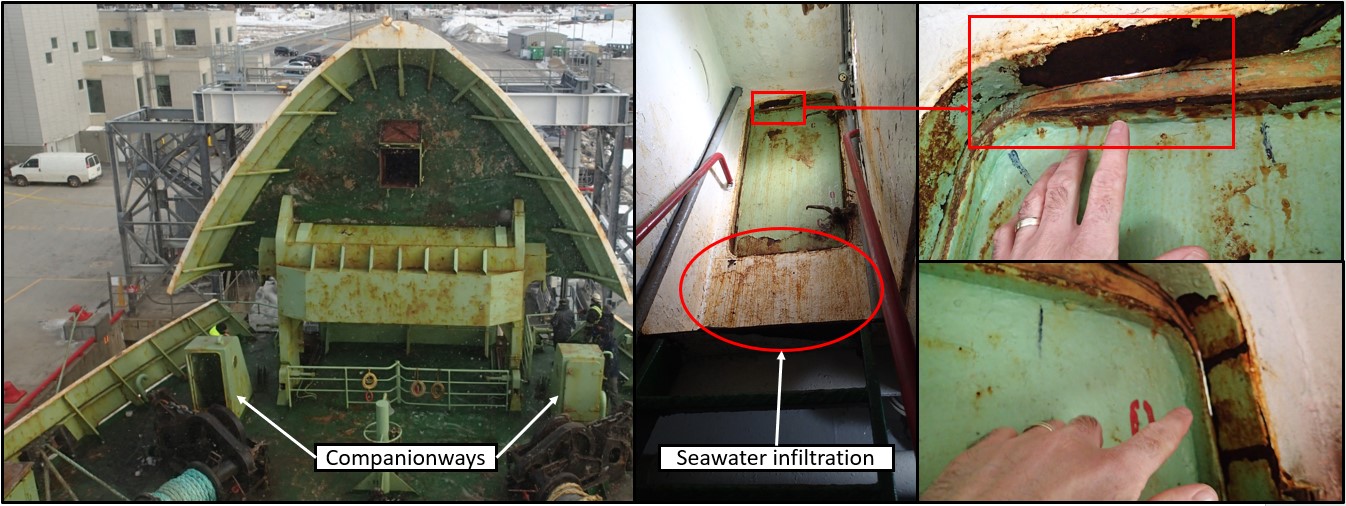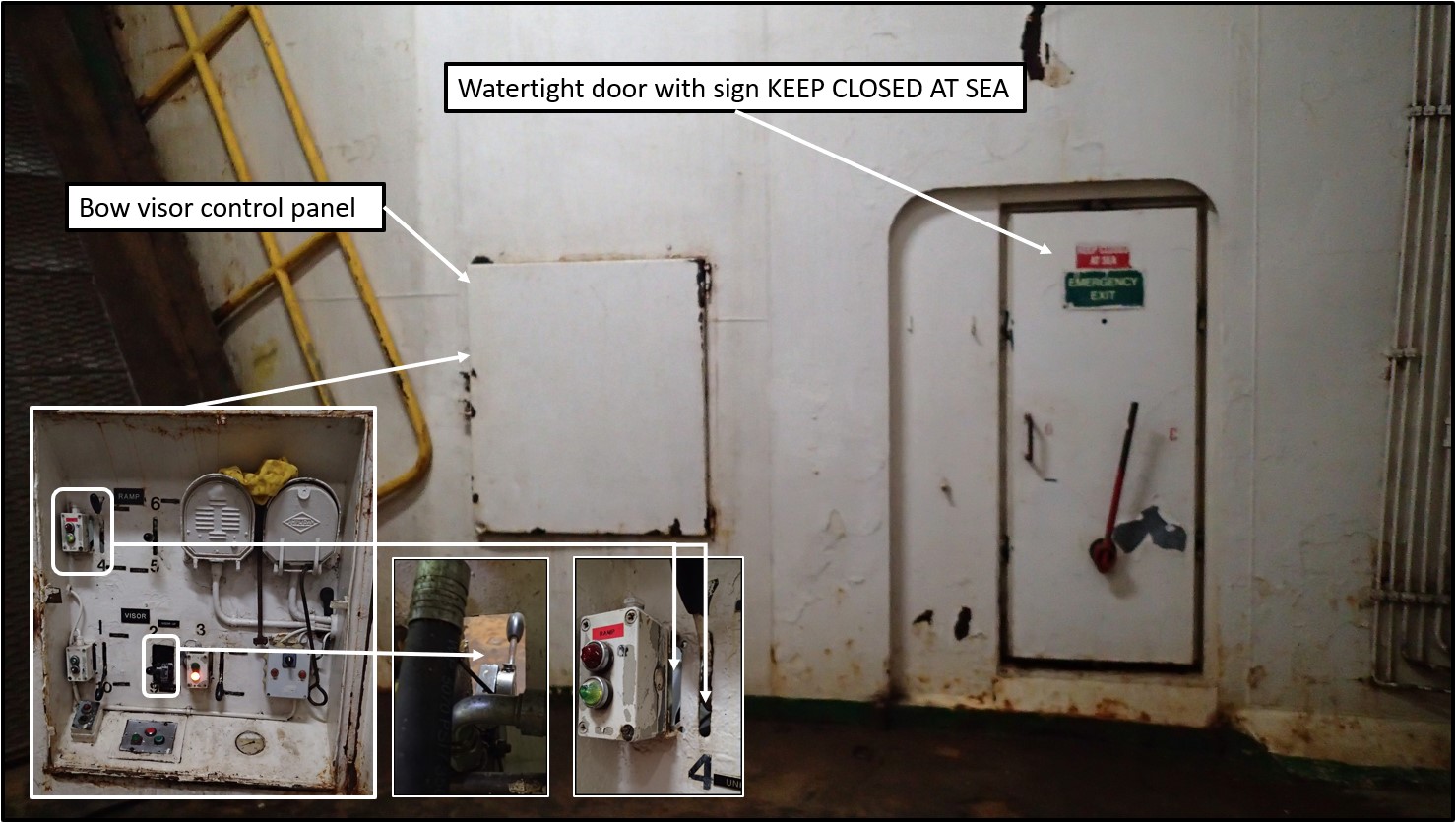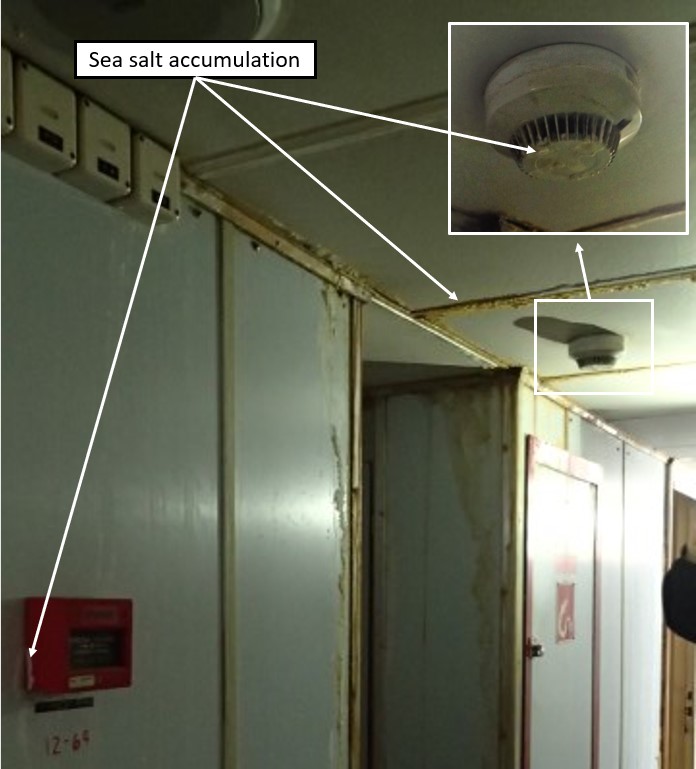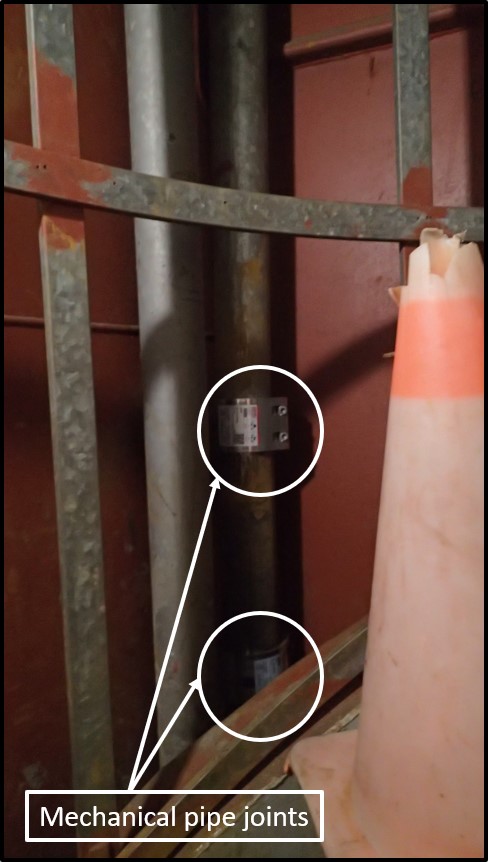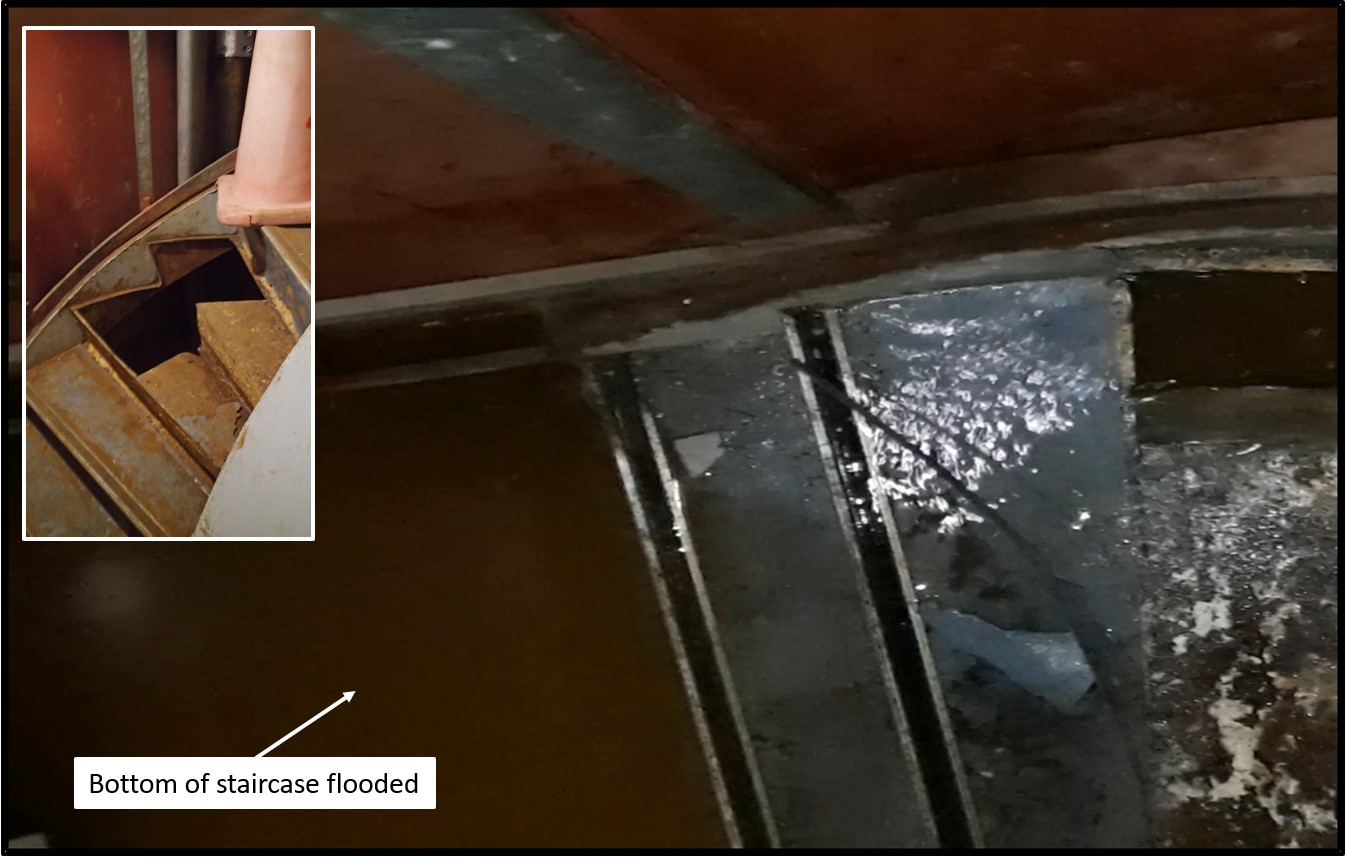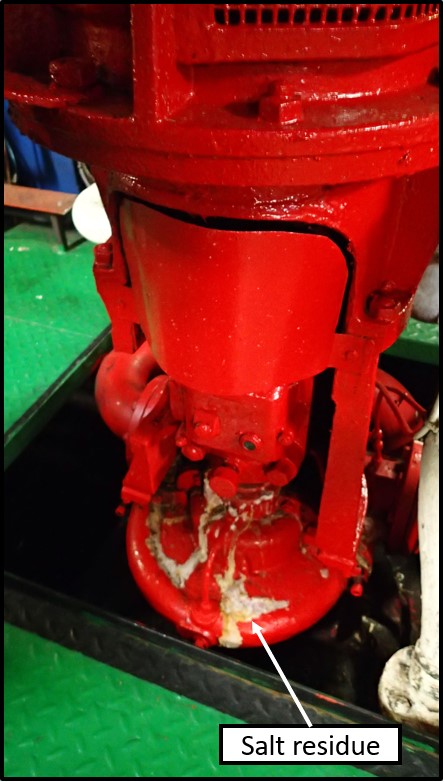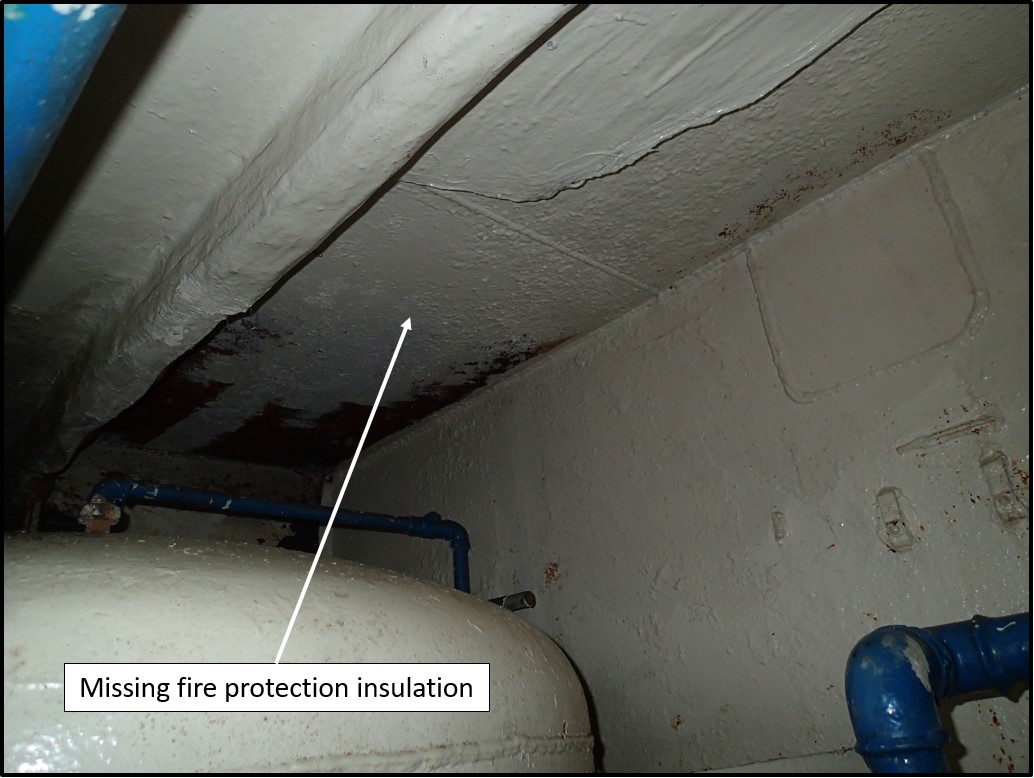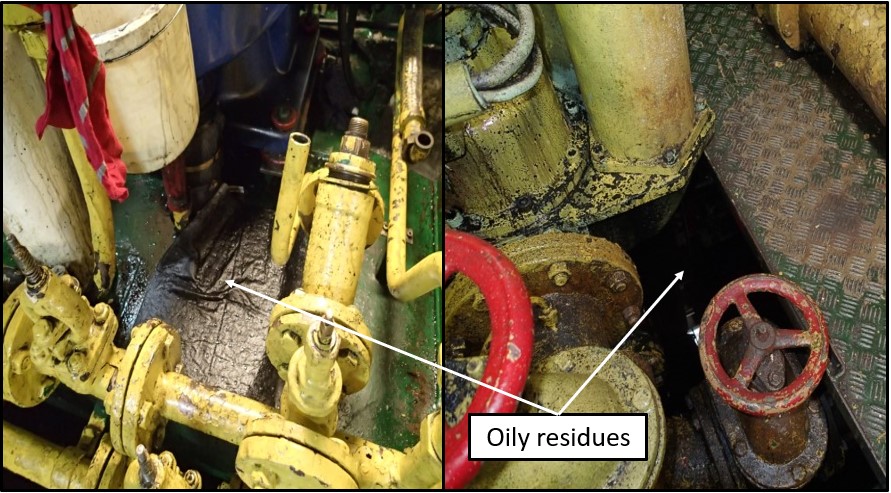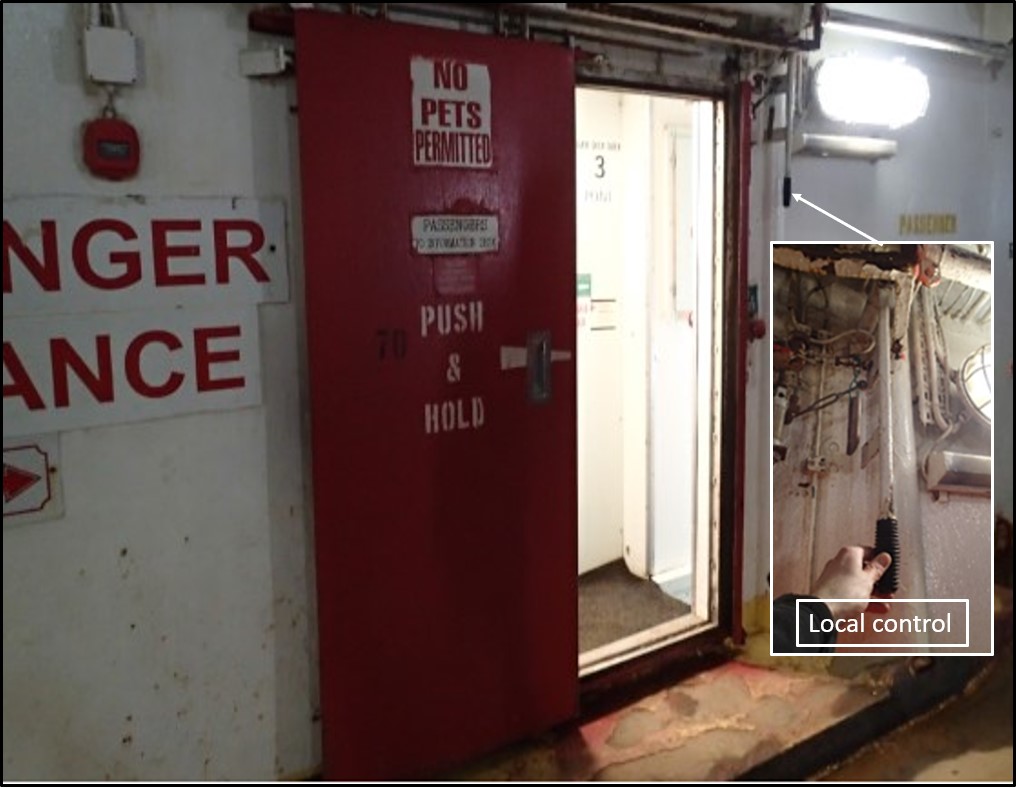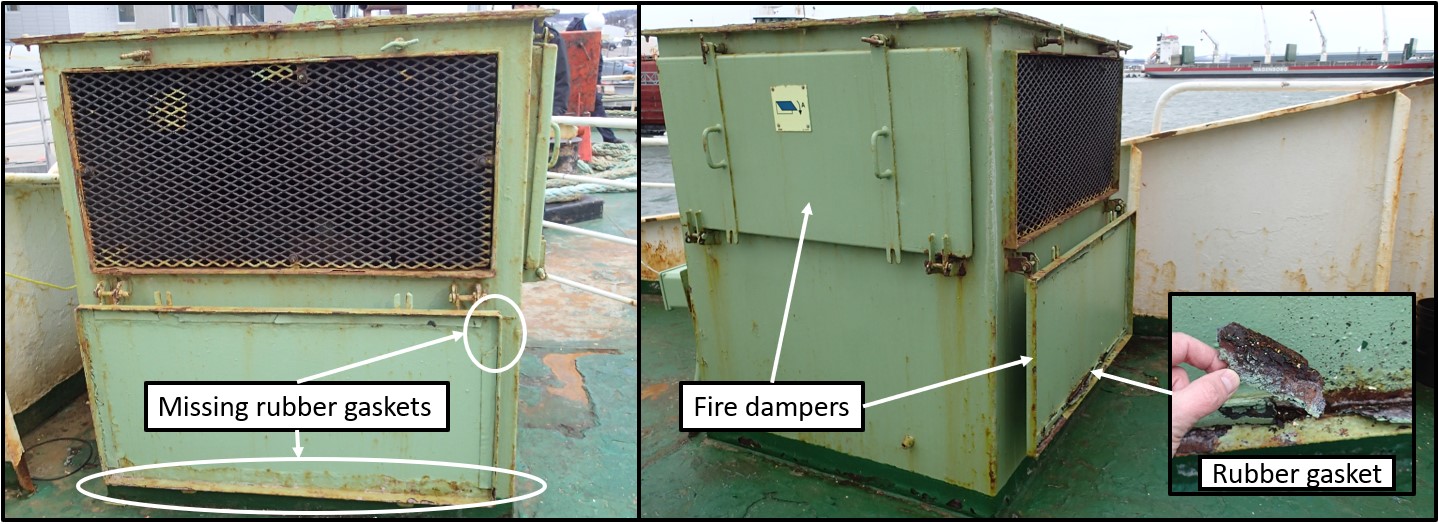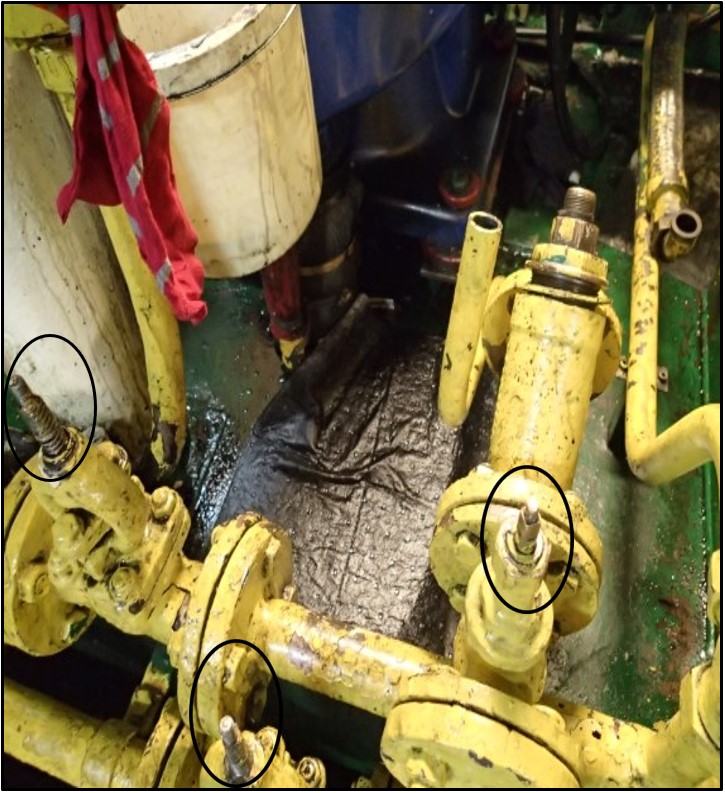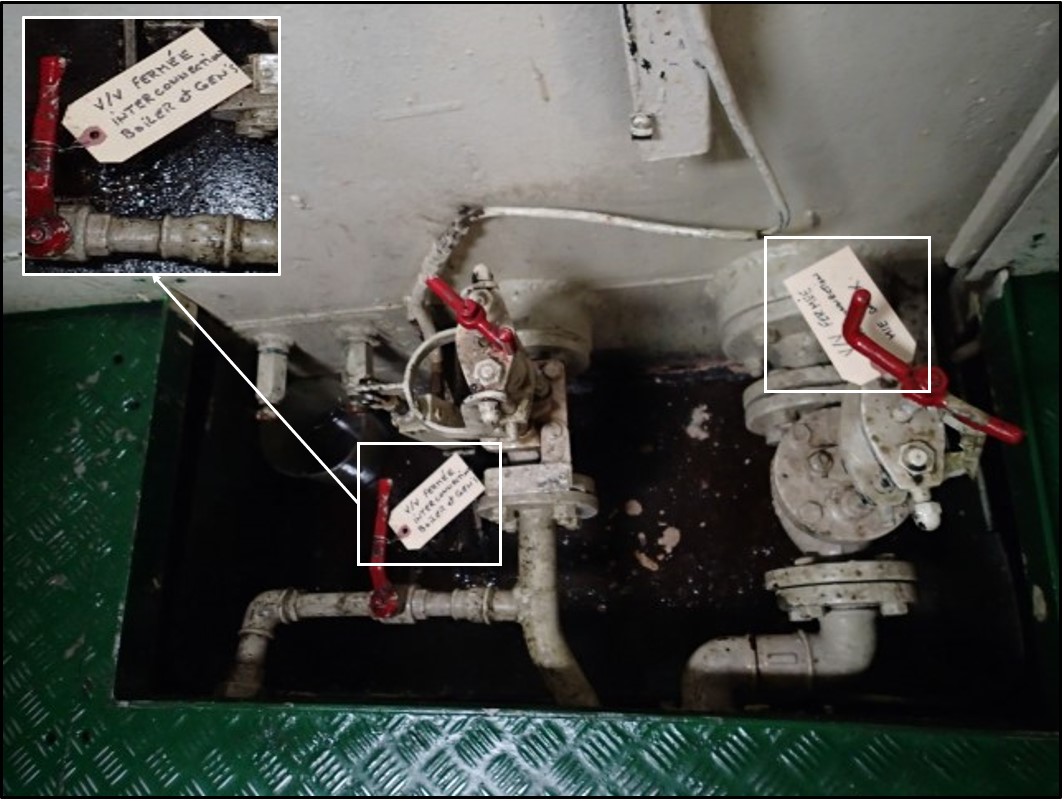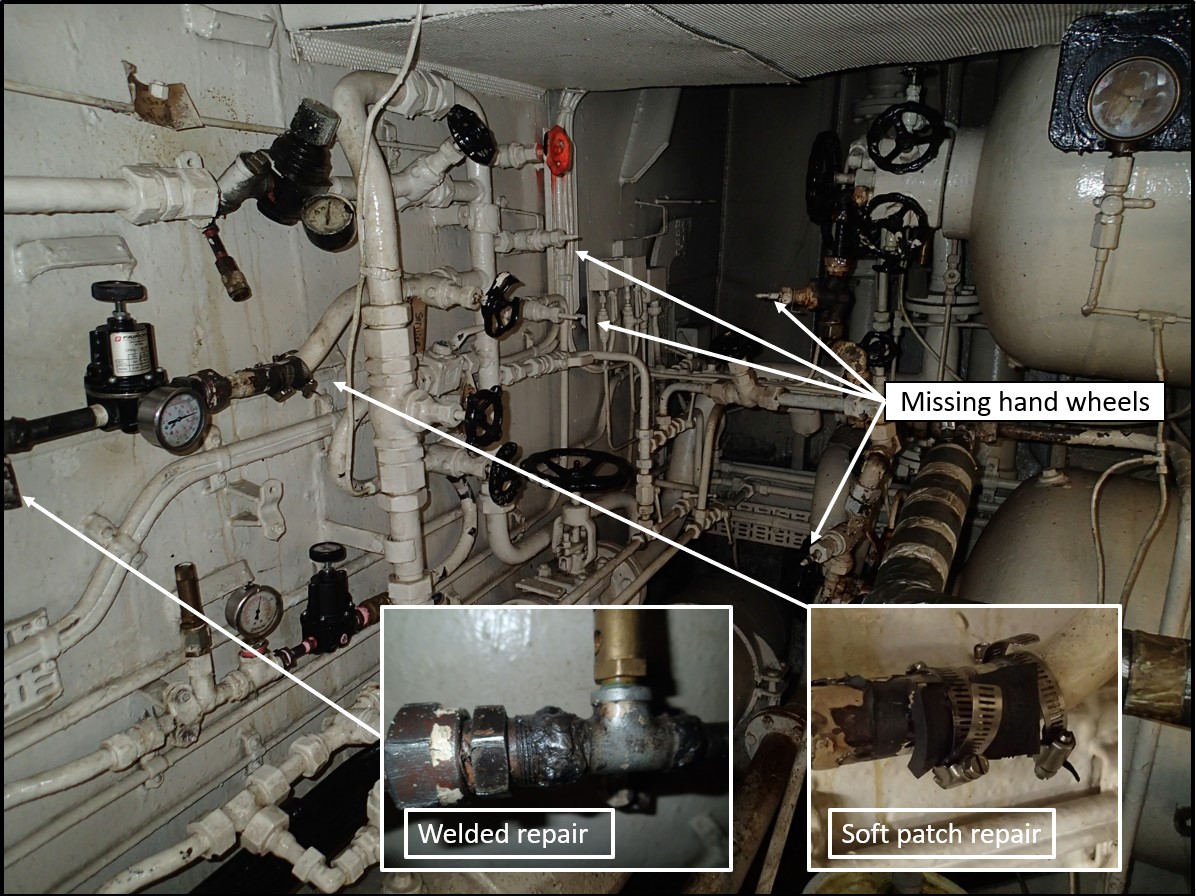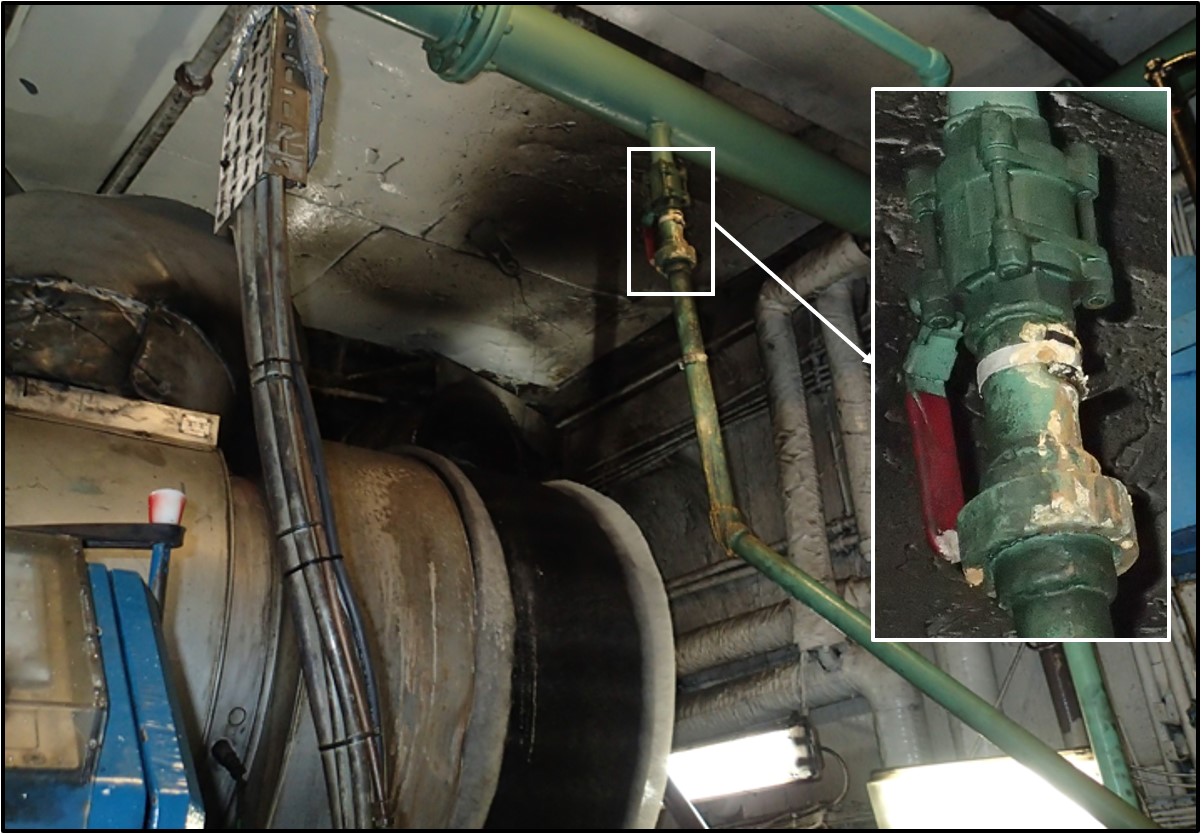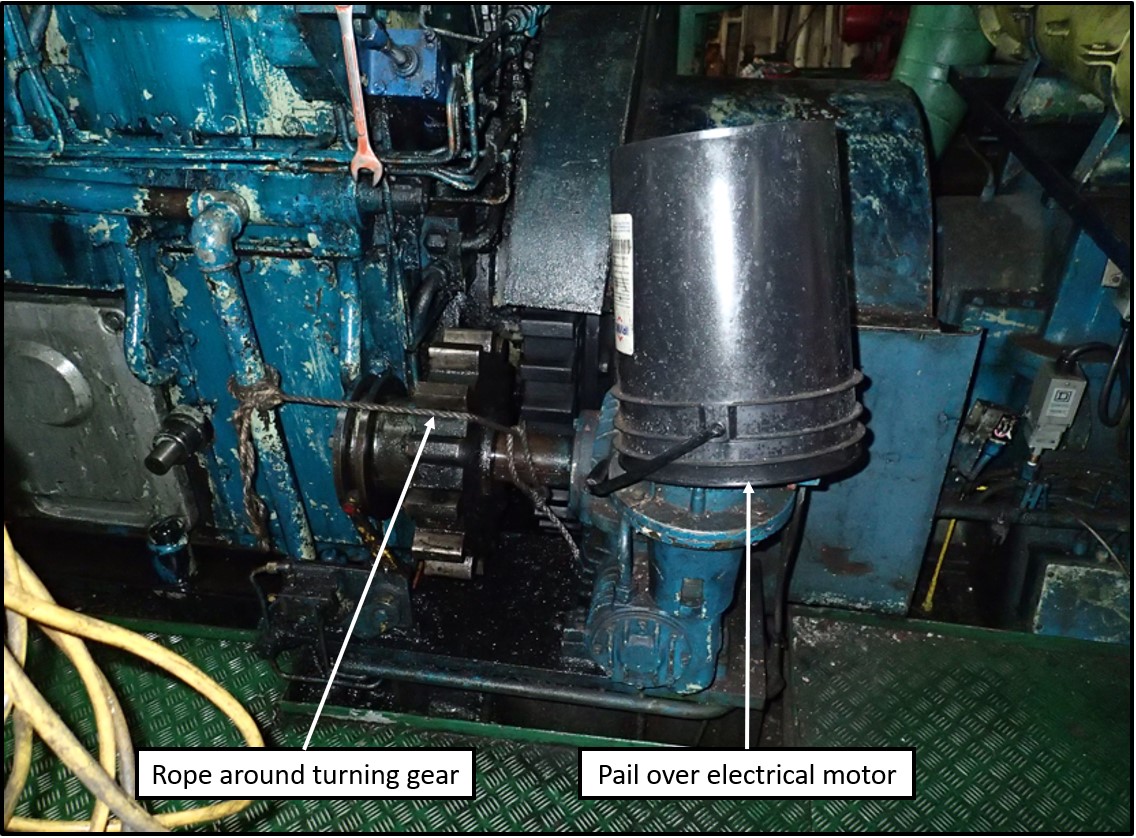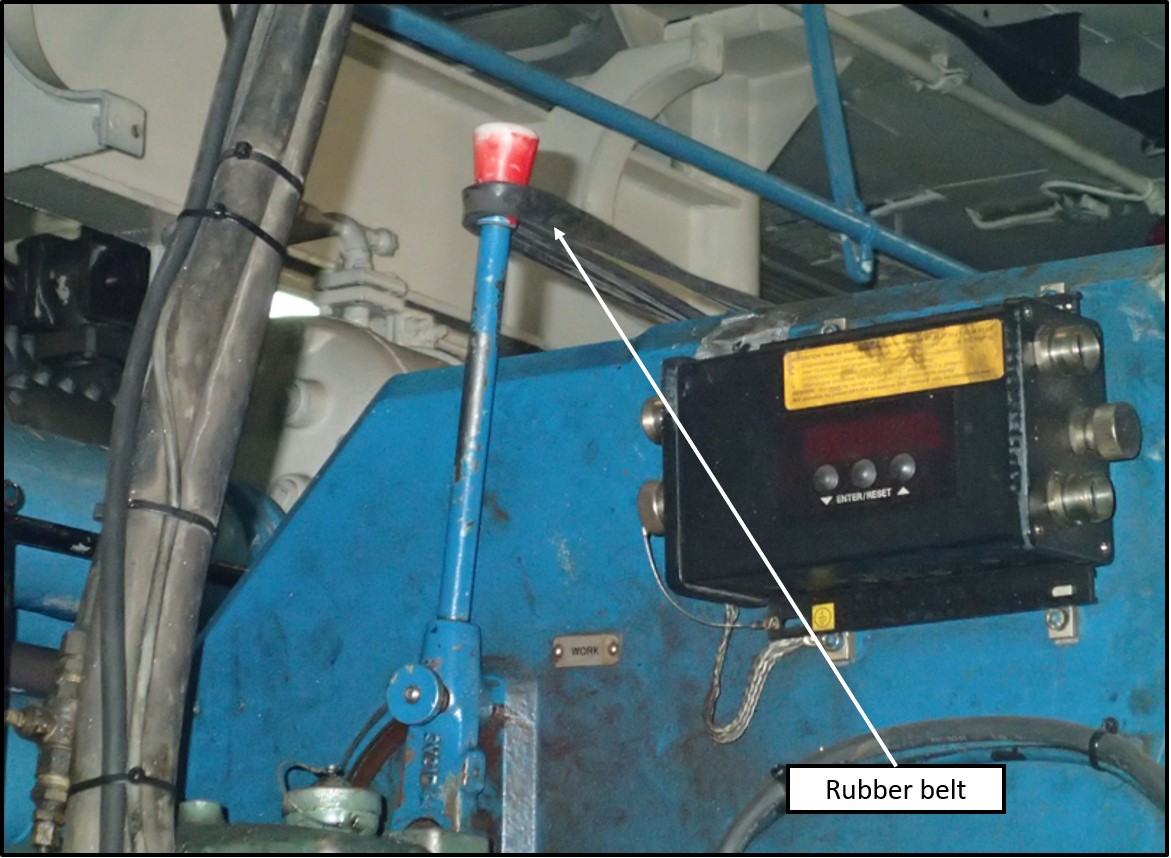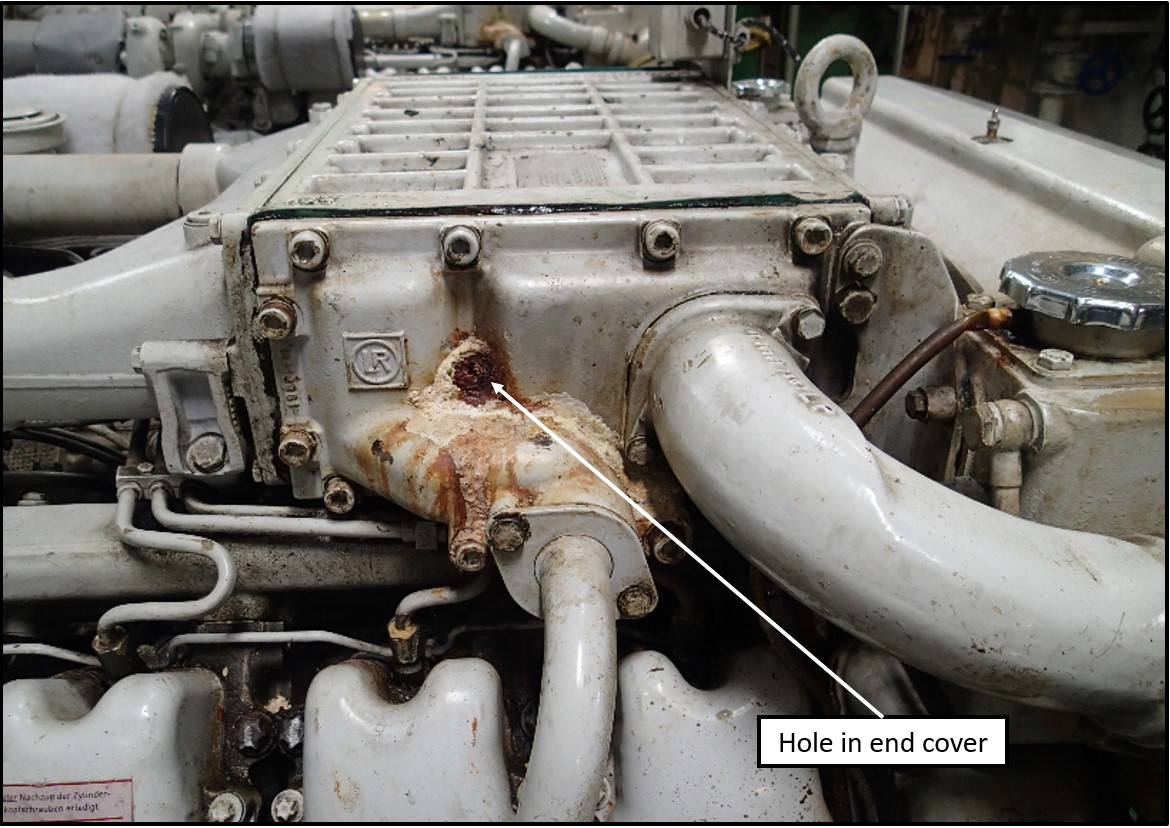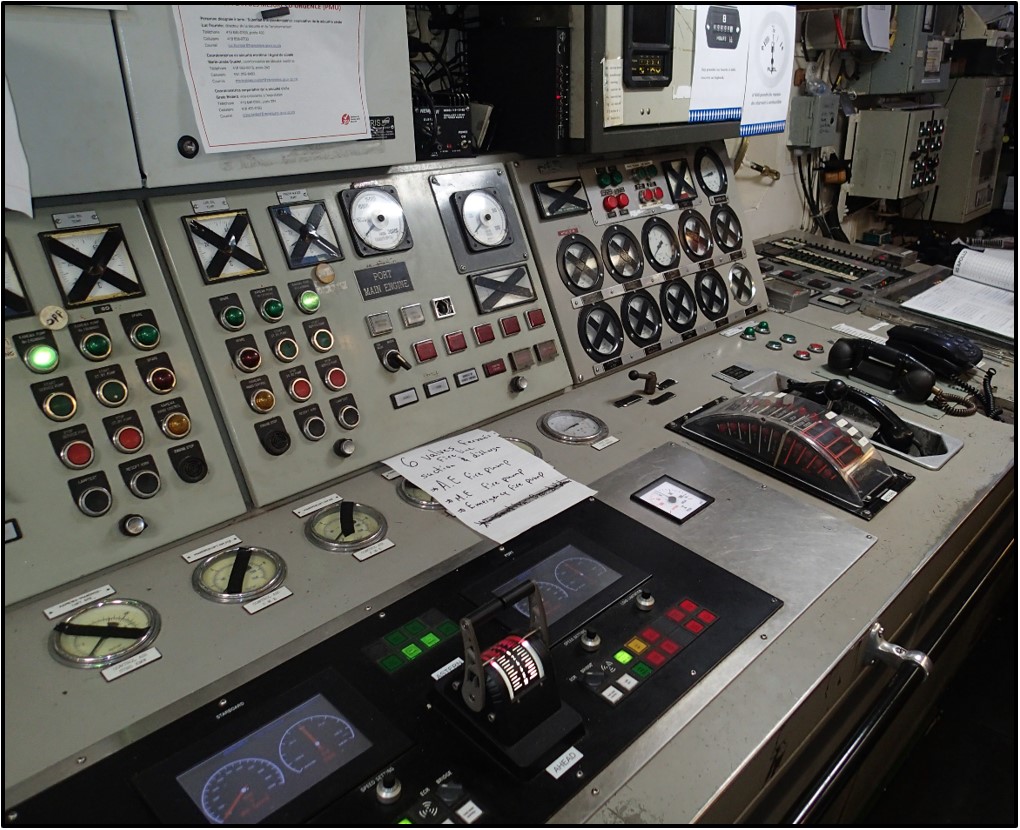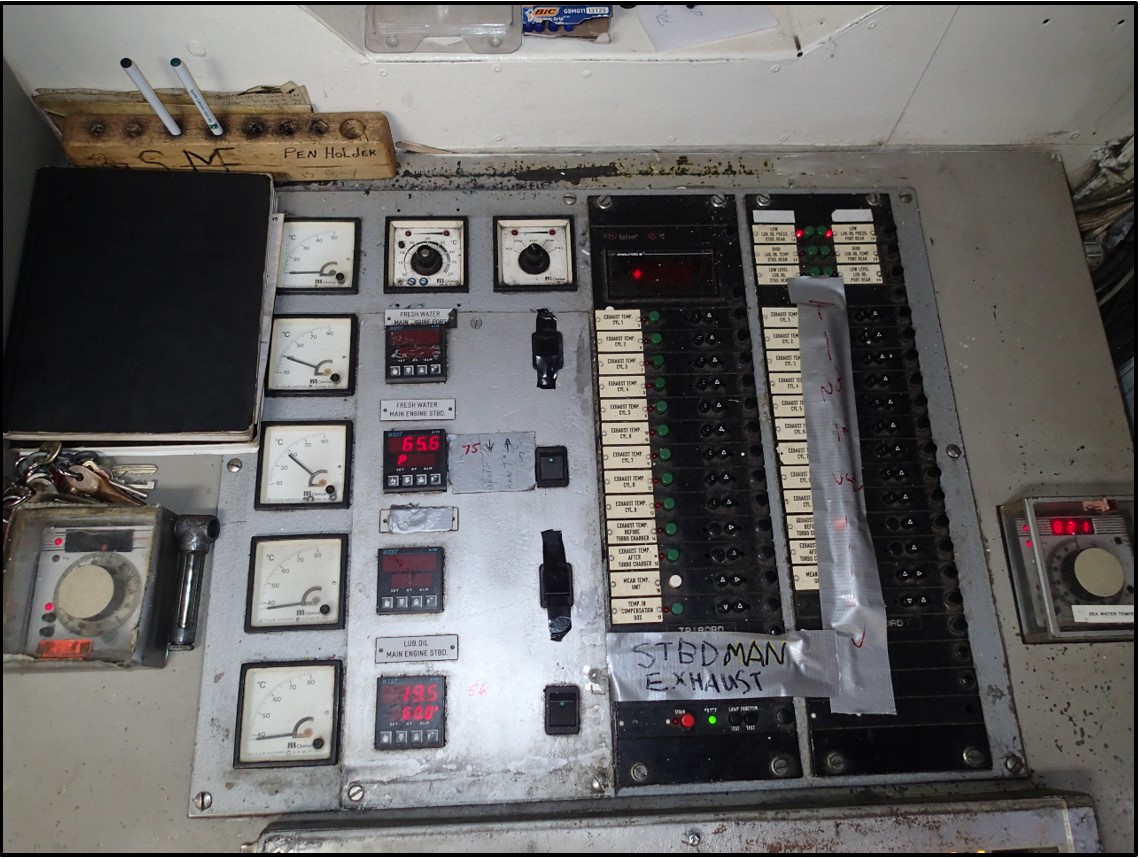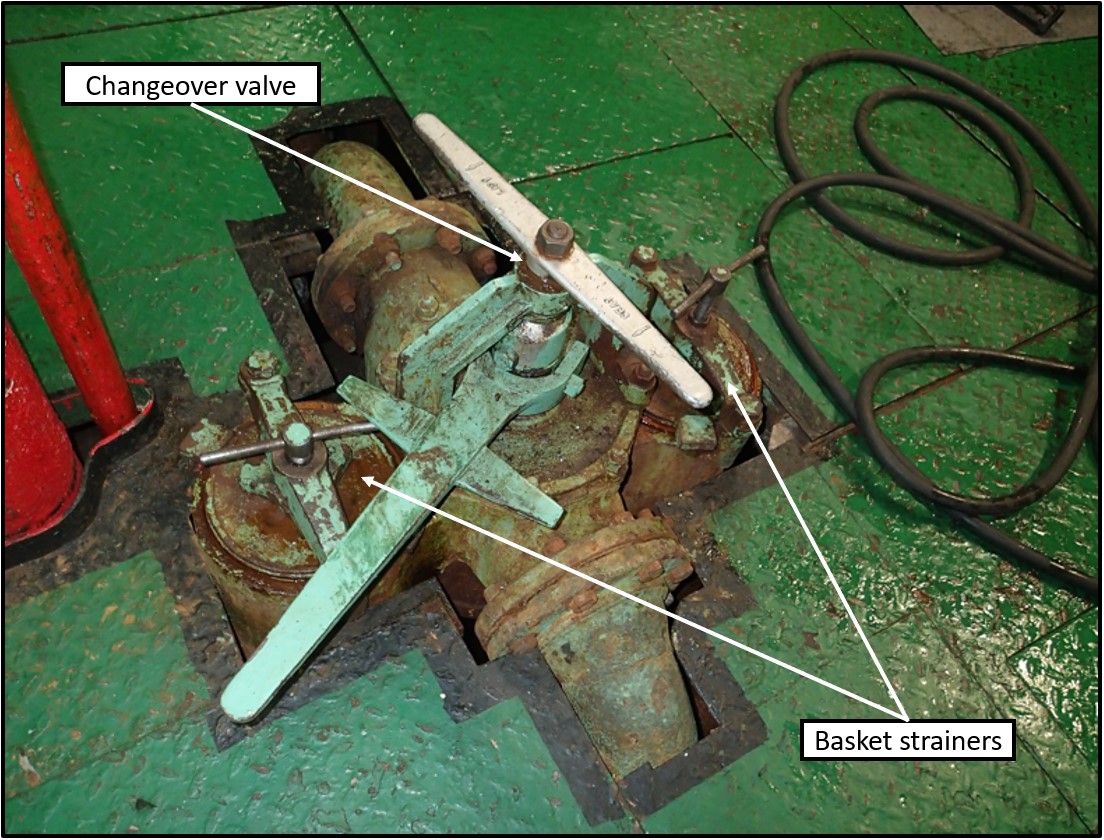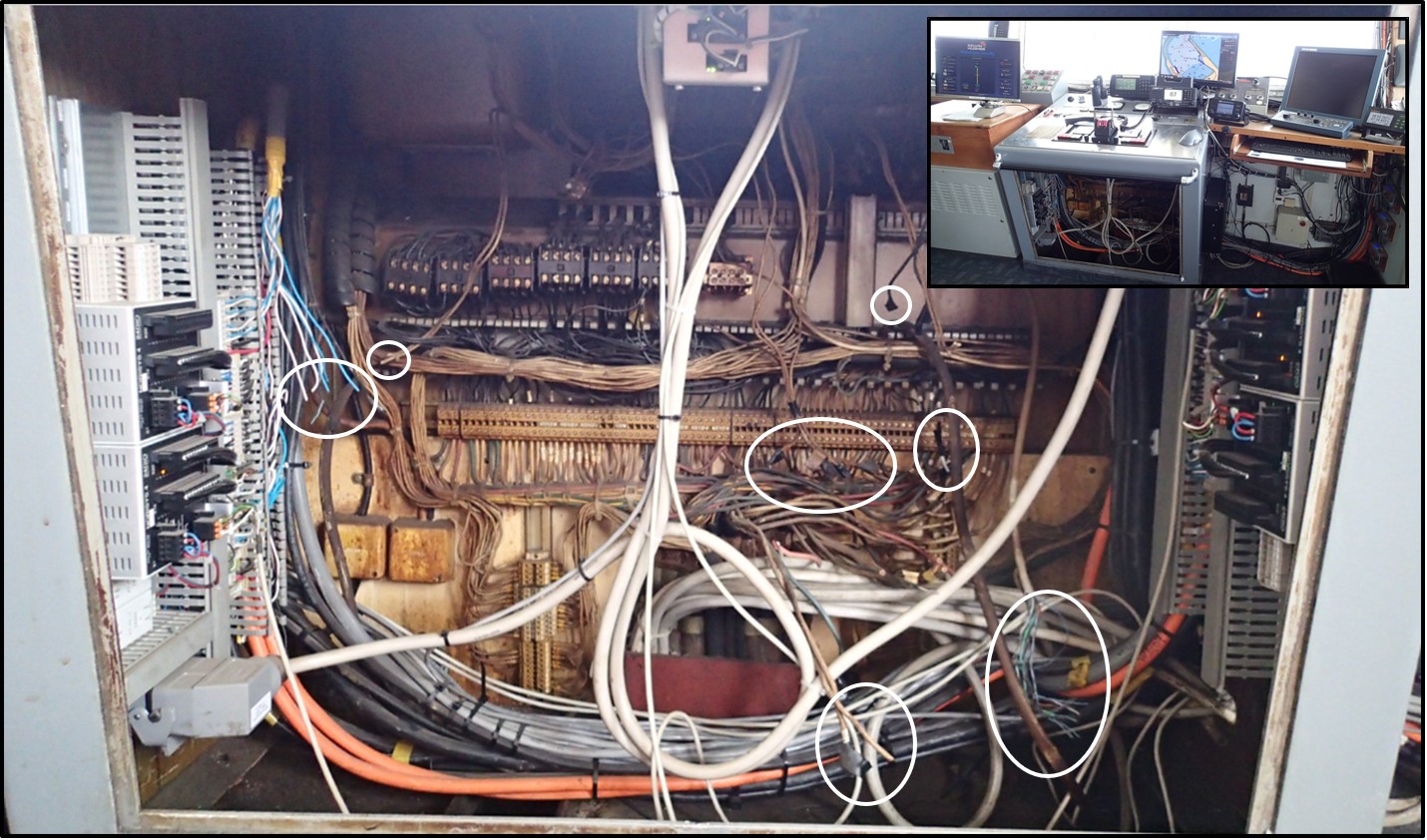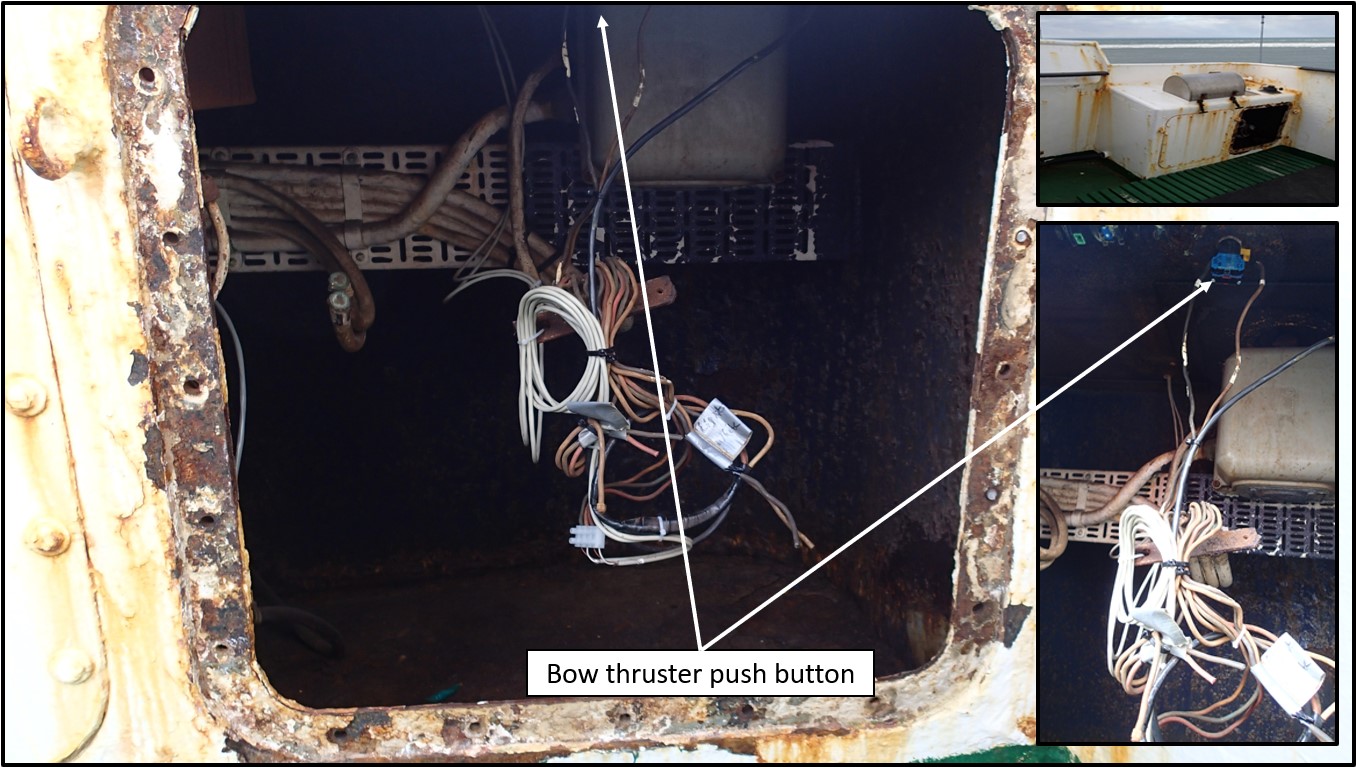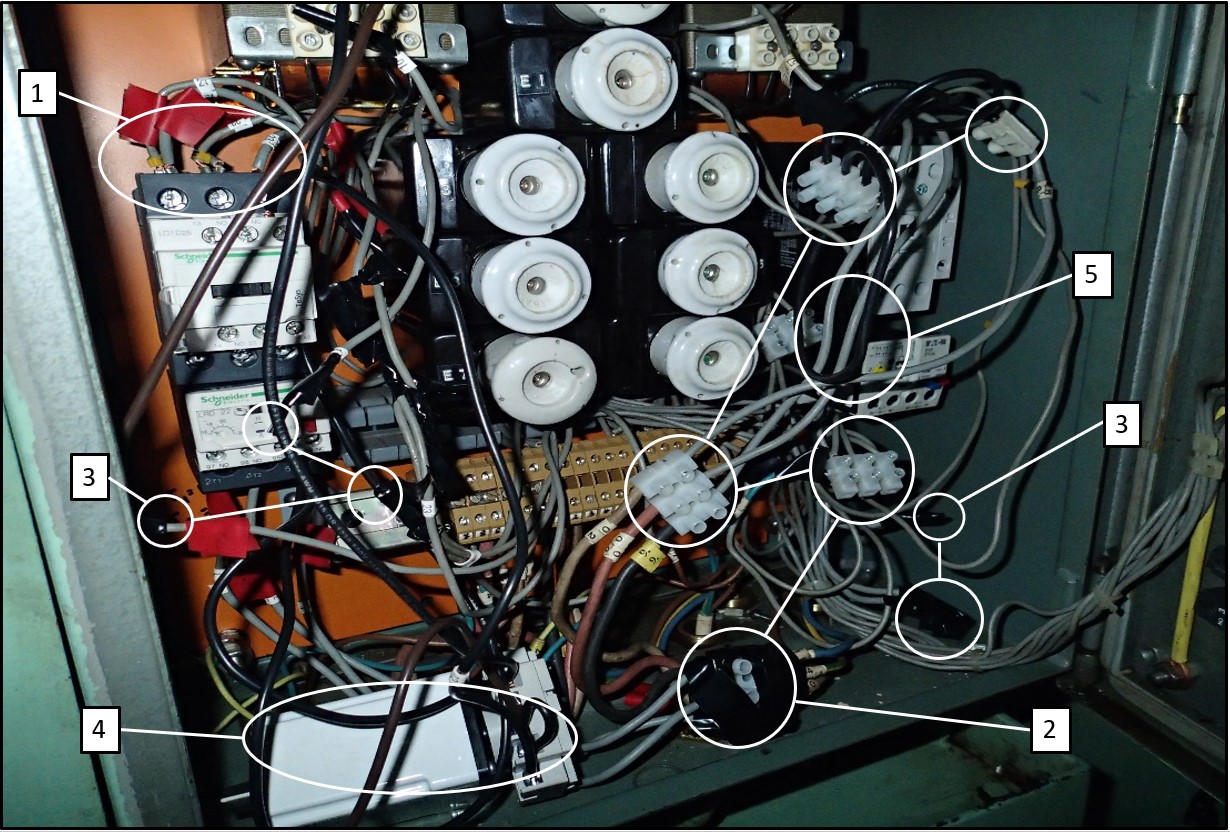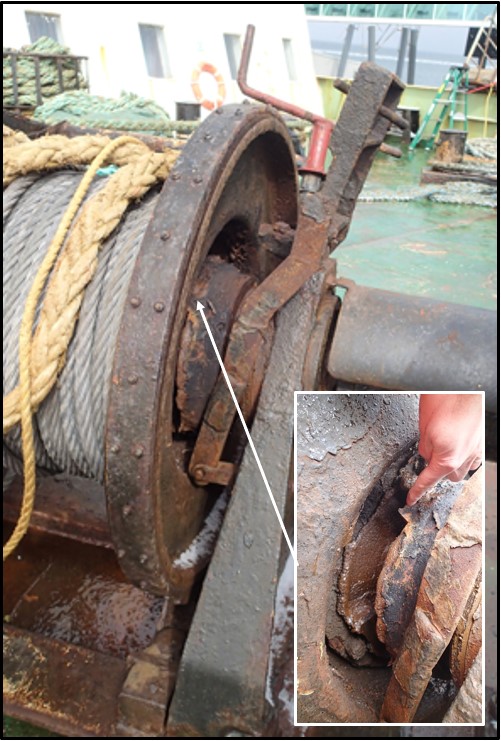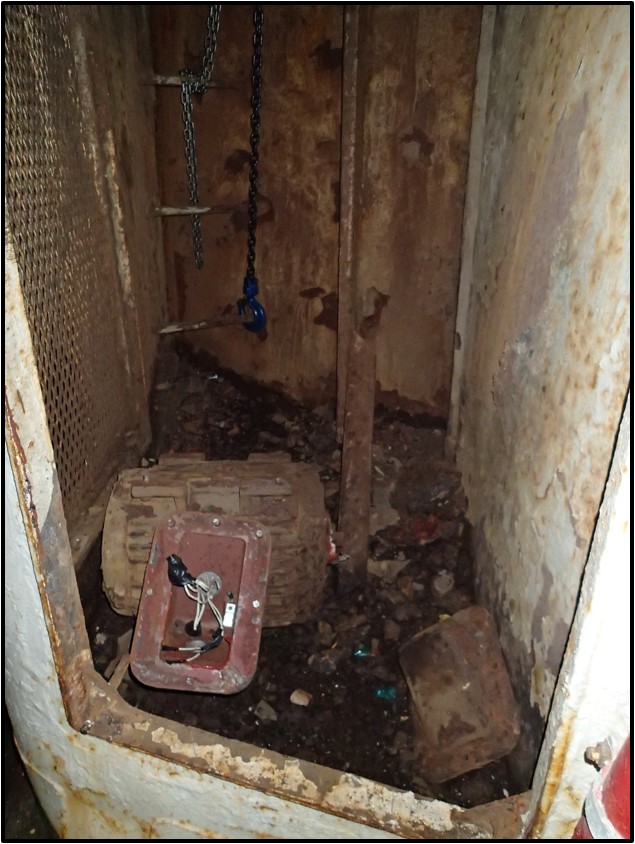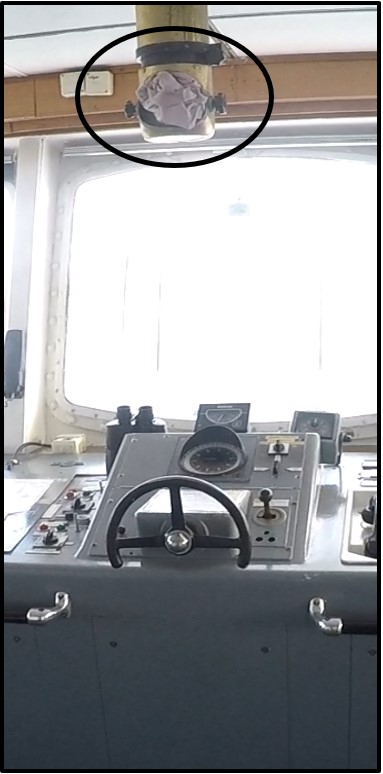Striking of a mooring dolphin
Roll-on/roll-off ferry Apollo
Matane, Quebec
The Transportation Safety Board of Canada (TSB) investigated this occurrence for the purpose of advancing transportation safety. It is not the function of the Board to assign fault or determine civil or criminal liability. This report is not created for use in the context of legal, disciplinary or other proceedings. See Ownership and use of content. Masculine pronouns and position titles may be used to signify all genders to comply with the Canadian Transportation Accident Investigation and Safety Board Act (S.C. 1989, c. 3).
Executive summary
On 16 March 2019, the roll-on/roll-off ferry Apollo was making a routine crossing from Godbout, Quebec, to Matane, Quebec, with 94 people on board when it struck a mooring dolphin (a structure that extends the berthing capacity of a dock) during berthing. At the time of the occurrence, there were high winds and it was dark. During the berthing, the master had been attempting to manoeuvre the vessel from the starboard bridge wing console using the engine, rudder, and bow thruster. As the vessel entered the port of Matane, the master had pushed the button on the starboard bridge wing console to transfer control of the bow thruster from the bridge; however, the transfer did not initiate because of a broken electrical wire. This meant that the bow thruster did not respond to any of the master’s inputs made using the bow thruster controls while the vessel was in the port. The vessel sustained damage as a result of the striking and was removed from service. No pollution or injuries were reported.
The Apollo was an aging vessel that the Société des traversiers du Québec (STQ) had recently purchased to provide service on an essential ferry route after the regular vessel on that route was unexpectedly taken out of service. A pre-sale inspection was not conducted, and when the STQ received the vessel from the former owner, the STQ discovered it had a number of unsafe conditions that affected its seaworthiness. The STQ initially postponed the Apollo’s entry into service and began conducting repairs. However, under pressure to restore the ferry service and considering that the Apollo was a temporary vessel for short-term use, the STQ put the vessel into service while repairs were ongoing. A risk assessment was not conducted, which led to the Apollo being in service without adequate identification of hazards and an assessment of the associated risks.
The Apollo was a delegated vessel under the Transport Canada (TC) Delegated Statutory Inspection Program and had been inspected by a recognized organization before and after its purchase by the STQ. TC also inspected the vessel prior to the STQ putting it into service. These inspections did not identify a number of unsafe conditions present on the vessel and resulted in the recognized organization issuing the Apollo the certificates it required for entry into service. The investigation determined that if oversight of delegated vessels by TC and recognized organizations does not lead to the identification and timely resolution of unsafe conditions and regulatory contraventions, there is a risk to the safety of the vessel, its crew, its passengers, and the environment. As well, if TC oversight of recognized organizations carrying out work under the Delegated Statutory Inspection Program is ineffective, there is a risk that unseaworthy vessels will be certified and operated.
The investigation also looked at the vessel’s safety management system, bridge resource management training requirements, the design of the bow thruster’s status indicators on the vessel, and the availability of continuous maintenance records.
Following the occurrence, the TSB boarded the vessel and then notified TC of safety issues identified. TC inspected the vessel on 21 March 2019 and issued a restriction from sailing. The STQ conducted a risk assessment and internal investigation that resulted in several recommendations for safety action that the STQ subsequently implemented.
1.0 Factual information
1.1 Particulars of the vessel
| Name of the vessel | Apollo |
|---|---|
| International Maritime Organization number | 7006314 |
| Official number | 820777 |
| Port of registry | St. John’s, Newfoundland and Labrador |
| Flag | Canada |
| Type | Roll-on/roll-off ferry |
| Gross tonnage | 6609 |
| Length overall | 108.7 m |
| Draft | 4.59 m |
| Built | 1970, Germany |
| Propulsion | 2 medium-speed 4-stroke diesel engines (7330 kW in total) driving 2 variable-pitch propellers |
| Maximum complement | 270 |
| Complement at the time of the occurrence | 94 |
| Maximum vehicle capacity | 80 |
| Vehicles on board at the time of the occurrence | 43 |
| Registered owner and technical manager | Société des traversiers du Québec |
| Classification society / recognized organization | Bureau Veritas |
| Issuing authority for International Safety Management certification | Lloyd’s Register |
1.2 Description of the vessel
The Apollo was an ice-strengthenedFootnote 1 roll-on/roll-off ferry of steel construction (Figure 1). The vessel had 9 decks in total, including 1 vehicle deck accessible by ramps at the bow and stern (Appendix A). A bow visor could be raised and lowered to allow access to the vehicle deck. The vehicle deck extended fore to aft and had no transverse or longitudinal watertight bulkheads.Footnote 2 The vessel’s 2 anchors were located on either side of the bow, aft of the bow visor.
The vessel was originally designed to accommodate 1200 persons and had 222 passenger cabins. At the time of the occurrence, the cabins were no longer in use and had been locked to prevent passengers from entering them. Access points to the cabins had also been blocked off.
The bridge was enclosed and was equipped with navigational equipment that included a speed log, a GPS (global positioning system), an automatic identification system, and 3-cm and 10-cm radars with automatic radar plotting aid capability. The vessel also had paper charts and an electronic chart system. The main steering and propulsion control consoles were centrally located on the bridge, with additional consoles on the open bridge wings, which were used during berthing. The vessel was fitted with a bow thruster, controls for which were located on the bridge and the port and starboard bridge wing consoles (Figure 2).
The vessel was powered by 2 diesel engines: an 8-cylinder engine with a maximum continuous rating of 4000 kW on the port side and a 9-cylinder engine with a maximum continuous rating of 3330 kW on the starboard side. Both engines drove variable-pitch propellers via gearboxes. The vessel’s service speed was 20 knots. Steering was effected by means of 2 semi-balanced rudders.
The vessel’s electrical power was supplied by 3 generator sets. Each generator set consisted of a 500 kW diesel engine coupled to a 3-phase alternating current generator supplying electrical power to the main switchboard. The vessel also had an emergency switchboard as well as an emergency generator set, which was designed to start automatically if the main power failed and to supply power to essential systems.Footnote 3
1.3 Vessel’s service history
From the time the Apollo was constructed in 1970 until 2000, the vessel provided ferry service in northern Europe, sailing in the Baltic and North seas. In 2000, the Apollo was acquired by Labrador Marine Inc., a subsidiary company of Woodward Group of Companies (WGOC).Footnote 4 The Apollo was put into service providing a ferry connection between Blanc-Sablon, Quebec, and St. Barbe, Newfoundland and Labrador. On this route, the Apollo made an average of 2 round-trip crossings per day. The one-way crossing time was 2.5 hours, including loading and unloading. The Apollo remained on this route, providing service for vehicles and foot passengers, until it was sold to the Société des traversiers du Québec (STQ) in January 2019.
1.4 Société des traversiers du Québec
The STQ is a Crown corporation owned by the Government of Quebec, established in 1971. It oversees a network of 14 ferry routes, 9 of which are operated directly by the STQ and 5 of which are operated in partnership with private companies. At the time of the occurrence, the STQ had 21 vessels and approximately 700 employees. Over the course of a year, the STQ provides more than 108 000 crossings and transports nearly 4.7 million passengers and 2 million vehicles.Footnote 5 The STQ’s head office is located in Québec, Quebec. The STQ’s designated person ashore and the STQ director at each crossing report to the vice president of operations. The designated person ashore also has a direct link to the chairperson–chief executive officer, who reports directly to the provincial Minister of Transport.
1.4.1 Matane–Baie-Comeau–Godbout route
The STQ is responsible for providing ferry service on an essential routeFootnote 6 linking Matane, Baie-Comeau, and Godbout, Quebec. From 01 April 2018 to 31 March 2019, a total of 158 469 passengers and 76 022 vehicles were transported on this route.Footnote 7 This route provides an important socio-economic link between communities on either side of the St. Lawrence River, especially during the winter season, when other seasonal ferries in the area stop operations. During the winter season, the next nearest place where people can cross the St. Lawrence River, via a ferry crossing or bridge, is Québec—a detour of approximately 900 km.
Before the arrival of the Apollo, the STQ vessel assigned to this route was the roll-on/roll-off ferry F.-A.-Gauthier. The F.-A.-Gauthier had been purchased new by the STQ and had been providing service since July 2015. During this time, it had encountered ongoing problemsFootnote 8 that had led to service interruptions and had generated media coverage. On 17 December 2018, the F.-A.-Gauthier was removed from service for 2 days for maintenance. The maintenance was unexpectedly extended and, on 19 December, the F.-A.-Gauthier’s operations were ceased indefinitely. The STQ informed the public that all crossing reservations were cancelled.
Once the ferry service was halted, the STQ began to receive complaints from the public.Footnote 9 The unexpected service stoppage and the STQ’s management of the situation also received media coverage. The complaints and media coverage put pressure on the STQ to restore ferry service as soon as possible. The STQ initially used a temporary combination of vessels and airplanes to maintain service on the route (Table 2).
| Date range | Measure taken by the STQ |
|---|---|
| 21 December 2018 to 07 January 2019 | Airplane service between Baie-Comeau and Mont-Joli (except for 25 December 2018 and 01 January 2019) at reduced rates (less than the ferry walk-on rate) |
| 08 January 2019 to 31 January 2019 | CTMA Vacancier brought in to provide temporary ferry service |
| 01 February 2019 to 11 February 2019 | CTMA Voyageur brought in to provide temporary ferry service (priority given to transport trucks) |
| 12 February 2019 to 13 February 2019 | Airplane service between Baie-Comeau and Mont-Joli at reduced rates |
Approximately 1 week after the F.-A.-Gauthier was removed from service, the STQ began searching for a vessel to purchase for temporary use on the route, anticipating that the F.-A.-Gauthier would return at some point before the end of June 2019. The STQ considered 12 vessels, one of which was the Apollo. WGOC was in the process of replacing the Apollo with another vessel, as the Apollo was reaching the end of its service life.
The STQ approached WGOC about purchasing the Apollo, which was then operating between Blanc-Sablon and St. Barbe, providing similar services in similar environmental conditions. The Apollo held a class certificate issued by its classification society, Bureau Veritas (BV), and had all of the required Canadian certificates issued by BV, which was also acting as the recognized organization (RO)Footnote 10 for the Apollo under the authority of Transport Canada (TC). Of the 12 vessels that the STQ considered, the Apollo was the only one readily available that met some of the STQ’s criteria.
1.5 The Apollo’s entry into service with the Société des traversiers du Québec
After the sale agreement was concluded, 11 STQ crew members were sent to St. Barbe so that the Labrador Marine Inc. crew could help familiarize them with the vessel during its delivery voyage to Matane. The paperwork to transfer the vessel ownership in the TC Canadian Register of Vessels had not been completed, and WGOC was still responsible for the vessel during the delivery voyage. The STQ team boarded the Apollo on 21 January 2019 and identified a number of safety issues related to the vessel’s condition. The STQ team master raised his concerns about the Apollo’s seaworthiness to the WGOC master who had been assigned to the vessel for the delivery voyage, but the WGOC master had a different perception of the Apollo’s condition. The STQ team master then called the STQ superintendent of the shore maintenance team and conveyed his concerns.
On 22 January, senior officers on the STQ team, including the team’s master, had a conference call with STQ management, including the chairperson–chief executive officer and the vice president of operations. The senior officers expressed concerns about the state of the vessel, indicating that it was dangerous to operate and not seaworthy.Footnote 11 They pointed out that the vessel’s fire detection, monitoring, and extinguishing systems were unreliable. The STQ team masterFootnote 12 informed STQ management that the vessel was not safe to sail and that he would not take on the responsibility of sailing it once it arrived in Matane. The senior officers told STQ management that the vessel would need to undergo major repairs before sailing on a regular route across the St. Lawrence River. The senior officers recommended that the vessel’s purchase be cancelled because of its condition.
STQ management asked the team on board the vessel to prepare a list of observations about the vessel and provide it to the STQ management. The team did not prepare such a list but instead requested that STQ management contact an independent inspection firm to inspect the vessel before its departure. STQ management did not follow through on this request.
STQ management contacted WGOC to discuss the team’s concerns and inquire about the vessel’s condition. Following this conversation, a representative from WGOC met with the STQ team master and informed him that the sale had been agreed upon without a pre-sale inspection. The representative indicated that the STQ team was not permitted to access the vessel for the purpose of monitoring and verifying the vessel’s systems, and that their presence on board was for familiarization only.
The STQ team master contacted another STQ master who had many years of experience and expressed his concerns about the Apollo’s condition and the oversight being provided by the Apollo’s RO. A TC marine safety inspector (MSI) happened to be with the STQ master who received the call and and then explained the situation to the MSI. The MSI then called the STQ team master. The STQ team master informed the MSI of his concerns about the oversight of the vessel by the RO and the vessel’s overall condition, pointing out issues with life boats, leaking decks, storage of life jackets, leaking fire lines, and non-operational fire stations. The STQ team master also informed the MSI that he had a preliminary list of deficiencies to report. The MSI informed the master that he should address his concerns to the vessel’s RO and, if he was still dissatisfied, he should then contact TC. The master sent the preliminary list of deficiencies to a TC office on 22 January. He did not pursue the issue further, having raised the concerns with both STQ management and TC.
The Apollo departed St. Barbe for Matane on 25 January under the conduct of the Labrador Marine Inc. crew, with the STQ team on board for familiarization. The voyage was approximately 475 nautical miles (NM), mostly in the Gulf of St. Lawrence along the Lower North Shore of Quebec, which is sparsely populated by small communities. The voyage took 3 days, with the vessel arriving in Matane on 28 January. The STQ had planned that the Apollo would enter into service on 04 February, but, after the STQ identified repairs required on the vessel (Appendix B), it postponed the entry into service. The Apollo was assigned a crew, which, along with the shore maintenance team and contractors, began making repairs the next day. The repairs focused on getting the vessel’s firefighting systems, life-saving equipment, and critical equipment functioning. The crew’s involvement with the repairs reduced the time they spent on familiarization.
On 06 February, the vessel’s RO and TC concurrently inspected the vessel and identified a total of 19 deficiencies. On 10 February, after visiting the vessel and verifying the work done by the STQ to address the deficiencies identified, the RO issued an inspection certificateFootnote 13 under the Canada Shipping Act, 2001 (CSA 2001) for the Apollo, which allowed the vessel to begin providing ferry service. The Apollo made its first crossing on the Matane–Baie-Comeau–Godbout route on 14 February.Footnote 14
The ferry schedule was originally designed so that the Apollo would complete 2 round trips from Matane to either Godbout or Baie-Comeau each day. The one-way crossing time on either of these routes is approximately 3 hours, including loading and unloading. Repairs were still continuing when the Apollo entered into service. Because of concerns about the vessel’s condition, the crew requested that STQ management modify the schedule so that the Apollo could complete 2 round trips 4 days of the week, and 1 round trip on the remaining days, to allow more time for repairs. STQ management modified the schedule accordingly.
1.6 History of the voyage
On 16 March 2019, the crew was preparing the Apollo for the 1700Footnote 15 return trip from Godbout to Matane. In response to a request by the master, the chief engineer went to the starboard bridge wing console to look into replacing the button that was used to activate control of the bow thruster at that console. The plan was to replace the existing button in the next few days with one that would illuminate to indicate the operational status of the bow thruster. This would allow the master to have a visual indication of the bow thruster’s status while performing docking manoeuvres. The modification had been requested following instances in which the master had not realized that the bow thruster’s main breaker had tripped while he was using the bow thruster to manoeuvre the vessel near shore infrastructure. The chief engineer opened the console panel in order to identify the electrical circuit for the bow thruster, moving some of the electrical wires in the process. Once he was finished, the chief engineer secured the console panel back in place.
At 1658, the master took his position on the port bridge wing console in preparation for departure. A trainee master, the chief officer, and the helmsman were also on the bridge. The trainee master was on board for observation purposes only and was not actively involved in the vessel’s navigation. The chief officer was acting as the officer of the watch.
At 1702, the Apollo departed Godbout with 66 passengers and 43 vehicles on board. The Apollo’s minimum safe manning certificate required 15 crew members, but the vessel was sailing with 28 (a combination of crew, contractors, and members of the shore maintenance team), to assist with repairs.
At the time of departure, the wind was from the west at about 20 knots. The forecast for the crossing was westerly winds from 25 to 35 knots. At 1745, when the vessel was about midway through the crossing, the master reduced the vessel’s speed because the wind speeds had increased and the sea state had deteriorated. Once the Apollo was approximately 4 NM from Matane, the 3rd generator set was brought online. Switching on the 3rd generator set was an informal practice to address the fact that the Apollo’s 3 generator sets were operating at a reduced capacity. The practice of using all 3 generator sets was done to accommodate additional demand from the bow thruster and the deck equipment during docking manoeuvres.
At 1903, the master called STQ personnel in Matane to inquire about the wind speed in the port. The master was informed that the wind speeds had increased beyond those originally forecast upon departure and were now between 35 and 40 knots. At 1908, the vessel was approximately 2 NM from Matane when the master received a call from the engine room crew. They informed him that 2 of the generator sets had shut down automatically when their overheat sensors had activated because of seaweed and debris blocking one of the strainers on a cooling line. The engine room crew had kept the 3rd generator set running by switching over to the other strainer on the cooling line. The engine room crew asked the master to give them some time to resolve the situation before proceeding to dock in Matane (Appendix D).
The master decreased the vessel’s speed to 2 knots and ordered a course alteration to bring the vessel windward to reduce its rolling motion while the engine room crew removed air locks in the generator sets’ cooling lines. By approximately 1928, the engine room crew had the generator sets running again, and the master decided to resume the voyage toward Matane. At this time, the engine room crew informed the master that the bow thruster had been activated and was ready for manoeuvring operations.
At approximately 1930, just before the vessel arrived in the port, the master communicated his intended docking manoeuvre to the bridge team. To mitigate the risk posed by the winds, the master had planned a docking manoeuvre that would make use of at least 1 anchor. He had the crew standing by to release 1 or both anchors if needed. The master intended to proceed into the port with the bow windward, drop the port anchor to create a pivot point if needed, and then back stern-first to the dock (Figure 3).
The master ordered the chief officer to the forecastle to prepare the anchors. The trainee master was asked to relay communication between the master and the forward and aft mooring teams.
At 1939, the Apollo entered the port of Matane. The master took conduct of the vessel from the starboard bridge wing console and pressed the button to transfer control of the bow thruster from the bridge to the starboard bridge wing console for docking. The wind was blowing from the west at 35 to 40 knots, and the wave height was about 0.5 m. As the Apollo proceeded past the outermost mooring dolphins,Footnote 16 the master used a combination of engine, rudder, and bow thruster controls to put the bow windward. The vessel’s response was minimal, and it continued on a transverse course under the influence of the wind.
Meanwhile, the mooring team was standing by on the forecastle ready to deploy the anchor during the docking operations. In the engine control room, the crew was closely monitoring the bow thruster’s ammeter for excess load consumption and the generator sets’ diesel engines for high temperatures. If either was observed, the crew was to notify the master, who could reduce thrust or stop using the bow thruster.Footnote 17
At approximately 1942, the master ordered the mooring team to drop the port anchor to create a pivot point for the vessel. Shortly after the anchor was dropped, the wind pushed the Apollo toward the rail ferry Georges Alexandre Lebel, which was moored nearby, bringingthe stern of the Apollo to within 45 m of the rail ferry’s bow (Figure 3). The master immediately ordered the mooring team to drop the starboard anchor to stop the Apollo from getting any closer. The starboard anchor was dropped at approximately 1945.
At 1948, in order to make a different approach, the master put both engines to full ahead with the rudders hard to starboard and moved the bow thruster controls to turn the vessel’s bow toward the mooring dolphins. The master managed to reposition the vessel for the new approach, and the crew was ordered to heave up the starboard anchor. At 1952, the master started approaching the mooring dolphins bow-first with the port anchor dragging on the sea bed.
The engine room crew, still monitoring the bow thruster’s ammeter, noted that it showed no electrical consumption as the vessel was manoeuvring. The chief engineer called the bridge team and asked if the bow thruster was in use. The helmsman answered the call and, after noting that the white and amber indicator lights for the bow thruster on the bridge console were lit, provided an affirmative response. This light combination indicates that the bow thruster is activated and control is at the bridge console.
At 1954, the Apollo’s starboard side was brought alongside the mooring dolphins, but the stern swung toward them under the influence of the wind. The master throttled the engines full ahead and put the rudders hard to starboard, which, in combination with the strong wind, caused the vessel’s bow to swing toward the mooring dolphins. The master moved the bow thruster controls to counteract the movement of the vessel’s bow and turned the rudders hard to port, but the Apollo’s bow continued moving toward the mooring dolphins, striking one of them at 1955.
At 2005, the Apollo moored alongside the dock. The master ordered the crew to check the vessel for damage. After considering the damage, the crew determined that it was safe for the passengers and vehicles to disembark. There were no reported injuries.
Following the occurrence, the vessel’s electrician met with the master on the bridge to verify the operational state of the bow thruster. Based on the bow thruster’s ammeter readings in the engine control room, it was concluded that the bow thruster had not responded to any of the master’s inputs for the manoeuvres in the port.
1.7 Bow thruster
The Apollo’s bow thruster was a 478 kW tunnel-type unit with a fixed-blade propeller. The direction of thrust could be either port or starboard, and the thruster had 3 speed settings: slow (75%), half (90%), and full (100%).
The bow thruster could be controlled from the bridge console, the port bridge wing console, or the starboard bridge wing console. Each console was fitted with a bow thruster control lever that controlled the speed and direction of thrust. Control was transferred among these 3 consoles by a button on each console. When the bow thruster was in use at 1 console, the controls at the other 2 consoles were locked out. There was also an emergency cut-off switch on the bridge console that could disable the bow thruster at all 3 consoles in case of emergency.
The bow thruster is an essential piece of equipment during docking in Matane because of the confined nature of the port. The bow thruster increases manoeuvrability of the vessel and assists in the avoidance of hazards (other vessels, ice, etc.). In the Matane port, the practice was to dock the Apollo stern-first with its starboard side to the dock, so the bow thruster was operated from the starboard bridge wing console. In Baie-Comeau and Godbout, the practice was to dock bow-first with the vessel’s port side to the dock, so the bow thruster was operated from the port bridge wing console.
The Apollo’s masters had an informal practice of testing the bow thruster from the bridge wing consoles before using it and of confirming that it was operational from the noise and visible thrust in the water that it produced. On occasion, the masters had used another method to verify that the bow thruster was operational, which was to call the engine room and have the engineers verify the bow thruster’s electrical consumption using the ammeter.
Before the occurrence, the last time the master had successfully used the bow thruster controls from the starboard bridge wing console was upon departure from Matane on the morning of the occurrence. On the occurrence voyage, the bow thruster’s operational status could not be confirmed from the noise it produced or visible thrust in the water because of the environmental noise from the wind and waves. The master did not confirm its operational status using the ammeter in the engine room.
1.7.1 Bow thruster power supply
To power the bow thruster’s electric motor, at least 2 of the 3 generator sets had to be online. For safety reasons, there was an interlocking arrangement to prevent the bow thruster motor from coming online if fewer generator sets were in operation. At slow speed, the bow thruster used 400 A, at half speed, 600 A, and at full speed, 800 A.
Upon purchasing the Apollo, the STQ had identified problems with the fuel injectors on the generator sets’ diesel engines and had ordered replacement fuel injectors, but they had not yet been delivered at the time of the occurrence. The problems with the fuel injectors meant that the Apollo’s 3 generator sets were unable to operate at more than approximately 50% of their rated power because their auxiliary diesel engines overheated for demands in the range of 280 kW. This meant that at slow speed the bow thruster’s operational time was unlimited; however, at half speed it was a few minutes and, at full speed it was about 20 seconds. The bridge crew and engine room crew were aware of the reduced operational time of the bow thruster.
1.8 Damage to the vessel
The Apollo was damaged where the bow visor and the hull connect (figures 4 and 5). The shell plating was pushed in and dented over about 1 m, which resulted in a gap between the bow visor and the hull about 0.3 m wide at its maximum. There was also structural buckling around this area. The STQ permanently removed the Apollo from service on 19 March 2019 as a result of the damage caused by the striking.
1.9 Environmental conditions
At 1658 on 16 March 2019 in Godbout, around the time of the Apollo’s departure, the winds were from the west at about 20 knots. The forecast for the crossing was westerly winds at 25 to 35 knots. The recorded air temperature was around −4 °C.
An entry in the vessel’s logbook at 1800 indicated that the wind speeds corresponded to Beaufort wind scale categories of F8 and F9. F8 wind speeds are between 34 and 40 knots, and F9 wind speeds are between 41 and 47 knots.
At around 1940, in the port of Matane, the winds were westerly at 35 to 40 knots, and the wave height was about 0.5 m. The sky was clear, it was dark, and the visibility was about 10 NM.
1.10 Personnel certification and experience
The master held a Master Mariner certificate of competency issued in January 2018. He had started working for the STQ in May 2018 as a chief officer on the F.-A.-Gauthier and had undergone training on that vessel to become a master. In February 2019, he was promoted to the rank of master and was assigned to the Apollo. At the time of the occurrence, he had sailed for approximately 1 week as master on the Apollo. As part of his familiarization on the Apollo, he had spent 15 hours dedicated to manoeuvring the vessel. Before joining the STQ, he had worked as a chief officer on various chemical/products tankers. He had 12 years of experience at sea.
The trainee master held a Master, Near Coastal certificate of competency issued in February 2007. Before joining the STQ in January 2019, he had worked as a second officer and third officer for various companies. He had 40 years of experience at sea.
The chief officer held a Watchkeeping Mate, Near Coastal certificate of competency issued in November 2007. He had joined the STQ in 2015 and had become a chief officer in March 2019. He had 21 years of experience at sea.
The chief engineer held a First Class Engineer certificate of competency issued in January 2012. Before joining the STQ in April 2018, he had held a position as chief engineer for 17 years.
The helmsman held a Bridge Watchman certificate of competency issued in February 2000. He had joined the STQ in 2010 and had 31 years of experience at sea.
The STQ team master who was on board the Apollo for familiarization purposes during its delivery voyage held a Master, Near Coastal certificate of competency issued in February 2016. He had joined the STQ in January 2015 as a second officer and relief chief officer. He was promoted to the rank of master on the F.-A.-Gauthier in November 2016. Before joining the STQ, he had worked as a navigation officer on various vessels. He had 10 years of experience at sea.
1.10.1 Fatigue
The investigation determined that fatigue was not a factor in this occurrence.
1.11 Vessel management
Under the CSA 2001, every vessel must have an authorized representative (AR), who is responsible for acting with respect to all matters related to a vessel that are not otherwise assigned to any other person. Specifically, the AR shall
- ensure that the vessel and its machinery and equipment meet the requirements of the regulations made under this Part;
- develop procedures for the safe operation of the vessel and for dealing with emergencies; and
- ensure that the crew and passengers receive safety training.Footnote 18
As well, with respect to the vessel’s Canadian maritime documents (CMDs),Footnote 19 the AR shall ensure that
- the vessel and its machinery and equipment are inspected for the purpose of obtaining all of the Canadian maritime documents that are required under this Part; and
- every term or condition attached to a Canadian maritime document issued in respect of the vessel or its machinery or equipment is met.Footnote 20
At the time of the occurrence, the AR for the Apollo was the STQ.
1.11.1 Master’s responsibilities for safety of persons
Under the CSA 2001, the master of a vessel shall take all reasonable steps to ensure the safety of the vessel and the persons who are on board. If the master is informed of a hazard, the master shall take all reasonable measures to protect the vessel and persons on board. If it is not feasible to eliminate the hazard, the master of a Canadian vessel shall notify the AR.Footnote 21
1.12 Vessel classification
Vessel classification is a fee-based service that ensures adherence to a set of rules for construction and inspection established by a classification society. The rules lay out standards for the structural strength of the vessel’s hull and its appendages, as well as the suitability of the propulsion and steering systems, power generation, and other vessel features and auxiliary systems. A vessel that meets class requirements is provided with a certificate of classification and is noted in the classification society’s Register of Ships.
Once a vessel is classed, vessel owners or ARs invite classification surveyors on board annually to verify the vessel’s compliance with class rules. Classification surveyors may also be invited on board for specific requests. When surveyors board for specific requests, the scope of their work is limited to that requested by the vessel owner or AR. The classification society has the right to refuse or withdraw from class any vessel that does not continue to meet class requirements.
The Apollo had been classed by BV from its construction until the time it was taken out of service in 2019. Its last inspection for endorsement of its class certificate was on 05 April 2018.
1.13 Delegated Statutory Inspection Program
Through the Delegated Statutory Inspection Program (DSIP), TC delegates authority to selected classification societies to complete inspections required under section 16 of the CSA 2001 and to deliver certain CMDsFootnote 22 to vessels enrolled in the program. Many other flag states have similar programs.
The DSIP was implemented in 2001. It was originally an optional program for classed vessels and was intended to allow TC to allocate inspection and oversight resources to higher-risk vessels. In 2014, the DSIP became mandatory for all Canadian vessels of 24 m in length and above. As of March 2021, a total of 699 vessels were registered in the DSIP.
There are currently 7 ROs in Canada authorized under the DSIP. All of the ROs are international classification societies that carry out similar duties for other flag states. The ROs are accountable to TC for work done on TC’s behalf, and are required to notify TC immediately if they become aware of a major deficiencyFootnote 23 or safety-related issue on a delegated vessel.
One of the 7 ROs authorized under the DSIP is BV, which has been carrying out DSIP work for TC since 2003. The Apollo was first enrolled in the DSIP, with BV as its RO, in 2014. At the time of the occurrence, the Apollo held valid CMDs issued by BV.
1.13.1 Transport Canada’s monitoring of recognized organizations
Although ROs are authorized to carry out DSIP work, TC maintains responsibility for overseeing the performance of ROs in a variety of ways, including oversight visits to RO offices as well as compliance inspections on board delegated vessels.Footnote 24
TC’s role in monitoring ROs is explained in the DSIP policy Footnote 25 and the DSIP work instructions. Footnote 26 The DSIP policy states that TC will monitor the RO’s performance at various points throughout the life of a vessel.
TC also has a work instruction for inspection of existing delegated vessels. Footnote 27 This document provides details on assigning responsibility for certain deficiencies to ROs. TC refers to these as “RO-related deficiencies.” The document explains that, while it is unreasonable to expect ROs to identify every deficiency at every survey, “if there are deficiencies that have a significant impact on the safety or environmental performance of the vessel that an RO should have noted, within reason, then that deficiency should be attributed to the RO.” Footnote 28
The document sets out guidance for determining RO responsibility, as follows:
1. The deficiency is structural (e.g., corrosion, cracking)
a) It is a serious structural deficiency including corrosion, wastage, cracking and buckling, unless it is clear that the deficiency has occurred since the last survey conducted by the RO
2. The deficiency is related to non-structural (e.g., fire main, rails) or equipment
a) It is a serious deficiency in equipment or non-structural fittings (such as fire main, air pipes, cargo hatches, rails, masts, etc.) AND it is less than 90 days since the last survey conducted by the RO
b) It is a serious deficiency in equipment or non-structural fittings which clearly would have existed at the time of the last survey
c) It is a serious deficiency associated with out-of-date equipment which was out-of-date at the time of the last survey
d) Missing approval or endorsement of Plans and Manuals, if required to comply with the provisions for issuance of statutory certificates [CMDs] which clearly would have existed at the time of the last survey
3. The deficiency is a major non-conformity where there is clear evidence of a lack of effective and systematic implementation of a requirement of the ISM [International Safety Management] Code AND there is clear evidence that it existed at the last audit conducted by the RO. It may also include operational drills and operational control and there is clear supporting evidence of failure. Footnote 29
The document indicates that if TC records an RO-related deficiency, the DSIP liaison officer (DSIPLO) will inform the RO of the deficiency. Footnote 30 It also indicates that the DSIP program officer Footnote 31 should be copied on the communication in order to ensure that a national record of oversight activities is maintained. Finally, the document indicates that the DSIP program officer is responsible for communications related to the oversight of RO activities. The DSIP work instructions state that the DSIP program officer is responsible for maintaining a record of non-conformities to be discussed with the RO during an oversight review. Footnote 32
An authorization agreement Footnote 33 between TC and the RO specifies that TC is responsible for monitoring the RO’s work and may undertake audits at any time and for any reason. One reason for an audit is to respond to adverse reports. The DSIP procedure states that TC “may remove a vessel from DSIP at any time based on the performance of the AR or the RO […].” Footnote 34
1.13.2 Periodic and occasional inspections
The RO carries out periodic inspections of delegated vessels, typically consisting of annual, quadrennial, and quinquennial inspections to verify the vessel’s compliance with the CSA 2001 and its regulations. The RO also conducts occasional inspections on an as-needed basis, for example, to verify a certain piece of machinery or to inspect a vessel before issuing a transit certificate.Footnote 35
Annual inspections are conducted while the vessel is afloat and involve checking the vessel’s structure, watertight integrity, main and auxiliary engines, steering, communications equipment, power distribution systems, life-saving equipment, firefighting equipment, and paperwork, among other things. The vessel’s CMDs are delivered after the RO has confirmed that the vessel meets regulations.
In addition to annual inspections, vessels must also undergo quadrennial or quinquennial inspections, conducted while the vessel is in dry dock, to verify the hull’s condition and perform thickness measurements. These inspections also verify the condition of the vessel’s sea chests, valves, rudders, and propellers, among other things. The Apollo’s inspection history dating back to 2014 is detailed in Appendix E.
Before leaving St. Barbe, the Apollo underwent an occasional inspection in order to obtain a transit certificate. The inspection report noted that the port-side ceiling plates in the engine room were corroded through. BV issued the vessel a transit certificateFootnote 36 for 1 direct voyage without passengers from either St. Barbe or Blanc-Sablon to either Matane or Baie-Comeau with the delivery crew on board.
1.13.3 Change of owner or authorized representative for a delegated vessel
When a delegated vessel undergoes a change of owner or AR, the vessel must reapply to the DSIP. The process for doing so is outlined in the 2016 DSIP work instructions. The rescinding owner or AR is required to notify the RO and TC of the change. The receiving owner or AR is required to submit a form to TC entitled “Notice of Participation in the Delegated Statutory Inspection Program.” TC reviews the form to determine if the enrolment conditions are met. If the enrolment conditions are not met or the form is incomplete, TC advises the new owner or AR and, if necessary, a handover inspection is scheduled. The RO then issues new CMDs to the vessel and TC notifies the new owner or AR and the RO that the delegation process is complete. TC may prioritize vessels that are changing owner or AR for inspections, with vessel history and the new owner or AR being factors in this prioritization.Footnote 37
The STQ followed the process to reapply the Apollo to the DSIP. TC did not require the Apollo to undergo a discretionary handover inspection.
1.13.4 Compliance inspections
TC carries out compliance inspections to verify whether the AR has maintained the vessel in accordance with the CSA 2001 and its regulations. These inspections can be announced or unannounced. At the time of the occurrence, TC had a target of inspecting 25% of delegated vessels every year.Footnote 38,Footnote 39 TC is responsible for dealing with non-compliance in an effective, timely, and nationally consistent manner. Footnote 40 TC may also use compliance inspections to verify the RO’s performance in fulfilling its responsibilities under the authorization agreement between TC and the RO.
TC uses a risk-based approach to target delegated vessels for compliance inspections. TC indicates that this approach is taken “to balance the need for oversight of the entire fleet with the need to pay special attention to the vessels that are most likely to be substandard.”Footnote 41 At the time of the occurrence, TC’s risk matrix tool used to evaluate every delegated vessel was based on 17 criteria, and provided an overall risk score of high (35+), medium (15 to 34), or low (0 to 14).Footnote 42 The Apollo’s risk had been evaluated as medium (16, 17, and 17) in each of the 3 years leading up to the occurrence. The risk scores were used to provide TC regions with a proposed list of vessels to be monitored throughout the year. The risk scores also provided guidance for responding to unplanned inspections following adverse reports or incidents.Footnote 43
Passenger vessels and older vessels are targeted for more frequent compliance inspections. The vessel’s inspection history is also considered in targeting vessels, which is why TC indicates that it is important for the vessel’s file to be kept up to date.Footnote 44 As well, vessels may be targeted as a result of other factors, such as if there has been a marine casualty or an adverse report from a crew member, or if TC becomes aware of a specific issue on board the vessel.
Compliance inspections are conducted using a sampling process that is intended to be sufficiently broad and deep to satisfy MSIs that the vessel has the required certification and does not pose a risk to safety, health, or the environment. MSIs must also be satisfied that the crew is proficient in the safe operation of the vessel.
An MSI will typically begin a compliance inspection by checking the vessel’s documentation and crew certificates with the master. Next, the MSI will conduct a walk-through of the vessel to check its overall condition, in accordance with work instructions for an initial inspection. This involves checking the vessel’s hull, structure, machinery spaces, and life-saving and firefighting equipment, among other things. If the review of the vessel’s documentation and the walk-through do not reveal any areas of concern, the inspection typically ends at that point.Footnote 45
If the MSI identifies clear groundsFootnote 46 that the vessel, equipment, or crew do not meet regulatory requirements, the MSI begins a more detailed inspection of the areas of concern. The work instructions provide specific examples of when a more detailed inspection must be carried out: if there is serious hull or structural deterioration on the vessel or if the vessel has been the subject of a report or complaint by the master, a crew member, or any person or organization with a legitimate interest. The work instructions set out the guidelines for a more detailed inspection.Footnote 47 The MSI may request that the crew perform one or more safety drills (e.g., a fire or boat drill), or may request that the crew test the life-saving or firefighting equipment (e.g., deploy the lifeboats or start the emergency fire pump).
Once the MSI has completed a compliance inspection, the MSI provides the master with a copy of the inspection report and, if applicable, a copy of the deficiency notice. If deficiencies have been found, the MSI uses professional judgment to determine whether further compliance action is needed, based on the nature and severity of the deficiencies. The MSI records the inspection results in TC’s Ship Inspection Reporting System (SIRS)Footnote 48 and informs the RO of the inspection results through the DSIPLO.
If the conditions on board a vessel are found to be significantly substandard, the MSI may suspend the inspection until the vessel’s AR has taken steps to ensure that the vessel complies with regulatory requirements, or the MSI may detain the vessel. The MSI may also pursue compliance and enforcement action, such as administrative monetary penalties. TC then coordinates with the RO to ensure that any deficiencies are appropriately rectified.
1.13.4.1 Compliance inspections on the Apollo
TC had conducted compliance inspections of the Apollo while the vessel was operating in the Atlantic region in 2015 and 2016. Each of these inspections was carried out by a team of 2 MSIs in Newfoundland and Labrador while the vessel was managed by WGOC. The areas of inspection included the vessel’s navigation bridge, accommodation and galley, vehicle deck, deck and forecastle, passenger spaces, engine spaces, and steering gear room. Operational control tests were carried out on the emergency fire pump, the emergency generator set, and the emergency steering. Additionally, fire drills and abandon-vessel drills were performed. During the compliance inspections in 2015 and 2016, the MSIs found no deficiencies.
On 29 January 2019, the day after the Apollo arrived in Matane, 3 MSIs attended the vessel to conduct a compliance inspection. Two BV surveyors (Surveyor 1 and Surveyor 2) also attended the vessel to conduct a change of owner inspection in order to issue the vessel its new CMDs.
The crew informed TC and BV that the remaining paperwork for the transfer of ownership in the TC Canadian Register of Vessels had not yet been completed. The crew pointed out to the MSIs that there were problems with the fire detection, monitoring, and extinguishing systems (e.g., one of the isolating valves on the fire main was blanked, some of the fire hydrants were not functional, various pipes were leaking, and the main fire pump had no pressure). The inspections were postponed and the crew was informed that the master and chief engineer were responsible for keeping the vessel from sailing if it was judged not seaworthy.
On 06 February, 2 new MSIs boarded the vessel to conduct the compliance inspection. Surveyor 1 also returned to conduct the change of owner inspection. The compliance inspection was completed in 2 days, and the change of owner inspection was completed in 1 day. TC issued the vessel a deficiency notice that included 19 deficiencies identified by TC and BV (Table 3).
| Deficiency | Deficiency code | MSI notes |
|---|---|---|
| Registration – changes to vessels | C0003 | The total propulsive power has not been adjusted on the registration certificate after 1 of the 2 propulsion engines was replaced about 8 years ago. The current power output is 7330 kW, but the registration certificate indicates 6660 kW. |
| Double-bottom (void space, tank, and others) | 02163 | The sounding pipes in the auxiliary engine rooms for water ballast tanks No. 22 and 25 are corroded and the valves are jammed open. |
| Doors | 03107 | The aft starboard access door on deck 5 does not close tightly. The handle is missing and the door structure is holed. The door must be repaired for fire integrity. |
| Scuppers, inlets, and discharges | 03112 | The car deck drains require cleaning. |
| Fire divisions – decks, bulkheads, and penetrations | 07103 | There are communication cables passing through fire partitions. The holes must be sealed with a high-temperature-resistant sealant. |
| Fire doors / openings in fire divisions | 07105 | Four fire-resistant doors are not closing or their indicators are not indicating that the doors are closed. Doors must be made functional. |
| Firefighting equipment and appliances | 07110 | The hydrants at fire stations No. 2 and 9 are non-functional. Stations must be made functional. |
| Fire dampers | 07115 | The damper handle on the mushroom ventilator on the exterior port-side deck is broken. |
| Means of escape | 07120 | Several emergency exit lights are burned out. |
| Emergency fire pump | 07161 | The emergency fire pump has insufficient pressure. |
| Fixed fire extinguishing installation (water, foam, steam) | 07163 | The sprinkler control room for the cargo decks needs to be cleaned and emptied of large equipment. |
| Warning notices | 09217 | All of the safety signs are in English only. All signs, instructions, safety equipment, and emergency equipment are to be bilingual (English/French). |
| Emergency steering position communications – compass reading | 10163 | The vessel’s phone number directory is not available in some locations (e.g., emergency steering gear). |
| Rescue boats | 11104 | The rescue boats’ outboard motors are not operational. |
| Launching arrangements for survival craft | 11112 | The instructions to launch the life rafts are specific to the crane, but the instructions for the hooks, life rafts, and rescue boats are not up to date. |
| Launching arrangements for survival craft | 11112 | There is no operational poster for the rescue boat crane to indicate that the electric winch should not be operated when the crank lever is engaged. |
| Bilge pumps and pumping arrangement | 13104 | The bilge and ballast pump (piston pump) is not functional. |
| Cleanliness of main engine room | 13161 | The engine room bilges need cleaning to remove oil accumulation. |
| Propulsion and auxiliary machinery | 13675 | Public access to the boiler room needs to be restricted. |
Surveyor 1 withheld the vessel’s Canadian Passenger Ship Safety Certificate. The 19 deficiencies identified were recorded in SIRS, but none were reported to TC management as being RO-related.
On 10 February, Surveyor 2 returned to the vessel and, after verifying the work done by the STQ to address the deficiencies identified, issued the Apollo a Canadian Passenger Ship Safety Certificate.Footnote 49 This certificate was signed by Surveyor 2 on behalf of Surveyor 1.
1.13.5 Delegated Statutory Inspection Program training
TC provides training on the DSIP to MSIs and RO surveyors. The training for RO surveyors was first offered in 2015 and covers the following:
- An overview of TC’s organizational structure, the CSA 2001, and the Canadian regulatory regime, with a focus on certain regulations
- An explanation of the DSIP agreement between the Minister of Transport and the ROs
- An overview of DSIP and associated work instructions
- An explanation of TC oversight of delegated vessels and ROs
- A description of the certification process for classed and non-classed vessels
- Overviews of safety management system (SMS) instructions and audits for conformity with the ISM Code
- An explanation of the role of the Marine Technical Review Board (MTRB)
- An overview of Flagstatenets and Ship Safety Bulletins Footnote 50
- A description of TC’s regulatory regime for the Arctic and the International Code for Ships Operating in Polar Waters
Surveyor 1 had taken this training before the occurrence, and Surveyor 2 had not.
TC began offering formal DSIP training for MSIs in January 2019. The training is online and is 3 hours in duration. Once MSIs have completed this training, their managers are responsible for ensuring that the MSIs have the proficiencies needed to complete their various tasks. This may involve individual on-the-job training adapted to specific MSIs. To assist in inspections on delegated vessels, MSIs are provided with work instructions that outline the items that must be verified. Footnote 51 TC management relies largely on the marine experience of MSIs for the inspections to be carried out in accordance with the work instructions.
Before January 2019, DSIP training for MSIs was provided on the job rather than through formal training. None of the MSIs involved in the Apollo inspections had taken the formal DSIP training.
1.14 Persons and organizations authorized to conduct inspections
The CSA 2001 sets out the authorized persons and organizations that have the power to conduct inspections. It states that both MSIs and ROs may board any vessel at any reasonable time to carry out an inspection for the purpose of ensuring compliance. Footnote 52
1.14.1 Bureau Veritas surveyors
In Canada, BV has 4 offices, located in Halifax, Nova Scotia; Québec, Quebec; Montréal, Quebec; and Vancouver, British Columbia. Two surveyors in Canada are qualified to inspect passenger vessels. The decision regarding which surveyor to select for a survey is made on a case-by-case basis, depending on the surveyor’s qualifications and availability.
Surveyor 1 had a background in naval architecture and, before joining BV in Canada, had worked abroad. He had acquired 24 years of experience as a naval architect and, later, as a marine surveyor for various classification societies. He had joined BV in Canada as a senior marine surveyor in October 2014 and was one of the 2 BV surveyors in Canada who were qualified to inspect passenger vessels. Since 2014, Surveyor 1 had conducted 17 of 22 inspections on the Apollo, both those required for classification and those required under the DSIP.
Surveyor 2 had 6 years of experience working for a naval consultant, a classification society, and a privately owned company. He had joined BV in September 2018, and was being mentored by Surveyor 1. The first time that Surveyor 2 was on board the Apollo was when it arrived in Matane.
1.14.2 Transport Canada marine safety inspectors
Of the 2 MSIs involved in the Apollo’s 2019 compliance inspection, the first had a background in naval architecture and had 10 years of experience as a naval architect in various shipyards before joining TC in 2000. The second had a background in marine engineering and had 25 years of seagoing experience before joining TC in 2015.
The Apollo’s 2015 and 2016 compliance inspections were conducted by a different team of 2 MSIs. The lead MSI had 30 years of experience with TC as of 2019. The other team member had 18.5 years of experience as of 2019.
1.15 Transport Canada internal review
In fiscal year 2012–13, TC carried out an internal review of its management policies, practices, and processes related to inspectors and their managers in the air, surface, and marine transportation modes. Footnote 53 The review was prompted by a number of internal and external audits and reviews that indicated gaps and weaknesses in the processes and tools used by inspectors and their managers. These included weaknesses in regulatory oversight practices (e.g., inspections not conducted in accordance with established methods), weaknesses in managerial oversight, and an absence of functioning quality assurance programs.
1.16 Concentrated inspection campaigns
TC conducts concentrated inspection campaigns (CICs) that involve checking specific areas of safety on selected vessels. CICs focus on areas in which MSIs or surveyors have observed a high number of deficiencies, or in which new regulatory or convention requirements have recently come into effect. CICs are typically conducted biennially, and may be conducted in conjunction with compliance inspections.
The Apollo had been selected for CIC inspections in 2015 and 2018. The 2015 CIC inspection was conducted in conjunction with the Apollo’s compliance inspection that year, whereas the 2018 CIC inspection was not conducted in conjunction with a compliance inspection. Footnote 54 The 2015 CIC focused on fire and boat drills and life-saving equipment; the 2018 CIC focused on vessel safety and maintenance procedures.
The checklist for the 2018 CIC prompted the MSIs to verify a number of items, including the following:
- Check that all of the life-saving and firefighting equipment has been properly serviced (which entails a walk-through of the vessel).
- Check that the condition of the vessel meets the fire control plan (e.g., all fire-detection and suppression equipment is marked, and equipment is in the correct locations).
- Check that the life-saving equipment is located on the vessel, per the life-saving equipment plan.
The guidance provided to MSIs conducting the 2018 CIC also included a section on compliance and enforcement, which reminded MSIs of their powers to detain vessels under section 222 of the CSA 2001. The guidance included examples of deficiencies considered serious enough to warrant a detention. These included
- expired or defective life-saving and firefighting equipment;
- non-operational survival craft;
- deficiencies that significantly affect seaworthiness;
- too many passengers on board;
- expired or invalid (e.g., outside approved voyage classification) certificates;
- means of freeing water from the deck that are not satisfactory or not operational; and
- closing devices, hatch closing arrangements, and watertight doors that are missing, substantially deteriorated, or defective.
During the Apollo’s CIC inspection on 10 October 2018, the MSIs found 3 minor deficiencies: 2 non-operational lifebuoy lights, missing identification placards, and a hydrostatic release unit that was not properly tied to the inflatable life raft. The full inspection results are in Appendix F.
The deficiencies were not recorded in SIRS, which is used to record inspection results. The CIC procedures did not guide MSIs to save CIC inspection data in SIRS, although deficiencies identified during CICs form part of the vessel’s inspection history and may require follow-up at a subsequent compliance inspection. Footnote 55
1.17 Vessel detention
Under the CSA 2001, there are 2 types of vessel detentions: optional and mandatory. An optional detention may be enacted if the MSI “believes on reasonable grounds that a contravention of a relevant provision has been committed by or in respect of a vessel or that the vessel is not seaworthy[…].”Footnote 56 A mandatory detention occurs when
the contravention is a contravention of section 110 (too many passengers) or the inspector also believes on reasonable grounds that the vessel is unsafe, that it is unfit to carry passengers or crew members or that its machinery or equipment is defective in any way so as to expose persons on board to serious danger.Footnote 57
TC relies on MSIs to use their professional judgment in determining reasonable grounds for a detention. There are various factors that are taken into account when a decision is made to detain a vessel, including the severity of any deficiencies identified, as well as the immediate safety risk related to these deficiencies. In some cases, a single deficiency can result in a vessel being detained. When a detention of either type is issued, the vessel must remain at the dock until the detention is rescinded. A detention can be issued only by TC, and TC MSIs must board the vessel and review corrective actions before rescinding it.
1.18 Vessel seaworthiness
A vessel is seaworthy when it is in sufficient condition to safely carry out its intended operations, taking into consideration a range of factors that include the vessel’s structural integrity, stability, and watertight integrity; the condition of both routine and emergency equipment and systems; and the state of on-board documentation. A valid inspection certificate confirms that a vessel complies with the CSA 2001 and its regulations and thereby attests to the vessel’s seaworthiness at the time the certificate is issued.
TSB investigators boarded the Apollo a day after the occurrence and collected data that provided information about the vessel’s seaworthiness. The following issues were noted:
- One of the scuppers had rusted through at the car deck level, creating a breach 15 cm wide that exposed the car deck to the elements. The scupper was located approximately 4 m below the vessel’s downflooding point (Figure 6).
- The suction and discharge valves for the main and emergency fire pumps were being kept closed to avoid sea water ingress in different compartments from the fire main, which had corroded in various places throughout the vessel. A notice to the effect that the 6 valves were to be kept closed was posted in the engine control room (Figure 7). The main fire pumps had a remote control start located on the car deck, but to remotely start and operate the pumps, the valves needed to be open.
- The switch for the emergency generator set’s automatic start was kept in the “OFF” position, and a note handwritten on masking tape next to the switch stated “METTRE ON SEULEMENT SI AUCUNE DES GEN’S NE PARTENT EN CAS DE BLACK OUT” ([translation] “Turn switch on only if no main generator starts in case of a blackout”) (Figure 8).
- The starboard main engine was streaked with oily residue, and a number of electrical components had been covered with plastic bags to protect them from oil and water leaks. An empty plastic container with a hose attached to it had been affixed to one side of the engine to redirect leaking oil into the bilges (Figure 9).
- Soft patch repairs had been made on pressurized sea water lines in the engine room and adjacent watertight compartments (Figure 10).
The data collected during the TSB’s visit to the vessel also identified other issues related to the vessel’s watertight integrity; fire detection, monitoring, and extinguishing systems; main and auxiliary machinery; electrical components; and deck and navigational equipment (Appendix G).
1.19 Load line and conditions of assignment
An International Load Line certificate assigns a vessel’s minimum freeboard, and certifies that the vessel complies with the International Convention on Load Lines, 1966 and that the appropriate load lines have been marked on the vessel’s hull.Footnote 58 Minimum freeboard is assigned with the assumption that the vessel is completely enclosed and is weathertight and watertight. Means of protection and closure for openings in the vessel’s envelope (hatchways, machinery space openings, openings in the superstructure deck, ventilators, cargo doors, air pipes, scuppers, side scuttles, inlets, and discharges) are identified as “conditions of assignment.” These conditions of assignment must be maintained in compliance with the International Convention on Load Lines, 1966 in order for the vessel’s minimum freeboard and load lines to remain valid.Footnote 59 The AR of a vessel that holds an International Load Line certificate must ensure that the vessel is maintained in accordance with the requirements of the convention at all times.
The certificate is valid for 5 years and must be endorsed annually. After a certificate is issued to a delegated vessel, the RO carries out annual inspections within 3 months before or after the anniversary of the certificate’s date of issue. The inspections verify that the vessel’s hull and superstructure have not been altered in a way that affects the position of the load lines. During these annual inspections, the RO is required to verify that the vessel’s conditions of assignment have been maintained. The RO must also verify the state of guard rails, freeing ports, and means of access to crew quarters. The conditions of assignment are recorded in a document that specifically describes each item and its location. For some vessels, this document is supplemented by drawings that show the location of every item on the decks concerned. The document must be kept on board and made available to the RO or TC during the endorsement or renewal of the certificate. The Apollo’s conditions-of-assignment document was available on board, but it referred to a drawing that could not be located. Neither BV nor TC had copies of this drawing in their records.
At the time of the occurrence, the Apollo held a valid International Load Line certificate. The certificate was originally issued by BV when the vessel was constructed, and BV had renewed and endorsed the certificate since that time. The last annual inspection had been on 06 April 2018. The certificate was due for renewal on 22 March 2019.
1.20 Marine Technical Review Board
The MTRB was established under the CSA 2001 and authorizes TC to review applications from Canadian ARs for exemptions to regulatory requirements for individual vessels (e.g., substituting certain safety requirements for equivalent ones or obtaining an exemption from a requirement that is not safety-related). Footnote 60 Any regulatory exemptions or substitutions must be in the public interest and must not jeopardize safety or the environment. Substitutions must result in a level of safety that is equivalent to or greater than the original requirement. For vessels in the DSIP, the RO typically applies to the MTRB on behalf of the vessel’s AR. The responsibilities of the MTRB have not been delegated to ROs under the DSIP.
When an application is made, the MTRB convenes a panel that normally includes the TC director and manager responsible for the regulation to which the application relates, and the director of the region in which the vessel operates. Decisions are made based on the information in the application. When making a decision, the MTRB panel must be confident that the proposed substitution does not pose any additional risk to safety or the environment. A decision made by the MTRB has the same legal authority as the regulatory requirement that the decision replaces.
In early January 2019, WGOC made a request to the MTRB to delay the Apollo’s mandatory 5-year dry-docking date Footnote 61 by 5 months. The delay of the dry-docking date was one of the STQ’s conditions for purchasing the Apollo. BV was responsible for both making the request on behalf of WGOC and providing the MTRB with inspection information about the vessel’s condition.
The resulting MTRB decision granted a 5-month postponement of the vessel’s dry-docking date, until 29 June 2019, and required an in-water survey to be completed before 30 January 2019. An in-water survey is different from a dry-dock inspection, which is conducted by an MSI or RO surveyor when the vessel is out of the water and allows for a close examination of the vessel’s hull and appendages below the waterline. Drydocking provides an opportunity for certain repairs that cannot be done when the vessel is afloat, such as an overhaul of isolating valves on the ship side and bottom plating (those used for fire pumps, sea chests, etc.). An in-water survey is conducted by a diver who uses a video camera to provide footage of the vessel’s hull to an MSI or RO surveyor. An in-water survey provides a general overview of the vessel’s plating and appendages, but does not allow for repairs to isolating valves located below the waterline. In-water surveys also do not provide the same opportunities as a dry-dock inspection when it comes to close examination of a vessel’s hull, and footage clarity can be affected by various factors (e.g. particulate matter in the water or light conditions).
Before the occurrence, the Apollo had last undergone a dry-dock inspection on 30 January 2016. The Apollo underwent an in-water survey and an internal examination of the shell plating and framing in way of the ice belt on 23 January 2019. At this time, the forepeak, the bow thruster compartment, the machinery space, and the steering gear compartment were also examined internally.
1.21 Safety management system
The main objectives of the International Safety Management Code(ISM Code) are to ensure the safe operation of the vessel, to prevent injury or loss of life, and to avoid damage to property and the environment.Footnote 62 Chapter IX of the International Convention for the Safety of Life at Sea, 1974 (SOLAS Convention) requires certain vessel operators to comply with the ISM Code and develop an SMS. In Canada, these operators include
- passenger ships, including passenger high-speed craft, operating on international voyages;
- oil tankers, chemical tankers, gas carriers, bulk carriers, and cargo high-speed craft of 500 gross tonnage and above operating on international voyages; and
- other cargo ships and mobile offshore drilling units of 500 gross tonnage and above operating on international voyages.
An SMS involves individuals at all levels of an organization and promotes a logical approach to hazard identification, risk assessment, and risk mitigation. An SMS includes procedures, plans, instructions, and checklists that have been developed by the vessel owner or AR in conjunction with their masters and crew. Operators for whom the ISM Code does not apply may choose to voluntarily adopt an SMS. The Apollo was not required to have an SMS, but the STQ was in the process of voluntarily implementing SMS on the vessel at the time of the occurrence.
Vessel operators that are required to have an SMS must go through an audit by a third party (an RO or a classification society) to ensure that their SMS meets the requirements of the ISM Code and that the company and the vessel are operating in accordance with the SMS. Both the company and its vessels must obtain certificates to indicate compliance (the company is issued a document of compliance [DOC] and the vessel is issued a safety management certificate [SMC]).
Companies that voluntarily implement an SMS may opt to have their SMS audited by a third party. The standard set out in the ISM Code against which the audits are carried out remains the same for companies and vessels required to have an SMS and those complying voluntarily. Upon verifying that the voluntary SMS meets the requirements of the ISM Code and that the company and the vessel are operating in accordance with the SMS, the third party will issue the company a DOC and the vessel an SMC. At the time of the occurrence, the STQ had been issued a DOC for the safe operation of an “other cargo ship,” and was in the process of obtaining an SMC for the Apollo.
During an audit carried out in order to issue a DOC or an SMC, the third party can issue major non-conformities, non-conformities, or observations. Major non-conformities are deviations that pose a serious threat to the safety of personnel, the vessel, or the environment, and require immediate correction. Non-conformities are situations in which objective evidence indicates non-fulfillment of a specific requirement from any applicable regulation. Observations are statements of fact that are substantiated by objective evidence.
When a non-conformity is issued, the company is given a 3-month period to resolve it. Non-conformities that are not resolved within 3 months may lead to major non-conformities. Observations do not have specific time limits for resolution, but may lead to a non-conformity if left unresolved over a period of time. For vessel operators that are required to have an SMS, when a major non-conformity is issued, the vessel is prohibited from sailing and must undergo another audit before sailing again. This does not apply for vessel operators that are not required to have an SMS because their SMS is voluntary.
When a company in possession of a DOC adds a newly acquired vessel to its fleet, the company can apply for an interim safety management certificate (ISMC) for this vessel. An ISMC is a temporary certificate that allows 6 months for an SMS to be implemented on board the vessel and an internal verification of the SMS to be conducted. To be eligible for an ISMC, the vessel must hold an inspection certificate and all other required CMDs. The Apollo had been issued an ISMC for a “passenger ship.” The vessel types on an ISMC and DOC must match, but, on the certificates issued to the Apollo, they did not match.
During an audit in order to issue an ISMC, the third party checks the vessel’s compliance with mandatory rules and regulations,Footnote 63 does a walk-through of the vessel, meets with the crew members, and checks that
- the company has a valid DOC and the vessel type listed on the ISMC matches that listed on the DOC,
- the company’s SMS includes the key elements of the ISM CodeFootnote 64 and has been assessed by a third party,
- the company has planned for an internal verification of the SMS,
- the master and officers are familiar with the SMS and its implementation on board,
- essential shipboard instructions are provided before sailing to allow the new crew to become familiar with the specific shipboard equipment and operations, and
- relevant information is provided in the crew’s working language.Footnote 65
Once the audit is complete, the third party determines whether the vessel complies with the ISM Code. If the vessel does not comply (i.e., if the audit identified non-conformities or major non-conformities), the ISMC must be withheld. The third party can issue an ISMC when there have been observations.
Passenger vessels that are not subject to the SOLAS Convention and that are operating on domestic voyages are not currently required to have an SMS, although TC encourages companies operating these types of vessels to have an SMS. TC does not carry out oversight of a voluntary SMS, so any external oversight of a voluntary SMS is done at the company’s own initiative through a contractual agreement with a third party.Footnote 66
WGOC had an SMS for one of its other shipping companies that operates tankers. Some parts of this SMS were applicable to Labrador Marine Inc., but they were not specific to the Apollo. The Apollo had not been issued an SMC while operating under WGOC.
1.21.1 Risk assessment under the International Safety Management Code
One of the objectives of the ISM Code is that the “[s]afety management objectives of the company should […] assess all identified risks to its ships, personnel and the environment and establish appropriate safeguards[…].”Footnote 67 The International Association of Classification Societies has created a guidance document to assist with interpreting the ISM Code, which states the following:
Although it is not often referred to as such, the development and implementation of a documented safety management system is an exercise in risk management. The drafting or amendment of written procedures involves looking at the company's activities and operations identifying what could go wrong, and deciding what should be done to try to prevent it. The documented procedures are the means by which the controls are applied.Footnote 68
The results of a risk assessment must be documented so that there is evidence of the decision-making process being applied. Risk should be reduced to a level that is as low as reasonably practicable. This level is achieved when all reasonable mitigating measures for identified hazards are in place. Essential shipboard instructions, which cover emergencies, inspections, and maintenance, are evidence that hazard identification and risk assessment processes have been conducted and that mitigation measures are in place. Risk assessments must be updated, as required, with new or infrequent activities specifically triggering a risk assessment.Footnote 69
1.21.2 Société des traversiers du Québec’s safety management system
The STQ had a policy to manage every STQ vessel through an SMS and had voluntarily implemented an SMS on board its vessels, starting in 1999. The STQ had contracted Lloyd’s RegisterFootnote 70 to act as a third party for ISM Code certification. Lloyd’s Register had issued the STQ a DOC on 14 October 2016, and all of the STQ’s vessels were subsequently issued valid SMCs.
The STQ’s SMS included a company safety management manual and shipboard instruction manuals specific to each vessel. The company safety management manual was issued on December 2014 and set out the minimum required shipboard instructions.
1.21.2.1 Risk assessment procedure
The company safety management manual indicated that the relevant SMS committee must carry out a risk assessment for every vessel.Footnote 71 The manual included a risk assessment procedure, which explained the responsibilities of the personnel involved, as well as the process for risk identification, evaluation, management, and control. The risk assessment was required to be reviewed at least once a year, or as needed for a change in operations, technology, or equipment.
The company safety management manual did not include any procedures regarding newly acquired vessels. No risk assessment was completed before putting the Apollo into service, nor was one done following an occurrence involving the Apollo on 25 February 2019,Footnote 72 when issues with the bow thruster indicators on the bridge wing consoles were identified.
1.21.2.2 Risk management for newly acquired vessels
Applying risk management processes can help owners identify and manage risks associated with acquiring a new vessel and putting it in service. In particular, when a vessel is not a new build, a risk assessment can help owners evaluate the vessel’s condition and prioritize measures to ensure its safe operation. A good risk management practice when purchasing a vessel is the use of a pre-sale inspection, which can provide the new owner with a detailed report on the vessel’s condition and identify any repairs needed. Applying conditions of sale, such as the transfer of maintenance records, can also help the new owner obtain important information about the vessel’s operational state. Finally, new owners can also manage risk by conducting a full assessment of the various factors involved in operating the newly acquired vessel (e.g., crew, emergency preparedness, training and familiarization, equipment maintenance) to minimize hazards.
In previous years, when the STQ had put newly acquired vessels in service, the vessels had been new-builds constructed specifically for the STQ. The STQ had conducted risk assessments before putting these newly acquired vessels in service.
When the STQ was seeking to acquire a vessel for the Matane–Baie-Comeau–Godbout route, the Apollo was the only vessel readily available that met some of the STQ’s criteria. The Apollo was also being acquired quickly to restore the ferry service as soon as possible. The STQ did not conduct a pre-sale inspection of the vessel before agreeing to purchase it, nor did the STQ conduct a risk assessment prior to putting the Apollo in service.
1.21.2.3 Adverse weather procedure
The company safety management manual included instructions for safe navigation in difficult sea conditions between Matane, Baie-Comeau, and Godbout. The instructions were specific to the former roll-on/roll-off passenger vessel Camille-Marcoux and the occasional replacement roll-on/roll-off passenger vessel Félix-Antoine-Savard. There were no ship-specific instructions for the Apollo. The vessel characteristics of the Camille-Marcoux and the Félix-Antoine-Savard differed from those of the Apollo.
The instructions for the Camille-Marcoux and the Félix-Antoine-Savard included guidance about checking the weather forecast, reduced visibility, etc. For the Camille-Marcoux, they provided a table indicating the maximum wind speeds above which docking at any one of the 3 ports must not be attempted (Table 4).
| Port | No. of motors | Wind/Sector | Wind/Force | Notes |
|---|---|---|---|---|
| Matane | 3 | N to E | >F8 (34–40 knots) | Persistent wind |
| Matane | 4 | N to E | >F9 (41–47 knots) | Persistent wind |
| Godbout | 3 | E to SSW | >F7 (27–33 knots) | Persistent wind |
| Godbout | 4 | E to SSW | >F8 (34–40 knots) | Persistent wind |
| Baie-Comeau | 3 | S to SW | >F8 (34–40 knots) | Persistent wind |
| Baie-Comeau | 4 | S to SW | >F9 (41–47 knots) | Persistent wind |
For the Félix-Antoine-Savard, the instructions specified that the vessel must not sail if the waves were higher than 2.5 m or if the average wind speed was 37 knots or greater. Finally, the instructions included a note that the final decision on whether to sail remained that of the master.
The STQ masters who sailed on the Apollo had discussed potential wind speed limits for sailing among themselves but, unlike for other vessels in the STQ fleet, no formal wind limits had been established for the Apollo.
1.21.2.4 Annual audit of the company safety management system
Since the STQ’s DOC was issued in 2016, the STQ’s SMS had undergone annual audits by Lloyd’s Register in 2016, 2017, and 2018. The 2016 audit report included 5 observations in total, including 1 noting that reports of breakdowns and deficiencies on vessels must be formalized and kept under constant observation. The 2017 audit report included 9 observations, including 1 noting that the company safety management manual needed to be updated to reflect recent changes to the SMS and the fleet. The 2018 audit report included 7 observations, including the same observation, again noting that the company safety management manual needed to be updated to reflect changes to the SMS and the fleet. The observation about the company safety management manual was not escalated to a non-conformity the 2nd year that it was identified, and the STQ did not take action to address it.
1.21.2.5 Implementation of a safety management system on the Apollo
To implement an SMS on board the Apollo, the STQ’s designated person ashore established a list of tasks to be completed, which included
- obtaining the required certificates for the vessel,
- updating plans for approval by the RO,
- renewing various contracts (e.g., for environmental response),
- developing shipboard instructions,
- creating the vessel’s computerized maintenance management system (CMMS),Footnote 73
- translating the stability booklet into French,
- providing all on-board documentation, and
- posting the required signs, per regulations.
The STQ used a project management tool to plan certain aspects of the Apollo’s entry into service, including modifications to the ramps in Matane, Baie-Comeau, and Godbout, and trials with the modified ramps.
The STQ used a CMMS for its vessels and was planning to implement a CMMS on the Apollo, but had not yet done so at the time of the occurrence. For the vessel’s maintenance, STQ management and the crew were prioritizing corrective actions over preventive ones. The crew was using the engine room log, spreadsheets, and electronic files to follow up on the repairs. There were no continuous maintenance records or former shipboard instructions in regard to the safe operation of the vessel from WGOC available on board when the STQ acquired the vessel. There were also no spare parts for critical equipment on board at that time.
Neither the ISM Code nor TC regulations require any continuous maintenance records to be provided to new owners during the sale of a vessel. Transfer of these records from former owners to new owners can assist new owners in obtaining a complete picture of the vessel’s historical maintenance as well as current maintenance requirements. While new owners can access status reports from the vessel’s classification society or TC to obtain information about inspection results, these reports do not provide the day-to-day details that are found in a continuous maintenance record, such as the results of inspections, maintenance and repairs completed by the crew, whether equipment has been serviced according to the manufacturer’s maintenance requirements, and whether there have been any reports of defects or past incidents.
Following an occurrence on 11 April 2007 involving the chemical/products tanker Sichem Aneline, which ran aground in the St. Lawrence River, the TSB issued a safety concern about the requirements for the domestic marine industry for the continuity of maintenance and failure records:
Although Transport Canada recognizes the importance of continuous maintenance records for aircraft, there are no similar requirements in place for the domestic marine industry. The Board is therefore concerned that ship managers may not be aware of previously identified latent or inherent problems with their vessels. This, in turn, may preclude proper maintenance and trend analysis and place passengers, crews, and the environment at risk. The Board will continue to monitor this issue.Footnote 74
1.21.2.6 Apollo’s essential shipboard instructions
To develop essential shipboard instructions for the Apollo, the crew took the shipboard instructions from the F.-A.-Gauthier, selected those relevant to the Apollo, identified whether modifications were needed to make them suitable for the Apollo, and then revised some of them. At the time of the occurrence, some essential shipboard instructions that had been identified for revision had not yet been revised, such as those relating to adverse weather, the emergency generator set, the emergency remote fuel shut-off valves, the operation of the fire pump, and the operation of the bow thruster. As well, at the time of the occurrence, the stability booklet had not been translated into French.
1.21.2.7 Interim certification of the Apollo’s safety management system
On 08 February 2019, at the STQ’s request, a surveyor from Lloyd’s Register boarded the Apollo to audit the vessel before issuing an ISMC. The audit took half of the day and noted 5 observations:
- The radio inspection certificate needed to be reissued.
- The fire-monitoring panel indicated faults within the fire detection system.
- The emergency exit doors located midships on deck 7 were locked.
- There were large quantities of oil residue in the engine room bilge.
- Some of the lighting in the engine room escape routes was not functional.
The audit report stated that essential shipboard instructions specific to the vessel were available on board and had been reviewed to the satisfaction of the surveyor. It also stated that the vessel held all of the certificates required for operation, that these certificates were valid, and that all shipboard documents were in French. The report stated that a CMMS was found to be functional and in use by the engine room and deck departments. Finally, the report noted that risk management controls, per the ISM Code, had been implemented on the Apollo.
The Apollo was issued its ISMC on the day of the audit. At that time, it had not yet been issued its inspection certificate, which was issued 2 days later.
1.22 Bridge resource management
Bridge resource management (BRM) refers to the effective management and use of all resources, both human and technical, available to the bridge team to ensure the safe completion of the voyage. Effective communication, teamwork, problem solving, decision making, and situational awarenessFootnote 75 are central to the BRM concept.Footnote 76
Navigating officers, in addition to performing their regular duties, have a responsibility to work as a team to ensure a shared understanding of how the voyage will progress and to deal with emergencies as they arise. Specifically, bridge team members are responsible for communicating continuously to maintain overall situational awareness as well as to carry out their individual duties.
Before entering the port of Matane, the master had communicated his intended docking manoeuvre to the bridge team. The crew was aware that the vessel had ongoing issues with its generator sets that could affect the operability of the bow thruster. The engine room crew was routinely monitoring the ammeter and the generator sets’ temperature when the bow thruster was in use in order to notify the bridge team of any irregularities.
1.22.1 Bridge resource management training
In 2017, under the International Convention on Standards of Training, Certification and Watchkeeping for Seafarers (STCW), 1978 and the 2010 Manila Amendments,Footnote 77 it became mandatory for Canadian seafarers who wish to obtain a certificate of competency as a mate to complete a Simulated Electronic Navigation Operational (SEN-O) course. Those wishing to obtain a certificate of competency as a master must complete a Simulated Electronic Navigation Management (SEN-M)Footnote 78 course. These courses replaced the previous Simulated Electronic Navigation, Level 1 and Simulated Electronic Navigation, Level 2 courses. The SEN-O and SEN-M courses both include BRM training. BRM training topics generally include situational awareness, communication skills, passage planning, bridge organization, leadership and teamwork, stress and fatigue, and bridge team member relationships with pilots and other crew members.
Masters and mates who obtained their certificates of competency before 2017 were not required to take a BRM course as part of their training. Furthermore, there are no regulatory requirements for masters and mates to complete the SEN-O and SEN-M courses to renew their respective certificates of competency every 5 years. However, companies may require their deck officers to complete a BRM course.
The master on the Apollo’s occurrence voyage had taken BRM training in May 2011. The helmsman had not taken BRM training, nor was he required to do so.
1.23 Bridge ergonomics
Bridge ergonomics refers to the design and layout of controls and displays to optimize efficiency and usability while minimizing the risk of operator error. Inadequate design can negatively affect an operator’s situational awareness and, consequently, the vessel’s handling and safety. Previous TSB investigation reportsFootnote 79 have highlighted issues with bridge ergonomics that affected the safe navigation of vessels.
Various organizations provide guidance on the ergonomic design of navigation bridges intended for vessel designers, builders, and operators.Footnote 80,Footnote 81,Footnote 82 For example, guidance from the International Association of Classification Societies states that
[t]he type of equipment installed on the individual bridge, the system configurations and automation level may affect the method of navigation, operational procedures and qualification levels. It is regarded to be the responsibility of the owners and users that procedures, knowledge and training of the bridge personnel are related to the individual ship’s bridge system. Such issues should be documented in the Company and Ship specific bridge procedures manual and documented in the ISM Code procedures manual for the vessel.Footnote 83
Optimal design of displays and controls keeps operators informed of the status of systems at all times to ensure situational awareness and allow for timely responses. Operators must be knowledgeable about the particular characteristics of a vessel’s displays and controls. Displays and controls that are intuitively designed can prove more reliable in emergencies and for safety-critical operations in which operators rely on accurate and timely feedback from the system to make decisions.
On the Apollo, the bridge console had 4 indicator lights (red, white, green, and amber) to provide the operator with information about the status of the bow thruster (Figure 11).
The red light, which was labelled “Bow Port Side,” indicated that the direction of thrust was to the port side. The green light, which was labelled “Bow Std Side,” indicated the direction of thrust was to the starboard side. The white light, which was labelled “Bow Bridge,” illuminated only in conjunction with the amber light, which was labelled “BogProp.Till,”Footnote 84 to indicate that control of the bow thruster was at the bridge console. When both the white and amber lights were illuminated, the brightness of both lights was reduced.
When control of the bow thruster was transferred to one of the bridge wing consoles, the white light would extinguish and the amber light would remain lit to indicate that control was at one of the bridge wing consoles, without specifying which one. The investigation determined that not all of the bridge crew were aware of what each of the bow thruster indicator lights on the bridge console signified.
The bridge wing consoles had equipment layouts and indicator lights that differed from the bridge console and from each other. The port bridge wing console had 3 unlabelled indicator lights (white, green, and red) (Figure 12). The red and green lights indicated direction of thrust to port and starboard, respectively. The white light indicated that the bow thruster was active at the port bridge wing console. The starboard bridge wing console had no indicator lights (Figure 13). During post-occurrence testing by the TSB, it was determined that none of the 3 lights on the port bridge wing console were operational.
1.24 Previous occurrences
The TSB has investigated previous occurrences in which regulatory surveillance has been a factor (Appendix H). The TSB has also received reports of other occurrences involving the Apollo (Appendix I).
1.25 United States Alternative Compliance Program
The U.S. Coast Guard has a program similar to the DSIP, known as the Alternative Compliance Program (ACP). Under the ACP, authorized classification societies perform work on behalf of the U.S. Coast Guard in an arrangement that is similar to ROs performing work on behalf of TC under the DSIP. Following an occurrence in 2015 involving the sinking of the cargo ship El Faro with 33 crew on board, both the U.S. National Transportation Safety Board and the U.S. Coast Guard conducted investigations. The investigations looked at the ACP’s effectiveness and found the following:
- The U.S. Coast Guard had no procedures or authority to assess the performance of the authorized classification surveyors that were performing inspections on its behalf. Footnote 85
- Vessels that had successfully completed surveys conducted by an authorized classification society were later inspected by the U.S. Coast Guard and were found to have serious safety deficiencies, some resulting in the vessels going to scrap or being issued no-sail orders. The deficiencies had gone unnoticed during initial oversight examinations by the U.S. Coast Guard. Footnote 86
- Authorized classification society surveyors were not held accountable for performing substandard ACP inspections that missed glaring safety deficiencies, and the U.S. Coast Guard did not have a system to associate an authorized classification society with a substandard inspection conducted on behalf of the U.S. Coast Guard. Footnote 87
- Authorized classification society surveyors were reluctant to hold up commercial vessels when performing ACP inspections, and especially so when performing class surveys. Footnote 88
The U.S. Coast Guard investigation found that, based on examinations conducted in 2015 and 2016, multiple U.S. cargo vessels were operating for prolonged periods in a substandard condition and that a fundamental change in the overall management and execution of the ACP was needed to ensure safe conditions on U.S. commercial vessels.
The investigation led to a number of recommendations, one of which was directed at the authorized classification society, to enhance training of its surveyors to ensure that they are properly qualified and supported to perform effective, accurate, and transparent vessel surveys that meet all statutory and regulatory requirements.
The U.S. Coast Guard also created a working group to monitor the performance of classification societies—the Third Party Oversight Review Team (T-PORT). In 2020, the U.S. Coast Guard and the European Commission signed a cooperation agreement on the oversight of classification societies that are recognized by both administrations. Footnote 89 The U.S. Coast Guard and TC had signed a similar memorandum in 2016. Footnote 90
1.26 TSB active recommendations on safety management systems and risk management processes
Following an occurrence on 23 June 2002 in which the amphibious passenger vehicle Lady Duck took on water and sank in the Ottawa River, in Ottawa, Ontario, resulting in 4 fatalities,Footnote 91 the Board recommended that
the Department of Transport take steps to ensure that small passenger vessel enterprises have a safety management system.
TSB Recommendation M04-01
As well, following an occurrence on 25 October 2015 in which the passenger vessel Leviathan II capsized in Clayoquot Sound, British Columbia, resulting in 6 fatalities,Footnote 92 the Board recommended that
the Department of Transport require commercial passenger vessel operators to adopt explicit risk management processes, and develop comprehensive guidelines to be used by vessel operators and Transport Canada inspectors to assist them in the implementation and oversight of those processes.
TSB Recommendation M17-02
In its latest response to these recommendations in December 2021, TC indicated that it is proposing amendments to the Marine Safety Management System Regulations that will expand both SMS and oversight requirements to all domestic passenger vessels. Larger and high-risk domestic passenger vessels would be aligned with the International Maritime Organization’s ISM Code, subject to annual inspection and approval by an RO. Smaller domestic passenger vessels would need to put in place an adapted domestic SMS and would be subject to TC’s standard risk-based oversight regime. TC indicated that the amendments to the Marine Safety Management System Regulations are targeted for pre-publication in the Canada Gazette, Part I, in June 2022 and the Canada Gazette, Part II, in spring 2023.
In its March 2022 assessment of TC’s responses to these recommendations, the TSB stated that once the proposed amended Marine Safety Management System Regulations are published, the safety deficiency associated with Recommendation M04-01 will be substantially mitigated. As well, given that risk management forms an integral part of an SMS, the expanded application of these regulations, in conjunction with Ship Safety Bulletin 09/2018,Footnote 93 is expected to substantially address the safety deficiency associated with Recommendation M17-02. The TSB notes concern over the extended delay in publishing the regulations. The responses to recommendations M04-01 and M17-02 are considered to show Satisfactory Intent.Footnote 94,Footnote 95
1.27 TSB Watchlist
The TSB Watchlist identifies the key safety issues that need to be addressed to make Canada’s transportation system even safer.
Safety management and regulatory surveillance are Watchlist 2020 issues. In this occurrence, known hazards associated with the Apollo’s operation went unmitigated in the absence of a risk assessment, which is an integral part of implementing an SMS on board a vessel.
ACTIONS REQUIRED Safety management will remain on the Watchlist for the marine transportation sector until
|
As well, in this occurrence, TC had delegated statutory inspections of the Apollo to an RO but retained responsibility for monitoring the regulatory compliance of the vessel and the performance of the RO through compliance inspections. However, TC’s monitoring of the RO and the AR was insufficient to identify safety issues on the vessel.
ACTIONS REQUIRED Regulatory surveillance will remain on the Watchlist for the marine transportation sector until TC provides more oversight of the commercial vessel inspection process by demonstrating that its surveillance and monitoring are effective in ensuring that authorized representatives and recognized organizations are ensuring compliance with regulatory requirements. |
1.28 TSB laboratory report
The TSB completed the following laboratory report in support of this investigation:
- LP 054 2019 – Failure analysis
The bow thruster’s button assembly on the starboard bridge wing console and associated electrical wiring were removed from the console (Figure 14) and sent to the TSB Engineering Laboratory in Ottawa, Ontario.
The examination found that 1 of the 2 electrical wires connected to the bow thruster’s button assembly was broken, meaning that the button would not activate the bow thruster on the starboard bridge wing console. The examination noted that the wire was partially covered with verdigris at its broken end and had 6 gouges and missing material around its breaking point, which were likely made by a wire-stripping tool used at some point in the past. The gouges reduced the outside diameter of the wire, diminishing its mechanical strength. The wire showed ductile overstress and shear fatigue, as it had also been subject to vibration over time because it was not properly secured. Finally, it was noted that the broken wire was a single-strand tinned copper wire rather than the stranded copper wire required by regulation.
The examination also noted that the manufacturer’s drawings for the bow thruster indicated that the Apollo was originally constructed with lights on the starboard bridge wing console to indicate the bow thruster’s operational status, but these lights were no longer present at the time of the occurrence (Figure 13).
2.0 Analysis
The analysis will focus on the factors leading to the striking of the mooring dolphin in Matane, Quebec. It will also look at the Apollo’s seaworthiness, vessel management, safety management system, and regulatory oversight. Lastly, it will look at bridge resource management training requirements and the design of the bow thruster’s status indicators on the vessel.
2.1 Factors leading to the striking
When the Apollo was approximately 4 nautical miles (NM) from the port of Matane, the master was informed that the wind speed in the port was between 35 and 40 knots. These speeds were above those forecasted upon departure. The master had no vessel-specific wind speed limits for docking the vessel, and his decision to pursue docking in these winds was likely influenced by the Apollo’s proximity to its destination and the inherent risks posed by a return trip to Godbout, Quebec, particularly given issues with the generator sets. To mitigate the risk posed by the winds, the master had planned a docking manoeuvre that would make use of at least 1 anchor and had the crew standing by in preparation to release 1 or both anchors if needed.
During the entry of the Apollo into the port of Matane, the master pushed the button on the starboard bridge wing console to transfer bow thruster control from the bridge; however, the transfer did not initiate because of a broken electrical wire. The wire was in poor condition and likely broke just prior to the Apollo’s departure from Godbout when the console panel was opened as part of verifications to install a status indicator light for the bow thruster. Given the environmental noise from the wind and waves present at the time of the docking manoeuvres in Matane, as well as the darkness, the bow thruster’s operational status could not be confirmed based on the noise it normally produced or the presence of visible thrust in the water. There were also no indicators on the starboard bridge wing console to provide the master with this information. While it was possible for the bridge crew to verify the bow thruster’s operational status by checking the ammeter readings through the engine room crew, this was not done, and, as a result, the master was unaware that the bow thruster’s control had not transferred to the starboard bridge wing console.
When it became apparent that the manoeuvre was not going as planned, the master deployed the anchors and continued to make multiple inputs to the bow thruster, the engines, and the rudder to maintain control of the vessel within the confines of the port. Without status indicators on the starboard bridge wing console, the master continued with the docking, unaware that the bow thruster was not responding to his inputs.
The noise from the wind and the waves, the darkness, and the absence of status indicators on the starboard bridge wing console prevented the master from noticing that the bow thruster was not responding to inputs.
As the Apollo approached the dock, it was noted that the ammeter showed no bow thruster electrical consumption, and the chief engineer called the bridge to check if the bow thruster was in use. In response to the question from the chief engineer, the helmsman noted that the white and amber lights on the bridge console were illuminated and, without checking with the master, he misinterpreted that the bow thruster was being used. As a result, the master remained unaware that the bow thruster was not working.
The combination of the high winds and the ineffective bow thruster controls during docking manoeuvres resulted in the vessel’s bow striking one of the mooring dolphins, breaching the vessel’s hull.
2.2 Vessel seaworthiness
The seaworthiness of a vessel is critical to the safety of its crew and passengers, the environment, and the success of any operation. A vessel is considered seaworthy if the vessel and all of its parts and equipment are fit for their intended purpose.
The investigation identified several areas of concern related to the Apollo’s seaworthiness. With respect to the vessel’s structure, there were a number of locations at which water ingress was occurring or was possible, compromising the vessel’s watertight integrity. For example, one of the scuppers had a corrosion perforation in it that exposed the car deck to the elements. This breach could allow water ingress below the vessel’s downflooding point and thereby impact the vessel’s stability. Even a relatively small quantity of water on the car deck could render the vessel unstable due to free surface effect. As well, a breach in the vessel’s envelope below the downflooding point invalidates the vessel’s stability booklet and its International Load Line certificate.
Some of the vessel’s emergency equipment was not ready for immediate use, and there were a number of issues with the fire detection, monitoring, and extinguishing systems. For instance, the main and emergency fire pumps were not ready for immediate use because their valves were kept closed to prevent leaks along the corroded fire main. This meant that, in the event of a fire, a crew member would need to proceed to the engine room and manually open the valves in order for the fire pumps to operate. Not only would this delay an immediate fire response, but it also posed a risk that crew might not be able to reach the valves if the engine room became inaccessible during an emergency (e.g. due to fire, smoke, or the use of a fixed fire suppression system). It was also noted that the vessel’s emergency generator set was not ready for immediate use because its automatic start switch was off. This meant that, in a blackout situation, the crew would need to manually start the emergency generator set, creating a delay and posing risks related to the accessibility of the generator set. It also contravened a Transport Canada (TC) requirement that the emergency generator set start automatically upon failure of the electrical supply and carry its full rated load in no more than 45 seconds.
Finally, there were shortcomings with the vessel’s machinery and electrical components. Some of the main and auxiliary machinery and systems in the engine room were in a poor state of maintenance, as demonstrated by the presence of oil and water leaks, as well as corrosion. Soft-patch repairs and mechanical pipe joints were observed on pressurized lines; these types of repairs are unsuitable for pressurized lines because they can alter the pipe’s ability to withstand pressure in the line. Substandard electrical wiring was also present in various parts of the vessel, including in the starboard bridge wing console; the broken wire for the button was a causal factor in this occurrence.
At the time of the occurrence, the Apollo had several unsafe conditions related to its structure, machinery, safety-related equipment, and electrical components. The unsafe conditions found on the vessel meant it contravened various Canadian regulations, including the Load Line Regulations, the Life Saving Equipment Regulations, the Vessel Fire Safety Regulations, and the Marine Machinery Regulations, among others. The unsafe conditions aboard the vessel affected its seaworthiness and posed risks to the vessel, its crew, its passengers, and the environment.
2.3 Vessel maintenance under Woodward Group of Companies
Vessel owners or authorized representatives (AR) are responsible for ensuring that their vessels are maintained in a seaworthy condition and comply with all applicable regulations. This remains the case for vessels enrolled in the Delegated Statutory Inspection Program (DSIP). When these responsibilities are not fulfilled over time, the condition of the vessel may begin to deteriorate and shortcomings may develop with respect to its safe operation.
The Apollo was an aging vessel that was reaching the end of its service life while it was owned by Woodward Group of Companies (WGOC). WGOC had planned to replace it with another vessel and remove the Apollo from service permanently.
Continuous maintenance records were unavailable, and so the investigation was unable to determine how the Apollo was being maintained by WGOC. However, the investigation identified that a number of the unsafe conditions on the Apollo were longstanding, having either developed or persisted while the vessel was operating under the management of WGOC. These included
- Perforations in the fire main that resulted from corrosion
- A rusted scupper that exposed the car deck to the elements
- Multiple oil leaks on the starboard main engine as a result of poor maintenance of the main engines over time
- Watertight doors that were leaking as a result of deteriorated rubber seals and rusted doorframes
- Fire dampers that were no longer airtight as a result of deteriorated rubber seals and rusted structures
- A breach in the ship-side plating on the bow visor
- Aluminum frames around windows below the vessel’s downflooding point were corroded and no longer secured the windows to the vessel’s superstructure
- A crack in the superstructure that had been temporarily repaired with a piece of plating that had also cracked and then rusted
- Corrosion perforation of the end covers for the intercoolers on the auxiliary diesel engines
- Significant wear and tear on the vessel’s windlass mooring winches
- Car deck extraction fans had corroded and otherwise deteriorated to the point that they were inoperable
If a vessel is not maintained appropriately, there is a risk that the vessel’s condition will deteriorate and shortcomings will develop with respect to its safe operation.
2.4 Delivery voyage
Before the delivery voyage, the Société des traversiers du Québec (STQ) crew communicated concerns about the condition of the vessel to STQ management, and these concerns were relayed to WGOC. They were also raised with TC. After being made aware of the concerns, WGOC, which was responsible for the vessel during the delivery voyage, did not take action to resolve them before the vessel departed. The STQ did not follow up with WGOC and permitted its own crew to remain on the vessel for the delivery voyage despite the concerns raised. TC did not communicate the concerns to Bureau Veritas (BV), which had certified the vessel for the delivery voyage, nor did TC verify the vessel’s condition before its departure.
The delivery voyage was a 3-day voyage of nearly 500 NM in the Gulf of St. Lawrence along the mostly remote Lower North Shore of Quebec in the winter. This type of voyage differed significantly from the Apollo’s typical 2-hour crossings between ports and meant that there were few places where the crew could access assistance or disembark in the event of an emergency. The Apollo’s design, with large open cargo areas accessible by doors at the bow and stern, meant it was at risk of serious consequences in case of fire or flooding. However, BV had certified the vessel for the delivery voyage even though it had issues with watertight integrity and the reliability of its fire detection, monitoring, and extinguishing systems.
While masters have the ultimate responsibility for the safety of persons on board and the vessel, they must be supported by management, TC, and classification societies in making decisions that prioritize safety. Without this support, it can be difficult for masters to be the sole champions for safety. In this occurrence, the STQ team master raised concerns about the Apollo’s seaworthiness to the WGOC master who had been assigned to the vessel for the delivery voyage and was therefore ultimately responsible for making the decision to sail. However, the WGOC master had a different perception of the Apollo’s condition that resulted in no action being taken. Although the STQ team master also raised his concerns to both STQ and TC, neither took action to resolve them prior to the vessel’s departure on the delivery voyage.
If marine personnel involved in vessel operations are not supported by their management and TC in making decisions that prioritize safety, there is a risk that vessels will operate with unsafe conditions.
2.5 Safety management
A passenger vessel may be subject to any number of hazards depending on its age and condition, as well as the marine environment in which it is operating. This creates a need for effective risk management processes to ensure risks are as low as reasonably practicable. Managing risk through formal processes is essential not only during regular operations but also during the acquisition of a new vessel and its entry into service.
When seeking to purchase a vessel, and especially one that is not a new build, prospective owners may encounter risks related to the condition of the vessel and its suitability for intended operations. To manage these risks, prospective owners may take steps like conducting a pre-sale inspection, placing conditions on the sale to ensure that all relevant information is acquired during the purchase, and carrying out a comprehensive risk assessment to evaluate the vessel’s condition and its suitability for the intended operations.
After the F.-A.-Gauthier was unexpectedly taken out of service, the STQ had no other vessel available for use on the Matane–Baie-Comeau–Godbout route and was under public pressure to quickly acquire a new vessel and restore service. While the STQ had developed criteria to help identify a vessel that would meet its needs, the Apollo was the only vessel available that met some of these criteria, and so the STQ did not follow its usual practices for acquiring vessels.
The STQ typically had conducted risk assessments for newly acquired vessels. However, during the acquisition of the Apollo, the STQ relied largely on the fact that the vessel was classed and had been issued all the required Canadian certificates as an indication of its readiness for service. Therefore, it did not conduct a risk assessment of the vessel prior to its purchase. The time pressure on the STQ also contributed to the vessel being purchased without a pre-sale inspection as it would have delayed the Apollo’s entry into service. Without a pre-sale inspection, however, the STQ unknowingly purchased a vessel that needed substantial repairs.
It was only after the STQ had acquired the Apollo that the STQ began to gain a full understanding of the vessel’s deteriorated condition. The STQ crew on the delivery voyage was the first to express concerns about the vessel, but at that time the STQ took little action. By then, the STQ had no recourse with WGOC because the sale agreement had already been made. As well, the news of the vessel’s deteriorated condition was unexpected. Once the Apollo arrived in Matane, the STQ found that substantial repairs were needed. This delayed the date that the STQ had planned to put the vessel into service, prolonging the service issue on this route and intensifying the pressure on the STQ.
Faced with public pressure, the STQ then focused on performing corrective repairs on board in order to get the vessel in to service as quickly as possible and did not conduct a risk assessment. Without a risk assessment, the STQ missed a critical opportunity to identify the hazards involved with the Apollo’s entry into service and proactively manage the risks.
There were a number of risks associated with putting the Apollo into service as a roll-on/roll-off ferry on the Matane–Baie-Comeau–Godbout route:
- The Apollo was an aging vessel in need of many repairs, increasing the risk of mechanical breakdowns and equipment malfunctions.
- The Apollo was new to the STQ, was on a new route, and had a new crew that did not have access to its historical maintenance records or previous shipboard instructions, increasing the potential for unknown risks to arise.
- The crossing involved risks related to adverse weather, sea, and ice conditions.
As well, like other ferries, the Apollo spent a lot of time manoeuvring at the dock, which increases the risk of striking. The consequences of a striking (injuries, damage, and pollution) can be severe for ferries given that they may be carrying a large number of vehicles and passengers.
Without a risk assessment, the STQ was limited in its ability to objectively assess whether or not the vessel was serviceable and to prioritize the risk mitigation measures that needed to be implemented to address known risks. For example, having no status indicators for the bow thruster on the starboard bridge wing console and non-operational unlabelled indicators on the port bridge wing console posed a risk that the master would not know the operational status of the bow thruster. As well, although the bow thruster was essential for docking manoeuvres, especially in adverse weather, the Apollo’s generator sets were operating at reduced capacity, posing risks that the bow thruster could suddenly stop working or that the vessel could black out.
Without identifying these hazards, the STQ missed an opportunity to evaluate the severity of the associated risks and put mitigating measures in place, such as shipboard instructions to ensure the crew was familiar with the bow thruster’s functionality, indicators, and limitations; a communication protocol between the bridge, engine room, and bridge wing console operator around the operation of the bow thruster; or a testing process to ensure that the bow thruster was operational before docking. The risks associated with the use of the bow thruster therefore persisted. Even after the STQ’s internal investigation report from the Apollo’s previous occurrence on 25 February 2019 identified issues with the bow thruster indicators on the bridge wing consoles, a risk assessment was not undertaken.
Under pressure to restore the ferry service and considering the Apollo to be a temporary vessel for short-term use, the STQ put the vessel into service without adequately identifying hazards and assessing their associated risks. Although there were known risks associated with the use of the Apollo’s bow thruster, there were no formal mitigating measures put in place, which led to the master being unaware that the bow thruster was not operational while docking the vessel in high winds at Matane.
2.5.1 External oversight of safety management systems
Effective external oversight is important for verifying that a safety management system (SMS) meets the main objectives of the International Safety Management Code (ISM Code), which are to ensure the safe operation of the vessel, to prevent injury or loss of life, and to avoid damage to property and the environment.
2.5.1.1 External oversight of the Apollo’s safety management system
External oversight of the Apollo’s voluntary SMS relied solely on third-party audits by Lloyd’s Register, as TC does not provide oversight of a voluntary SMS. Although Lloyd’s Register audited the vessel and issued it an interim safety management certificate (ISMC), the audit report did not document the absence of a risk assessment for putting the Apollo into service or the absence of essential shipboard instructions, such as those relating to adverse weather and the operation of the bow thruster. The audit report also did not identify the absence of a computerized maintenance management system on board or that the stability booklet was not in French, despite a requirement that all relevant documents are required to be provided in the crew’s official language.
In addition, the ISMC listed the Apollo’s vessel type as “passenger ship,” which was different from the vessel type listed on the STQ’s document of compliance, even though the vessel type on these 2 documents is required to be the same. The Apollo was also issued its ISMC before its inspection certificate had been issued, which was in conflict with the ISM Code. Although the surveyor conducted a walk-through of the vessel, providing an opportunity to observe the vessel’s overall condition, the audit only noted 5 observations and did not identify any of the unsafe conditions related to the Apollo’s structure, machinery, electrical components, and safety-critical equipment.
2.5.1.2 External oversight of the Société des traversiers du Québec’s safety management system
The investigation also looked at the recent history of external oversight relating to the STQ’s SMS and identified that Lloyd’s Register had issued an observation in both 2017 and 2018 that the STQ’s safety management manual needed to be updated to reflect changes in the SMS and the fleet. However, the safety management manual was not updated, and the observation was not escalated to a non-conformity the 2nd year that it was raised. Further, when Lloyd’s Register surveyors boarded the Apollo to issue its ISMC, the observation remained unaddressed. The safety management manual had still not been updated at the time of the occurrence.
If external oversight of an SMS does not identify unsafe conditions or does not monitor whether existing observations or non-conformities have been addressed, there is a risk that the vessel will be operated with unmitigated hazards, compromising the safety of the vessel, its crew, its passengers, and the environment.
2.6 Regulatory oversight of delegated vessels
It is essential that TC provide effective oversight of delegated vessels to ensure that these vessels meet all applicable Canadian regulations and are maintained in a condition that enables them to operate safely. Under the DSIP, TC has assigned responsibilities for vessel inspection and associated tasks to recognized organizations (ROs). RO surveyors have the same responsibilities as TC marine safety inspectors (MSIs) when inspecting delegated vessels.
2.6.1 Bureau Veritas
In recent years, while the Apollo was under the ownership of WGOC, BV surveyors were on board numerous times in BV’s roles as the vessel’s RO and classification society, providing many opportunities to monitor the vessel’s overall condition and identify unsafe conditions and regulatory contraventions.
Prior to the delivery voyage, BV conducted an inspection on 23 January 2019, recorded only 1 minor deficiency, and issued the Apollo a transit certificate for the delivery voyage. Prior to departure from St. Barbe, Newfoundland and Labrador, and upon arrival in Matane, the STQ team identified numerous unsafe conditions on board, many of which contravened Canadian regulations. Then, on 06 February, BV surveyors conducted a change of owner inspection at the same time that TC was conducting a compliance inspection. The concurrent visits resulted in the identification of 19 deficiencies. On 25 February, BV conducted another inspection following the Apollo’s striking of the dock in Godbout and recorded only minor deficiencies. However, approximately 1 month later, data collected by the TSB identified a number of unsafe conditions.
Some of the unsafe conditions that were identified on the Apollo by the STQ, TC, and the TSB were directly related to items that are specifically required to be verified by BV during an inspection for the issue or endorsement of the International Load Line certificate (e.g. watertight and weathertight doors, windows, vessel’s hull, etc.). Others were related to items required to be verified by BV during an inspection for the issue of the inspection certificate (e.g. emergency fire pumps, bilge pumps, and fire lines). While these particular inspections were last conducted on the Apollo in April 2018, subsequent inspections also presented opportunities for these items to be verified.
When a surveyor who acts concurrently for an RO and a classification society boards a vessel, the surveyor is obligated by the authorization agreement with TC to verify the vessel’s compliance with the Canada Shipping Act, 2001 (CSA 2001). This means that if the surveyor observes any deficiencies at any point while on board, those deficiencies must be noted and a more detailed inspection must be pursued if warranted. However, when a surveyor who acts only for a classification society boards a vessel, the surveyor carries out the work requested by the vessel owner or AR.
When a surveyor conducts both roles concurrently, the responsibilities of these 2 roles may conflict and hinder work required by the authorization agreement. For example, if a surveyor in both of these roles boards a vessel to inspect a specific piece of machinery for class and notices a number of unsafe conditions in the engine room, the surveyor has an obligation to pursue a more detailed inspection of the vessel. However, that obligation can present a conflict with the surveyor’s present scope of work on board, which is limited to inspecting a specific piece of machinery at the AR’s request.
In this occurrence, the BV surveyor responsible for the majority of BV’s inspection work on the Apollo had been acting concurrently for both the RO and the classification society since 2014. Although this surveyor had documented some deficiencies on the Apollo and had reported some of them to TC, a number of unsafe conditions persisted.It is possible that the surveyor’s concurrent roles contributed to these safety deficiencies remaining undocumented and going unreported to TC, contrary to the RO’s DSIP authorization agreement.
A surveyor performing inspection work under the DSIP concurrent with work on behalf of a classification society may encounter conflicts between the responsibilities required of these 2 roles that result in safety deficiencies going unreported and unresolved.
2.6.2 Transport Canada
TC has determined that, at a minimum, 25% of delegated vessels should be inspected every year. Vessels with higher degrees of attributed risk, such as passenger vessels and older vessels, are subject to more frequent inspections by MSIs. Compliance inspections provide TC with an opportunity to verify that the AR is maintaining the vessel in accordance with applicable regulations. They also provide an opportunity for TC to monitor the work being done by the RO. Delegated vessels are prioritized for compliance inspections using TC’s risk matrix tool. The Apollo had consistently scored on the low end of the medium risk category in the risk matrix tool over the 3 years leading up to the occurrence.
The risk matrix tool is used as the basis for providing TC’s regions with a proposed list of vessels to be monitored throughout the year. However, on the Apollo, there were a number of unsafe conditions that were not being identified by the RO and hence were unknown to TC. This meant that the Apollo’s risk rating did not reflect the vessel’s condition and likely decreased the frequency with which the vessel was targeted for compliance inspections in recent years.
On 10 October 2018, approximately 3 months prior to the Apollo’s sale to the STQ, the vessel had been randomly selected to be part of a concentrated inspection campaign (CIC). Although CIC inspections are not as comprehensive as compliance inspections, they do provide another opportunity for MSIs to verify a vessel’s overall condition. While MSIs are prompted by a checklist during a CIC, they are still obligated to move to a compliance inspection if the vessel’s condition warrants it. Even though there were a number of unsafe conditions present on the Apollo at the time of this CIC, they went unidentified, resulting in a missed opportunity for them to be resolved.
When the Apollo arrived in Matane, MSIs boarded the vessel with the intention of conducting a compliance inspection. However, the MSIs did not follow through with this inspection even after the STQ crew pointed out problems with the vessel’s fire detection and extinguishing systems. Instead, the inspection was postponed and the crew was informed that it was their responsibility to keep the vessel from sailing if judged not seaworthy.
When MSIs and BV surveyors returned to the vessel approximately 1 week later, they identified 19 deficiencies, a number involving safety-critical equipment that provided grounds for detaining the vessel. Although some repairs to the vessel were required, ultimately some regulatory contraventions were overlooked and persisted on the vessel. These regulatory contraventions were likely not actioned for a combination of reasons that include the following:
- The Apollo was a temporary stop-gap measure until the F.-A.-Gauthier returned in 3 to 4 months.
- The STQ was under pressure to get a vessel in service as quickly as possible to restore service on an essential route.
- BV had recently inspected and certified the Apollo.
- The recent CIC had resulted in only 3 minor deficiencies.
Since oversight by TC did not result in the identification and resolution of all unsafe conditions on the Apollo, the vessel entered into service in Matane with a number of them still present.
If oversight of delegated vessels by TC and ROs does not lead to the identification and timely resolution of unsafe conditions and regulatory contraventions, there is a risk to the safety of the vessel, its crew, its passengers, and the environment.
2.7 Transport Canada oversight of recognized organizations
If TC delegates certain powers under the CSA 2001 to ROs, TC must ensure that it monitors the performance of these ROs as well as the condition of the delegated vessels. TC can audit the work of ROs at any time and for any reason. Audits may be triggered by irregularities noted in complying with Canadian requirements, by adverse reports, or by TC inspections that report adversely on the RO’s involvement on board, among other things. TC has the ability to remove any vessel from the DSIP based on the performance of the RO or AR.
In the case of the Apollo, TC had 2 different sources of information to indicate that the vessel had not been maintained in accordance with regulations and that the RO was not providing the level of oversight required to identify this. The 1st source of information was the adverse report to TC from the STQ team master about the Apollo’s condition and the work being done by the RO. An adverse report of this nature about a vessel in the DSIP should warrant closer examination. However, after receiving this adverse report, TC did not visit the vessel prior to the delivery voyage to investigate the concerns, nor did TC follow up on them with BV, which had certified the vessel for the delivery voyage.
On 06 February, TC began a compliance inspection in Matane while BV surveyors conducted the change of owner inspection. The combined visits resulted in the identification of 19 deficiencies. However, only 2 weeks prior, BV had also inspected the vessel to certify it for the delivery voyage and had identified no deficiencies. The discrepancy in the inspection results within this short timeframe was a 2nd source of information to indicate that the RO was allowing the Apollo to operate in an unseaworthy condition. Again there was no follow-up by TC about why these deficiencies had gone unidentified by BV, and TC continued to rely on BV to issue the vessel’s certification.
TC’s process for monitoring ROs relies largely on compliance inspections to be sufficiently frequent and rigorous to identify any shortcomings in the RO’s work. When RO-related deficiencies are identified, the DSIP program officer is to be notified so that they can bring them to the attention of the RO and maintain an oversight record. Although the Apollo was an aging passenger vessel with longstanding unsafe conditions, its medium risk rating on TC’s risk matrix tool meant that it had not been targeted for a compliance inspection in recent years, allowing shortcomings in BV’s work to go unidentified.
Similar issues relating to oversight of ROs were raised in the U.S. investigation into the El Faro occurrence, which noted shortcomings in the work of classification society surveyors performing work for the Alternative Compliance Program and insufficient oversight by the U.S. Coast Guard to rectify these shortcomings. In the U.S., this resulted in the identification of several U.S.-flagged vessels that had been operating in substandard condition over a prolonged period of time.
If TC oversight of ROs carrying out work under the DSIP is ineffective, there is a risk that unseaworthy vessels will be certified and operated, putting the safety of the crew, passengers, and the environment at risk.
2.8 Transport Canada internal oversight
For an organization to be effective, employees at all levels must have clear roles, responsibilities, and standards for the work that they do. The organization should also have effective processes for providing direction and guidance to employees and for monitoring employees’ performance to ensure consistency and quality of the work being done.
An internal TC review conducted in fiscal year 2012-2013 identified that TC had shortcomings in some critical areas relating to the work done by inspectors and their managers. Previous TSB investigations have also identified shortcomings in the work being done by MSIs.
At present, TC relies solely on MSIs to comply with policies, procedures, and guidelines, and does not have a process in place to verify the quality and consistency of inspections. Without internal oversight by TC of the inspection work done by MSIs, there is no way for inconsistencies in the application of inspection standards to be identified and addressed, nor is there a way to ensure that MSIs are correctly applying policies, procedures, and guidelines. The investigation identified that there were shortcomings in the inspection work done by MSIs on the Apollo in recent years; however, none of these shortcomings had been identified by TC.
If TC does not have a process to oversee the work done by its MSIs, shortcomings in inspection work may go unidentified, increasing the risk that vessels will operate with safety deficiencies.
2.9 Detention of vessels
TC has a responsibility to ensure that non-compliance is dealt with in manner that is nationally consistent. This includes ensuring that unseaworthy vessels are detained.
At present, there are no specific guidelines for MSIs when considering to detain a Canadian vessel. This means that MSIs do not have a common standard on which to base their decisions, which may result in unseaworthy vessels not being detained when warranted. Therefore, TC relies on MSIs to use their professional judgement.
If TC does not provide specific guidelines to assist MSIs in determining when to detain a Canadian vessel, there is a risk that unseaworthy vessels may continue to operate.
2.10 Marine Technical Review Board decisions
The Marine Technical Review Board (MTRB) has a mandate to ensure that any substitutions related to regulatory requirements that are granted to vessels result in an equivalent or greater level of safety. The MTRB must also ensure that any information weighed into its decisions is accurate.
The request to delay the Apollo’s mandatory 5-year dry-docking date was initiated by WGOC and was a condition for the vessel’s acquisition by the STQ. The MTRB, in making its decision to delay the dry-docking date, relied on information provided by BV about the 49-year-old vessel’s condition. However, the Apollo’s recent inspection history with BV was not representative of the vessel’s actual condition, and oversight by TC had not identified this.
In making the decision to delay the vessel’s dry-docking date, the MTRB also required an in-water survey in place of the dry-dock inspection. However, this meant that there was less opportunity for a close examination of the vessel’s hull to identify breaches and issues with thickness. It also meant that leaking sea chest valves and leaking pressurized sea water lines could not be repaired, as these repairs can only be done when the vessel is out of the water. As a result, the vessel was not afforded an equivalent level of safety.
The MTRB decision 2 months prior to the occurrence to extend the Apollo’s dry-docking date by 5 months was based on information provided by the RO that was not representative of the vessel’s actual condition, and the vessel was permitted to continue operating with unsafe conditions that had not been identified.
2.11 Bridge resource management training
In order for bridge resource management (BRM) to be effective, information must be continuously communicated and updated among bridge team members as the voyage progresses and during critical manoeuvres. Training in BRM for all bridge team members facilitates a better understanding of these concepts and enhances their ability to communicate and work effectively to carry out the safe navigation of the vessel.
In this occurrence, the master had communicated his intended docking manoeuvre to the bridge team prior to entering the port, and they were aware that the vessel had ongoing issues with the generator sets that could affect the operability of the bow thruster. However, during the docking manoeuvre, a key piece of information related to the bow thruster was not communicated from the bridge to the master. After the chief engineer was advised that the bow thruster’s ammeter was showing no electrical consumption, he called the bridge team to ask if the bow thruster was operational; however the question was not relayed to the master, who was on the starboard bridge wing at the time of the call. The chief officer was occupied with the anchors at the time of the call, which meant that there was no senior officer on the bridge who was actively involved in the vessel’s navigation to ensure this key question was asked of the master.
At present, there is no requirement for all members of a bridge team to have BRM training. If not all bridge team members are required to take BRM training, or if bridge team members do not follow the key principles of BRM, they may not communicate and work effectively as a team, increasing the risk of accidents.
2.12 Design of bow thruster status indicators
Status indicators have an important role in informing operators about a vessel’s systems and prompting the required responses through timely feedback and intuitive design. Designs that are not optimal can negatively affect an operator’s situational awareness and therefore the vessel’s handling and safety.
On the Apollo, the absence of indicators for some aspects of the bow thruster system and the design of other indicators created the potential for operator errors. For example,
- The starboard bridge wing console did not have any indicators to show the status of the bow thruster (e.g. whether it was on, off, active at this console, active at another console, or responsive to inputs). The absence of indicator lights meant that there was no feedback to the operator to ensure awareness of the system’s status and responses.
- The white and amber indicator light scheme on the bridge console was not intuitive for informing the operator that transfer of the bow thruster controls (from the bridge console to the bridge wing consoles or vice versa) had been completed, nor did it indicate at which bridge wing console the bow thruster was active.
- The port bridge wing console was equipped with 3 indicator lights (red, white, and green) but none of the lights had labels to indicate their purpose, nor were the lights functional at the time of the occurrence.
In addition, some of the labels for the indicator lights on the bridge console were not readily understandable; in particular, the white light was labelled in Swedish.
If status indicators do not provide an operator with an accurate and intuitive awareness of vessel systems, there is a risk that critical information will be misinterpreted or unavailable, precluding timely and effective responses.
2.13 Availability of continuous maintenance records
Ensuring that continuous maintenance records remain with a vessel throughout its lifetime, notwithstanding changes of ownership, facilitates the safe operation of that vessel by allowing owners to have full access to the vessel’s complete maintenance history.
The TSB has previously identified that continuous maintenance records do not always transfer to a new owner when a vessel is sold, meaning that the new owner begins operation of the vessel without the benefit of knowing the vessel’s maintenance history. This can make it challenging for new owners to obtain a full understanding of the vessel’s condition and conduct risk-based preventive maintenance and trend analysis, thus increasing the risk of machinery failure. While the new owners can access the vessel’s status reports from the vessel’s classification society or TC, much of this high-level information is limited to machinery and structure and doesn’t include the day-to-day information that is stored in continuous maintenance records.
In this occurrence, there were no continuous maintenance records aboard the Apollo when the STQ acquired it. The absence of these records limited the STQ engineering team’s ability to anticipate and prevent problems likely to occur with critical equipment. The absence of these records also meant that the STQ engineering team had no basis upon which to start its maintenance and establish a preventive maintenance program. As a result, it had to dedicate extensive amounts of time to inspecting every piece of critical equipment to evaluate its condition, prioritize any repairs, and order spare parts if necessary.
If there is no requirement for continuous maintenance records to remain with a vessel throughout its lifetime, there is a risk that these records will not be transferred during changes of ownership, depriving new owners of key safety information about critical equipment on board.
3.0 Findings
3.1 Findings as to causes and contributing factors
These are conditions, acts or safety deficiencies that were found to have caused or contributed to this occurrence.
- The master pushed the button on the starboard bridge wing console to transfer bow thruster control from the bridge; however, the transfer did not initiate because of a broken electrical wire.
- The noise from the wind and the waves, the darkness, and the absence of status indicators on the starboard bridge wing console prevented the master from noticing that the bow thruster was not responding to inputs.
- In response to the question from the chief engineer, the helmsman noted that the white and amber lights on the bridge console were illuminated and, without checking with the master, he misinterpreted that the bow thruster was being used. As a result, the master remained unaware that the bow thruster was not working.
- The combination of the high winds and the ineffective bow thruster controls during docking manoeuvres resulted in the vessel’s bow striking one of the mooring dolphins, breaching the vessel’s hull.
- Under pressure to restore the ferry service and considering the Apollo to be a temporary vessel for short-term use, the Société des traversiers du Québec put the vessel into service without adequately identifying hazards and assessing their associated risks. Although there were known risks associated with the use of the Apollo’s bow thruster, there were no formal mitigating measures put in place, which led to the master being unaware that the bow thruster was not operational while docking the vessel in high winds at Matane.
3.2 Findings as to risk
These are conditions, unsafe acts or safety deficiencies that were found not to be a factor in this occurrence but could have adverse consequences in future occurrences.
- The unsafe conditions aboard the vessel affected its seaworthiness and posed risks to the vessel, its crew, its passengers, and the environment.
- If a vessel is not maintained appropriately, there is a risk that the vessel’s condition will deteriorate and shortcomings will develop with respect to its safe operation.
- If marine personnel involved in vessel operations are not supported by their management and Transport Canada in making decisions that prioritize safety, there is a risk that vessels will operate with unsafe conditions.
- If external oversight of a safety management system does not identify unsafe conditions or does not monitor whether existing observations or non-conformities have been addressed, there is a risk that the vessel will be operated with unmitigated hazards, compromising the safety of the vessel, its crew, its passengers, and the environment.
- If oversight of delegated vessels by Transport Canada and recognized organizations does not lead to the identification and timely resolution of unsafe conditions and regulatory contraventions, there is a risk to the safety of the vessel, its crew, its passengers, and the environment.
- If Transport Canada oversight of recognized organizations carrying out work under the Delegated Statutory Inspection Program is ineffective, there is a risk that unseaworthy vessels will be certified and operated, putting the safety of the crew, passengers, and the environment at risk.
- If Transport Canada does not have a process to oversee the work done by its marine safety inspectors, shortcomings in inspection work may go unidentified, increasing the risk that vessels will operate with safety deficiencies.
- If Transport Canada does not provide specific guidelines to assist marine safety inspectors in determining when to detain a Canadian vessel, there is a risk that unseaworthy vessels may continue to operate.
- If not all bridge team members are required to take bridge resource management training, or if bridge team members do not follow the key principles of bridge resource management, they may not communicate and work effectively as a team, increasing the risk of accidents.
- If status indicators do not provide an operator with an accurate and intuitive awareness of vessel systems, there is a risk that critical information will be misinterpreted or unavailable, precluding timely and effective responses.
- If there is no requirement for continuous maintenance records to remain with a vessel throughout its lifetime, there is a risk that these records will not be transferred during changes of ownership, depriving new owners of key safety information about critical equipment on board.
3.3 Other findings
These items could enhance safety, resolve an issue of controversy, or provide a data point for future safety studies.
- At the time of the occurrence, the Apollo had several unsafe conditions related to its structure, machinery, safety-related equipment, and electrical components. The unsafe conditions found on the vessel meant it contravened various Canadian regulations, including the Load Line Regulations, the Life Saving Equipment Regulations, the Vessel Fire Safety Regulations, and the Marine Machinery Regulations, among others.
- A surveyor performing inspection work under the Delegated Statutory Inspection Program concurrent with work on behalf of a classification society may encounter conflicts between the responsibilities required of these 2 roles that result in safety deficiencies going unreported and unresolved.
- The Marine Technical Review Board decision 2 months prior to the occurrence to extend the Apollo’s dry-docking date by 5 months was based on information provided by the recognized organization that was not representative of the vessel’s actual condition, and the vessel was permitted to continue operating with unsafe conditions that had not been identified.
4.0 Safety action
4.1 Safety action taken
4.1.1 Transportation Safety Board of Canada
On 17 March 2019, after boarding the Apollo, the TSB notified Transport Canada (TC) that there were safety issues on the vessel relating to the vessel’s watertight integrity, electrical wiring, and firefighting system. On 17 May 2019, the TSB followed up with TC by issuing a marine safety advisory letter Footnote 96 about the safety issues. The TSB requested to be informed of any action taken by TC. A response received from TC on 14 June 2019 indicated that TC inspectors had inspected the Apollo on 21 March 2019 and had issued a restriction from sailing.
4.1.2 Société des traversiers du Québec
Following the occurrence, the Société des traversiers du Québec (STQ) conducted a risk assessment and internal investigation. The report from the internal investigation found that the bow thruster was not functioning and that the master did not have indicators allowing him to determine the wind speed, the rpm of the main engines and bow thruster, or the vessel’s course over ground, all of which were essential for him to judge the situation and effect an adequate manoeuvre.
The report also made mention of a general pressure that was present, especially after the earlier striking in February 2019, that mostly related to the vessel’s operation and came from both internal sources (as a result of a desire to continue offering service on this route) and external sources (as a result of media coverage).
The report made the following recommendations:
- Make the STQ departments aware of their roles in the case of an event that has a major impact on the organization.
- Put in place training or an information session on fatigue prevention and stress management. Make it available to all employees so they have the means to quickly identify the symptoms associated with fatigue and stress.
- Remind masters of their responsibilities associated with their roles versus the continuity of service.
- Put in place shore-side resources with technical competencies in navigation to support masters, which would facilitate decision making in regards to continuity and safety in precarious situations like poor weather.
- Obtain the historical maintenance records before buying an existing vessel.
- Do a pre-purchase survey that focuses on critical equipment without emphasizing the urgency of restoring service.
- Put in place a risk analysis program that is adapted to everyday operations which allows the crew to easily and quickly carry out risk analysis on their own, without needing to consult head office.
- Ensure that command positions have been equipped adequately so that the master can evaluate the situation effectively and carry out an adequate manoeuvre.
- Add an item to the bridge watchkeeping procedure that requires each vessel to test its controls before each manoeuvre.
- Modify the adverse weather procedure so that it takes into account the master’s familiarity with the vessel.
In response to the recommendations, the STQ took the following actions:
- A presentation was made to all ferry management to make departments aware of their roles in the case of an event that has a major impact on the organization.
- A governance committee was established that includes the chairperson-chief executive officer, the vice president of operations, the vice president of human resources, the director of operations, the director of the maritime service, the director of the engineering service, and the director of health, safety, and well-being. The governance committee deals with maritime incidents and safety.
- The STQ director of safety and the environment participated in TC training on fatigue management in the maritime domain and then met with human resources to set up a working group for internal training on the subject.
- All masters were verbally reminded about their responsibilities associated with their roles versus the continuity of service.
- The STQ created and implemented an assistant director position for each of the STQ’s crossings. The main function of this position is focused on safety linked directly to operations and compliance with procedures, including those relating to difficult weather conditions.
- The maritime service department was advised of the need to obtain historical maintenance records before buying an existing vessel.
- The maritime service department was made aware of the need to do a pre-purchase survey that focuses on critical equipment without emphasizing the urgency of restoring service, and this was implemented during the recent purchase of a vessel, the MV Saaremaa I.
- The maritime service department was advised of the need to ensure that command positions are equipped adequately.
- A 3-day training course was provided to the new assistant directors in order to familiarize them with their new responsibilities. Part of this training included risk analysis and the assistant directors were advised that risk assessments for their crossings are their responsibility.
- Both of the changes to the procedures that were required in the internal report’s recommendations were completed.
This report concludes the Transportation Safety Board of Canada’s investigation into this occurrence. The Board authorized the release of this report on . It was officially released on
Appendices
Appendix A – The Apollo’s general arrangement
Source: Dover Ferry Photos
Appendix B – List of corrective actions required
After acquiring the Apollo, the Société des traversiers du Québec identified that the following corrective actions were required:
- The interconnecting valve between the bilge line and the fire main needed to be repaired.
- One section of the main suction pipe feeding the emergency fire pump located in the purifier room needed to be replaced.
- The emergency fire pump located in the purifier room was counter-rotating due to an incorrect electrical connection. The electrical wiring needed to be reconnected properly.
- One of the bilge pumps (identified as an emergency fire pump on the approved Fire Equipment Plan) needed to be repaired.
- The bilge hydraulic control valves needed to be reconditioned.
- Six sections of perforated bilge piping needed to be cropped and renewed.
- The bilge alarms needed to be repaired.
- The bilge and ballast pumps needed to be overhauled and put back into service.
- The davits’ boat falls needed to be replaced.
- The davits’ operating instructions needed to be installed in the vicinity of the davit.
- The starboard rescue boat outboard engine was jammed and needed to be replaced.
- The port rescue boat needed repairs to its steering.
- The life-saving plan in the mess room needed to be updated.
- The vessel’s elevator did not comply with the Ships’ Elevator Regulations and the control system needed to be modified as it was transformed into a lift.
- Two of the water ballast self-closing cocks on the sounding pipes were jammed open by sea salt in the engine room.
- The 2005 modification of the vessel’s propulsive power needed to be reported to the Canadian Chief Registrar and updated in the Canadian Register of Vessels.
- The sprinkler control room needed to be cleaned out.
- The nozzles on the sprinkler system needed to be removed, cleaned, and re-installed.
- Sections of the pipe for the sprinkler system were perforated by rust and needed to be replaced (forward mezzanine, vessel’s aft end, port-side CO2 room).
- Ten pieces of the thread-ended piping on the sprinkler system’s main distribution line needed to be replaced.
- Two sections of the sprinkler system’s main distribution piping were partially blocked and needed to be repaired.
- Instructions and posters needed to be translated into both official languages as required by the Canada Shipping Act, 2001 and the Life Saving Equipment Regulations.
- The tables blocking the emergency exit on deck 6 needed to be removed.
- The drains on the vehicle deck needed to be cleaned.
- The cleats and gaskets on the doors for both companionways on the forward portion of deck 5 needed to be repaired.
- Both watertight hatch covers on the aft portion of deck 5 were perforated by corrosion and the plating, cleats, and gaskets needed to be repaired.
- The gasket for the watertight/fire resistant door on the vehicle deck (deck 3) leading to the engine room needed to be repaired.
- The cleat on the forward inner door needed to be repaired.
- Modifications needed to be made to the CO2 room door to allow it to close.
- The bulbs for the light indicators on the monitoring panel for the watertight fire resistant doors needed to be replaced.
- The limit switch for a pilot access door located on the car deck (deck 5) needed to be repaired.
- The fuse for hydraulic power pack No. 1, which powers the watertight sliding doors, needed to be replaced.
- The electrical motor for hydraulic power pack No. 2, which powered the watertight sliding doors, was defective (supplied by the emergency switchboard).
- The sliding watertight fire resistant doors on the vehicle deck (deck 3) needed to be made operational.
- One of the mooring winch gears needed to be repaired.
- The vessel’s rudder angle indicator needed to be repaired and calibrated.
- The gyrocompass needed to be overhauled.
- One radar magnetron needed to be replaced.
- One of the isolating valves on the fire main was condemned due to the leaking fire line in the engine room and corroded sections of the fire main needed to be replaced.
- The isolating valve for the fire main on the car deck (deck 3) needed to be replaced.
- Three sections of corroded fire main located on the car deck (deck 3) needed to be replaced.
- One section of the fire main located in the emergency generator set room (deck 7) needed to be replaced.
- The fire main was perforated and leaking under the stairs near the crew quarter (deck 2).
- Fire hydrants H-2 on deck 7 and H-9 on deck 6 were out of service and new piping was required to get the fire stations back in use.
- Ten 2-inch fire hydrant ball valves needed to be replaced.
- The exterior fire hydrant piping needed to be modified to avoid water accumulation, freezing, and bursting of the lines.
- Nine outdated fire extinguishers needed to be removed and substituted.
- Repairs needed to be carried out on a fire resistant bulkhead.
- The fire damper closing device located on the forward port side needed to be repaired.
- A stand for the funnel’s fire damper needed to be fabricated and installed.
- The fire detecting system and control panel indicating faulty alarm signals needed to be repaired.
- The defective fire detectors needed to be replaced.
- The forward and aft port-side extraction fans on the car deck needed to be replaced.
- Light bulbs on the emergency light system needed to be replaced.
- The boiler room remote ventilation shut-off switch located on the car deck needed to be repaired.
- The quick closing valves on the boiler tank and settling tank needed to be repaired.
- The switch for the pre-lubricating pump for the Wärtsilä main engine needed to be repaired.
- The Wärtsilä main engine’s high temperature sensors were plugged and needed to be replaced.
- The Wärtsilä main engine fuel racks’ seals were leaking and needed to be repaired.
- There was a temporary repair on the Wärtsilä main engine sea water cooling pipe (patch).
- The 3-way temperature control valve for the MAN main engine needed to be overhauled.
- The MAN main engine scavenge drain needed to be repaired.
- There were 2 cylinder cover nuts on the MAN main engine that were loose (at 400 bars). All nuts should be tightened to 600 bars.
- There was a temporary repair on the MAN main engine sea water cooling pipe (patch) and 3 sections needed to be replaced.
- The Big Bertha fire pump’s sea suction was leaking.
- The sea water cooling pipe for Generator set No. 1 was leaking and needed to be replaced.
- The fresh water cooler for Generator set No. 2 needed to be repaired.
- A weld was needed on a sea water cooling pipe for Generator set No. 3 to plug a leak.
- The isolation valve on the port-side high suction sea chest was not closing tightly.
- The isolation valve on starboard-side low suction sea chest was not closing tightly.
- There was flooding in the CO2 room and pumping was required.
- There was an issue with the lubricant oil purifier.
- A breach on the ship’s hull aft starboard side needed to be repaired.
- There was a discrepancy between the rudder angle indicator and its wheelhouse repeater of 4 to 5 degrees to the port side that needed to be calibrated.
Appendix C – Timeline of major events involving the Apollo following its purchase by the Société des traversiers du Québec
| Date | Event |
|---|---|
| 15 January 2019 | The Société des traversiers du Québec (STQ) and Woodward Group sign a memorandum of understanding for the purchase of the Apollo |
| 18 January 2019 | BV begins to conduct a class survey and a flag state vessel inspection on board the Apollo in St. Barbe, NL |
| 21 January 2019 | The STQ team boards the Apollo in St. Barbe |
| 22 January 2019 | The STQ team master and crew have a conference call with STQ management over concerns about the Apollo’s condition |
| 22 January 2019 | TC receives report of concerns about the Apollo’s condition |
| 23 January 2019 | BV completes class survey and flag state vessel inspection and certifies the Apollo for the delivery voyage |
| 25 January 2019 | The Apollo departs St. Barbe for Matane, QC |
| 28 January 2019 | The Apollo arrives in Matane |
| 29 January 2019 | TC arrives to conduct a compliance inspection and BV arrives to conduct a handover inspection, but both inspections are postponed because the vessel’s transfer of ownership is not complete |
| 29 January 2019 | STQ and Woodward Group formalize the transfer of ownership of the Apollo |
| From 29 January 2019 until vessel is removed from service | The STQ makes repairs to the vessel |
| 06 February 2019 | BV conducts a handover inspection |
| 06 and 07 February 2019 | TC conducts a compliance inspection |
| 08 February 2019 | Lloyd’s Register audits the vessel and issues it an interim safety management certificate |
| 10 February 2019 | BV verifies deficiencies identified by TC and issues the Apollo its Canadian maritime documents |
| 14 February 2019 | The Apollo makes its first crossing from Matane to Baie-Comeau, QC |
| 25 February 2019 | The Apollo strikes the dock in Godbout, QC |
| 25 February 2019 | TC conducts a compliance inspection |
| 26 February until 07 March 2019 | BV conducts various class surveys and flag state vessel inspections |
| 08 March 2019 | The Apollo’s port main engine fails shortly after departure from Matane |
| 16 March 2019 | The Apollo strikes the dock in Matane |
| 21 March 2019 | TC conducts a compliance inspection |
| 22 March 2019 | BV conducts various class surveys and flag state vessel inspections |
Source: TSB
Appendix D – Area of the occurrence
Main image source: Canadian Hydrographic Service chart 1236(02), with TSB annotations; inset image source: Google Earth, with TSB annotations
Appendix E – The Apollo’s inspection history
| Inspection report date | Inspection location | Inspection authority | Inspection type |
|---|---|---|---|
| 22 March 2019 (following the Apollo’s striking of a mooring dolphin in Matane) | Matane, QC | Bureau Veritas (BV) |
|
| 21 March 2019 (following the Apollo’s striking of a mooring dolphin in Matane) | Matane, QC | TC | TC compliance inspection |
| 26 February to 07 March 2019 (following the Apollo’s striking of the wharf in Godbout) | Matane, QC | BV |
|
| 25 February 2019 (following the Apollo’s striking of the wharf in Godbout) | Godbout, QC | TC | TC compliance inspection |
| 09 February 2019 | Matane, QC | BV | Follow-up on Delegated Statutory Inspection Program (DSIP) handover inspection and issue of the vessel’s inspection certificate |
| 08 February 2019 | Matane, QC | Lloyd’s Register | International Safety Management Code (ISM Code) external audit |
| 06 and 07 February 2019 | Matane, QC | TC | TC compliance inspection |
| 06 February 2019 | Matane, QC | BV |
|
| 18 to 23 January 2019 | St. Barbe, NL | BV |
|
| 17 November 2018 | St. Barbe, NL | BV | Hull occasional survey |
| 10 October 2018 | St. Barbe, NL | TC | TC concentrated inspection campaign inspection |
| 30 May 2018 | St. Barbe, NL | BV |
|
| 03 to 06 April 2018 | St. Barbe, NL | BV |
|
| 22 to 24 August 2017 | St. Barbe, NL | BV |
|
| 11 May 2017 | St. Barbe, NL | BV |
|
| 11 to 13 April 2017 | St. Barbe, NL | BV |
|
| 23 November 2016 | St. Barbe, NL | TC | TC compliance inspection |
| 14 to 15 November 2016 | St. Barbe, NL | BV |
|
| 11 July 2016 | St. Barbe, NL | BV | TC passenger safety occasional survey |
| 11 and 12 April 2016 | St. Barbe, NL | BV |
|
| 27 February 2016 | St. Barbe, NL | BV | Machinery occasional survey |
| 12 to 30 January 2016 | St. John’s, NL | BV |
|
| 11 November 2015 | St. Barbe, NL | BV | TC passenger safety occasional survey |
| 07 October 2015 | St. Barbe, NL | TC | TC compliance inspection |
| 26 May 2015 | St. Barbe, NL | BV |
|
| 28 and 29 April 2015 | St. Barbe, NL | BV |
|
| 20 to 26 April 2015 | St. Barbe, NL | BV |
|
| 07 and 08 April 2015 | St. Barbe, NL | BV |
|
| 18 March 2015 | Corner Brook, NL | BV |
|
| 10 November 2014 | St. Barbe, NL | BV | TC passenger safety occasional survey |
| 30 September 2014 | St. John’s, NL | BV |
|
| 24 April 2014 | St. John’s, NL | BV |
|
| 24 February 2014 | St. John’s, NL | TC | Handover inspection / Closing meeting |
The greyed cells indicate the inspections conducted by Transport Canada.
Appendix F – The Apollo’s inspection results for 2018 concentrated inspection campaign on vessel safety and maintenance procedures
Source: Transport Canada
Appendix G – Data collected during the TSB’s visit of the Apollo from 17 to 19 March 2019
Watertight integrity
- A breach approximately 2 cm wide by 1 cm high had rusted through the bow visor’s plating, and rust and corrosion was visible in the area surrounding the breach (Figure G1).
- The self-closing cocks on 2 of the sounding pipes for the vessel’s double-bottom tanks were jammed open due to the presence of rust and salt residue (Figure G2).
- One of the vessel’s double-bottom ballast tanks (No. 22) was pressurized and water continuously shot out of it into the engine room when the sounding pipe was open (Figure G3).
- At least 3 of the ship-side transverse frames had been altered by cut-outs (Figure G4).
- The valves used for discharging sea water overboard were missing some of the bolts that secured the valves ship-side (Figure G4).
- The aluminum frames used to fasten tempered glass windows located below the vessel’s downflooding point were corroded around the screw holes and, in some places, the frames were no longer attached to the surrounding structure (Figure G5).
- The tempered glass windows were no longer watertight and there was salt residue on the inside of a number of the windows and window frames where leaks had occurred (Figure G5).
- The vessel’s superstructure had a crack of approximately 10 cm that extended from the lower corner of one of the windows (Figure G6). At some point in the past, a plate had been welded over the crack, but the temporary repair had since failed.
- A combination of rust and deteriorated rubber seals had resulted in the doorframes and doors in the companionways on the foredeck no longer being watertight (Figure G7).
- Multiple cut-outs had been made through a longitudinal bulkhead that was intended to be watertight to allow for the installation of equipment in the bow visor control panel (Figure G8).
- Of the 2 hydraulic pumps used to operate the watertight hydraulic sliding doors on decks 1 and 2, one was out of service. The out-of-service pump was part of the vessel’s essential equipment and was intended to be supplied by the emergency switchboard in case of blackout. The in-service pump was not supplied by the emergency switchboard and was only working intermittently due to an ongoing issue with its fuse.
Fire detection, monitoring, and extinguishing systems
- A section of the fire main in the ceiling on deck 2 had leaked at some point in the past, and parts of the fire main had been permanently blanked while the vessel was operating in Newfoundland and Labrador to prevent further leaks. The blanks cut off the water supply to several of the fire stationsFootnote 97 on that section of the fire main. Asbestos insulation in the ceiling prevented the crew from gaining access to that section of the fire main for repairs.
- Some of the fire and smoke detectors in the vicinity of the fire main in the ceiling on deck 2 had sea water damage (Figure G9).
- Some sections of the fire main were corroded and leaking, and there were several soft-patch repairs and mechanical pipe joints along it (Figure G10). One section of the fire main was leaking into a staircase between deck 2 and deck 3 (Figure G11).
- The crew reported that the fire detection panel generated recurring error messages.
- The emergency fire pump had an accumulation of salt residue where it had leaked (Figure G12).
- Some of the bulkheads in the engine room that were intended to be fire resistant did not have the required fire protection insulation to prevent fire propagation (Figure G13).
- Oil residue was present throughout the main and auxiliary engine rooms, as were contaminated rags and oil absorbent pads, which are all fire hazards (Figure G14).
- Several of the sliding semi-watertightFootnote 98 fire resistant doors on the vehicle deck did not open and close reliably when the vessel was trimmed (Figure G15) and several of the local control mechanisms were no longer operational.
- Some of the rubber gaskets around the fire dampers on the vessel’s air intake ducts no longer formed an airtight seal when the damper was closed (Figure G16).
- The fire dampers did not have signs to indicate which damper corresponded to which compartment.
- The fire dampers did not have signs to indicate that the dampers are to be closed in case of fire, as required by regulation.
Main and auxiliary machinery and systems
- Some of the isolating valves in the engine room were missing hand wheels that are used to isolate the flow of various substances (e.g. lubricant oil, air, etc.) to equipment (Figure G17).
- Some isolating valves had permanent nameplates to indicate their function while others had temporary paper tags that were more susceptible to being accidentally torn off or rendered illegible by leaks, spills, etc. (Figure G18).
- One of the vessel’s pressurized air lines had welded repairs and soft-patch repairs along it (Figure G19).
- A section of the fire main in the engine room above one the main engines had salt residue where it had leaked around a soft-patch repair (Figure G20).
- A pail had been placed over the turning gear electrical motor to protect it from leaks (Figure G21).
- A rope had been fastened around the main engine’s turning gear to prevent the gear from slipping (Figure G21).
- The stop lever for the port main engine was held in place by a rubber belt (Figure G22).
- Corrosion perforations had rusted through the end covers for the intercoolers on the 3 auxiliary diesel engines, and there was rust and salt residue around the holes where sea water had leaked out. The intercoolers use sea water to cool the intake air coming from the turbo compressor and going into the cylinders to increase the engine output (Figure G23).
- The main panel in the engine control room contained redundant indicators and switches left over from equipment that had been replaced or was no longer in use (Figure G24).
- Some active indicators and switches in the engine control room were covered over with duct tape (Figure G25).
- The changeover valve for a duplex strainer on a cooling line for auxiliary machinery was leaking (Figure G26).
Electrical components
- The bridge console contained redundant electrical wiring (Figure G27).
- The starboard bridge wing console contained electrical wiring that was not properly secured with wiring clamps (Figure G28).
- In the control panel used to operate the hydraulic sliding doors, the electrical wiring did not meet the requirements of TP 127 - Ships Electrical Standards.Footnote 99 With reference to (Figure G29), the following was noted:
- Multiple wires connected to a single terminal (1)
- Suspended terminal blocks (2)
- Multiple free-ended wires (3)
- An unsecured relay box (4)
- Connections between wires of different gauges (5)
- Some of the fire and smoke detectors throughout the vessel had faulty electrical wiring.
Deck and navigational equipment
- The gears on the Apollo’s 2 electric combined windlass mooring winches were corroded and had significant wear and tear (Figure G30).
- The extraction fans used to remove carbon monoxide produced by vehicle exhaust on the car deck were inoperative (Figure G31).
- The periscope tube for the vessel’s magnetic compass, which reflects the heading of the magnetic compass onto the bridge, had a rag stuffed into it (Figure G32).
Appendix H – Previous occurrences involving regulatory surveillance
International occurrences
NTSB/MAR-17/01 – On 01 October 2015, the SS El Faro, a 40-year-old cargo ship with 33 crew on board, was on a regular route from Jacksonville, Florida, to San Juan, Puerto Rico, when it foundered and sank about 40 nautical miles northeast of Acklins and Crooked Island, Bahamas. None of the crew survived the sinking. One of the conclusions in the report was that the U.S. Coast Guard’s Alternate Compliance Program (a program similar to Transport Canada’s [TC] Delegated Statutory Inspection Program [DSIP]) is not effective in ensuring that vessels meet the safety standards required by regulations, and many vessels enrolled in the program are operating in substandard condition. The report contained a recommendation for the U.S. Coast Guard to conduct a complete review of the Alternate Compliance Program to assess the adequacy and effectiveness of the program.
TSB occurrences
M14C0156 – On 11 August 2014, the passenger vessel La Relève II was on a sightseeing cruise off Havre-Saint-Pierre, Quebec, when a fire started in the engine compartment. The 33 passengers were evacuated onto 2 of the vessel’s life rafts and then transferred to 2 commercial vessels. The fire was extinguished by the crew. One passenger was injured during the evacuation of the vessel. There was no pollution, but the vessel’s engine and engine compartment sustained damage. The investigation determined that the vessel was issued certification over multiple years despite missing documentation and outstanding issues that had not been rectified. It also found that, without guidance to assist TC inspectors in assessing the severity of a deficiency, there is a risk that vessels will be certified and operated despite the presence of major deficiencies.
M14C0193 – On 12 September 2014, the tug Vachon struck the breakwater in Port-Cartier, Quebec, while assisting the bulk carrier Orient Crusader to enter the harbour. No pollution or injuries were reported, but the Vachon and the breakwater sustained minor damage. The investigation determined that the recognized organization was not consistently inspecting the Vachon’s tow-abort mechanism because the recognized organization had no guidance for inspecting towing equipment on harbour tugs. This absence of guidance originated with the DSIP, when TC inspection criteria for towing equipment were not incorporated into the recognized organization’s procedures. Over the years, TC compliance inspections of harbour tugs did not identify this omission.
M13M0287 – On 07 November 2013, the roll on/roll off passenger ferry Princess of Acadia, which was carrying a total of 87 passengers and crew, sustained a main generator set blackout and grounded while approaching the ferry terminal at Digby, Nova Scotia. No pollution or injuries were reported. The investigation identified that TC oversight to ensure compliance with regulations regarding passenger safety emergency procedures was ineffective. It was also noted that there was no record of an over-current test for the vessel’s main generator breakers, despite the fact that Lloyd’s Register records indicated that the periodic survey had been completed to the satisfaction of the attending surveyor.
M10C0043 – On 29 July 2010, the passenger vessel River Rouge, with 71 passengers and crew on board, ran aground on the Red River in Manitoba. There were no injuries, damage, or pollution. The investigation determined that the River Rouge did not have the required on-board procedures and the existence of these procedures was not verified by TC during its inspections. The investigation noted that without an adequate means or a process for identifying and highlighting significant risks to be monitored by TC inspectors, crucial safety elements, such as the absence of on-board policies, procedures or guidelines, may go unnoticed during the inspection.
M00C0033 – On 16 June 2000, the small passenger vessel True North II was swamped by a series of waves and sank rapidly in 15 m of water off Flowerpot Island, Ontario. Of the 20 people on board, 18 drifted ashore on 2 buoyant apparatus. Two children drowned. The report found that, since 1972, unsafe structural features on the vessel were improperly assessed during the vessel’s annual inspections by TC, and remedial action was not taken to address these risks. The continuous acceptance of structural shortcomings on the vessel was the result of, in part, inadequate quality assurance procedures in relation to the administration and monitoring of the annual ship inspection program by TC.
Appendix I - Previous occurrences involving the Apollo
M19C0050 – On 08 March 2019, the Apollo’s port main engine failed shortly after the vessel departed Matane, Quebec. The vessel continued its voyage with the starboard main engine while the crew repaired the port engine.
M19C0043 – On 25 February 2019, the Apollo struck the dock while berthing in Godbout, Quebec. The vessel sustained damage to its bow visor and was temporarily removed from service for repairs. Following the incident, the Société des traversiers du Québec’s designated person ashore conducted an internal investigation. The resulting report noted the different reaction times of the vessel’s engines, as well as the reduced operating capacity of the auxiliary engines. It also noted the effect of the wind on the master’s manoeuvre and the absence of the bow thruster indicator lights on the bridge wing consoles. Finally, the report contained a recommendation for pre-purchase surveys to be conducted before the acquisition of a vessel and for a risk assessment to be done 30 to 60 days following the arrival of a new vessel at the crossing.
M19A0019 – On 15 January 2019, the Apollo sustained a fire on the starboard main engine exhaust gas trunking while the vessel was off St. Barbe, Newfoundland and Labrador. The fire was subsequently extinguished and the vessel returned to its departing port using its port main engine. No other damage or injuries were reported.
M18C0002 – On 02 January 2018, the Apollo struck the corner of the dock while berthing in Blanc-Sablon, Quebec. The vessel sustained minor damage. No pollution or injuries were reported.
M15C0047 – On 25 April 2015, the Apollo struck the dock in Blanc-Sablon. There were 41 people on board at the time, and the vessel sustained damage to the hull above the waterline. The vessel was temporarily removed from service for repairs. No pollution or injuries were reported.
